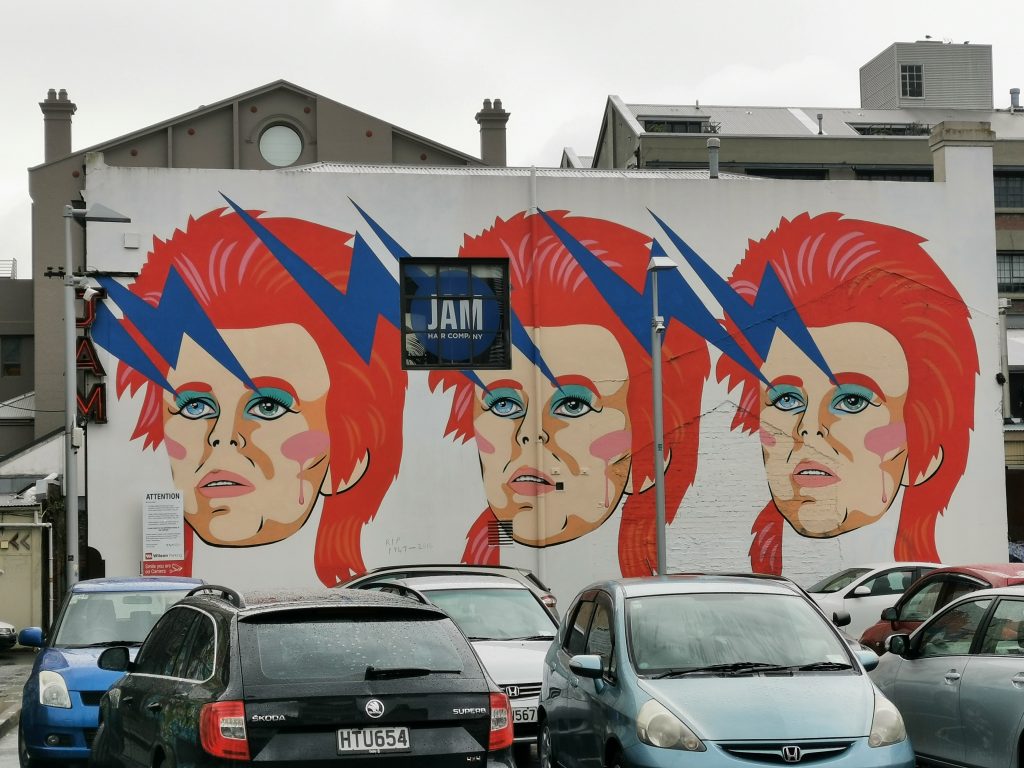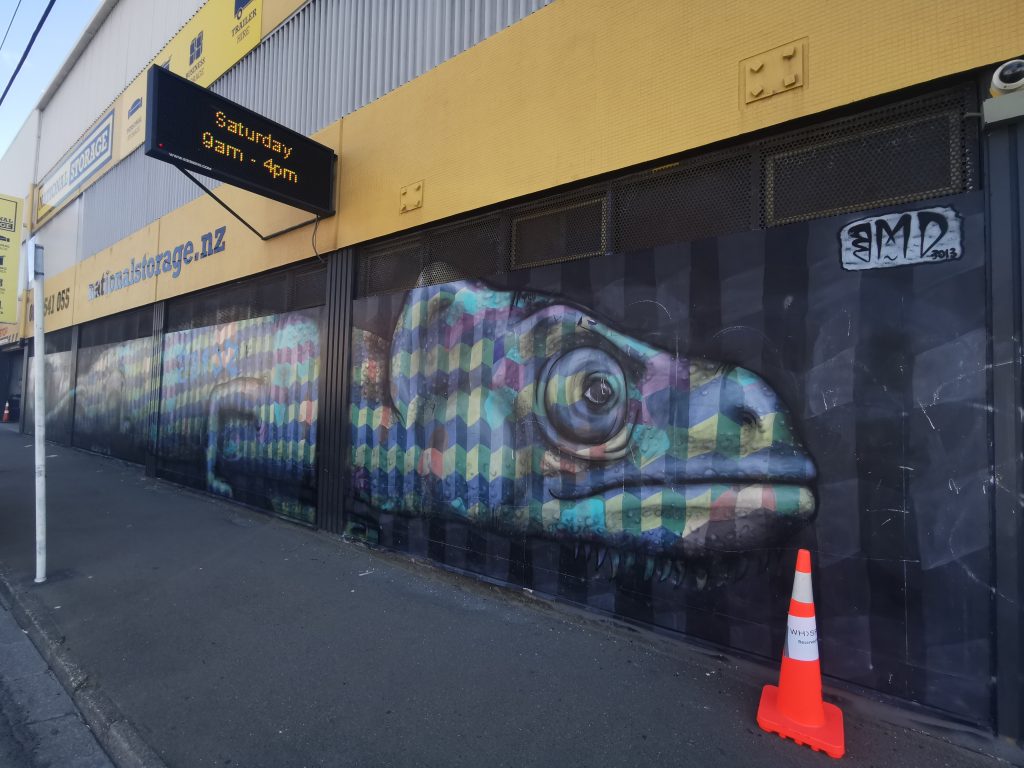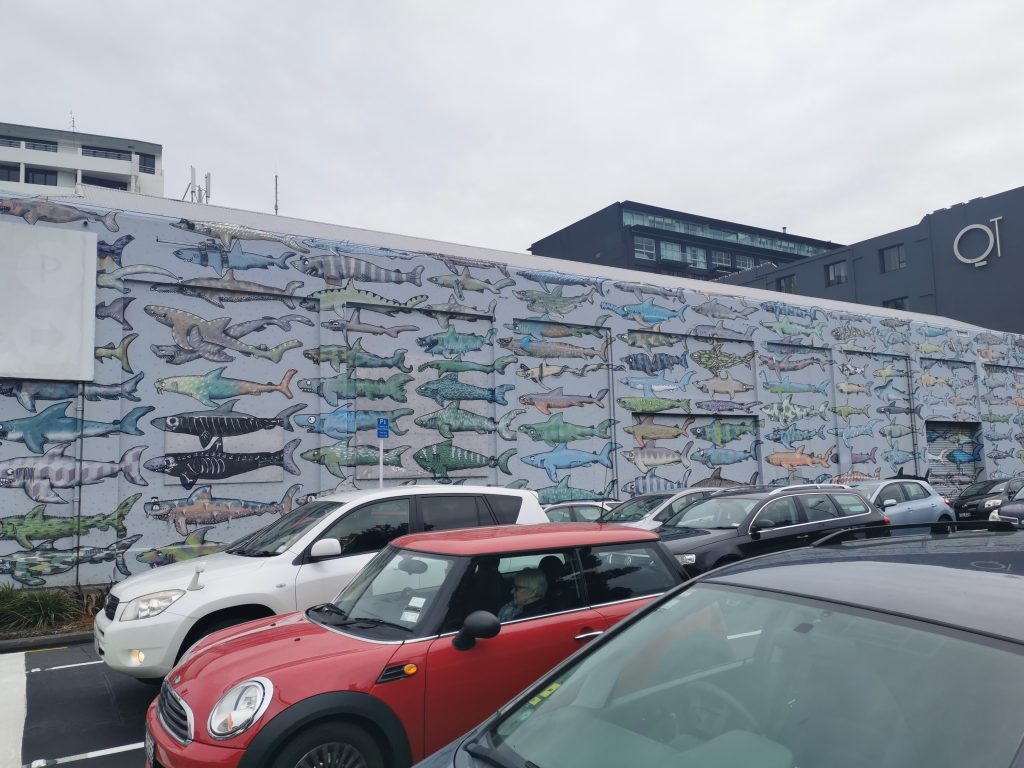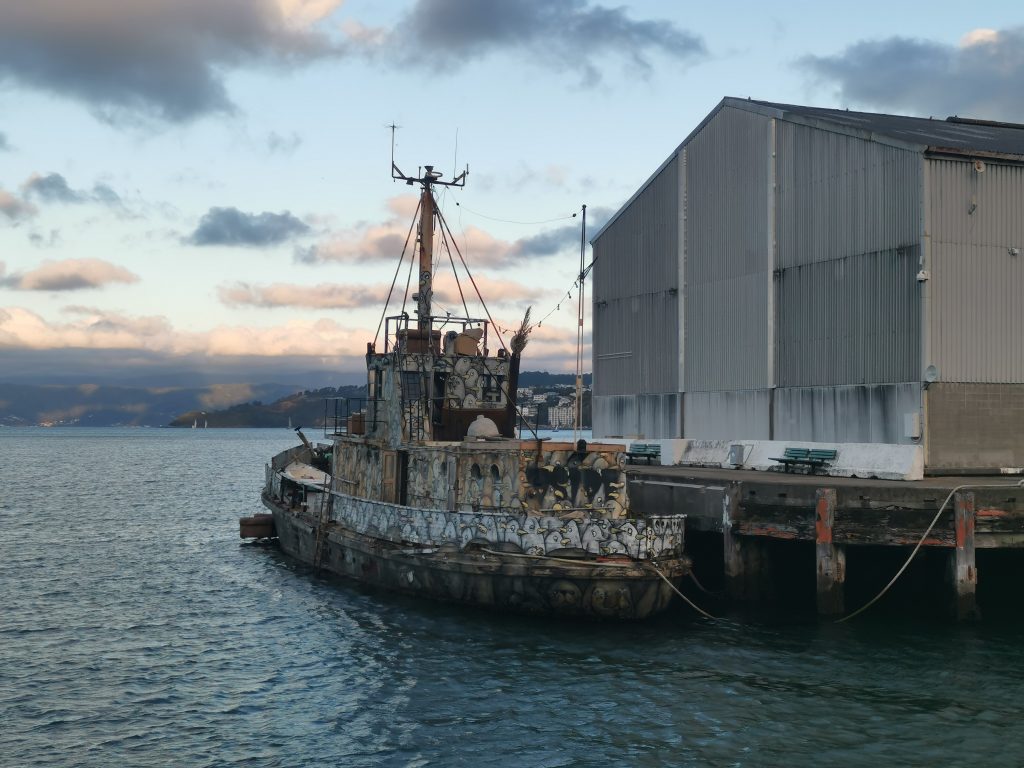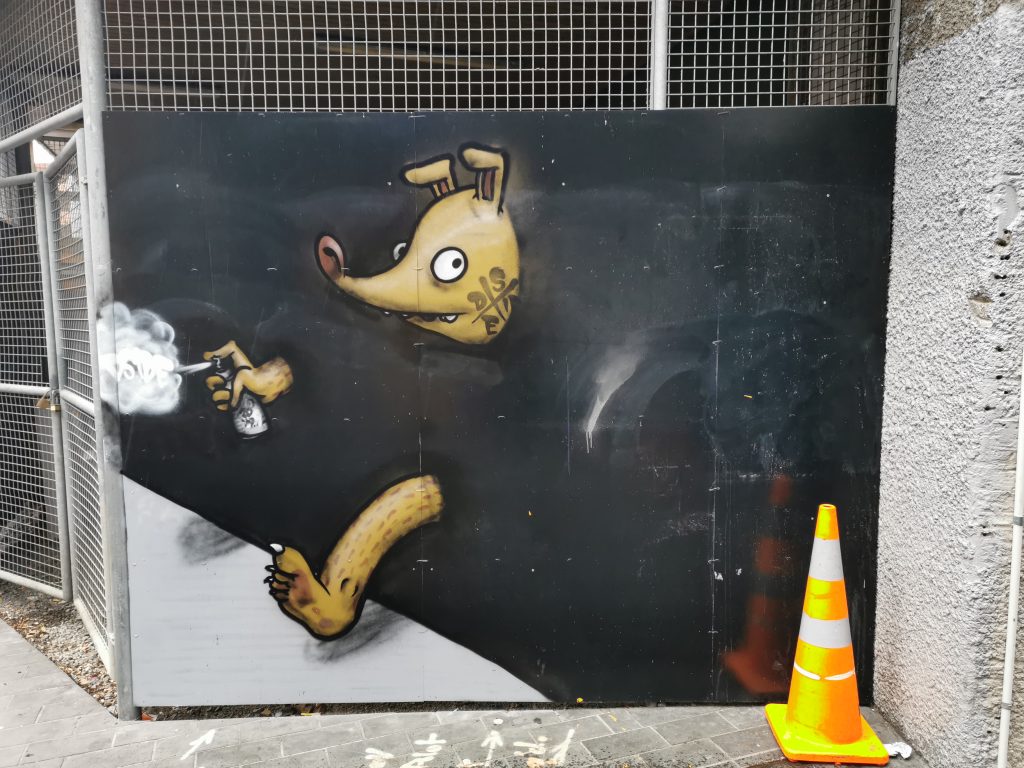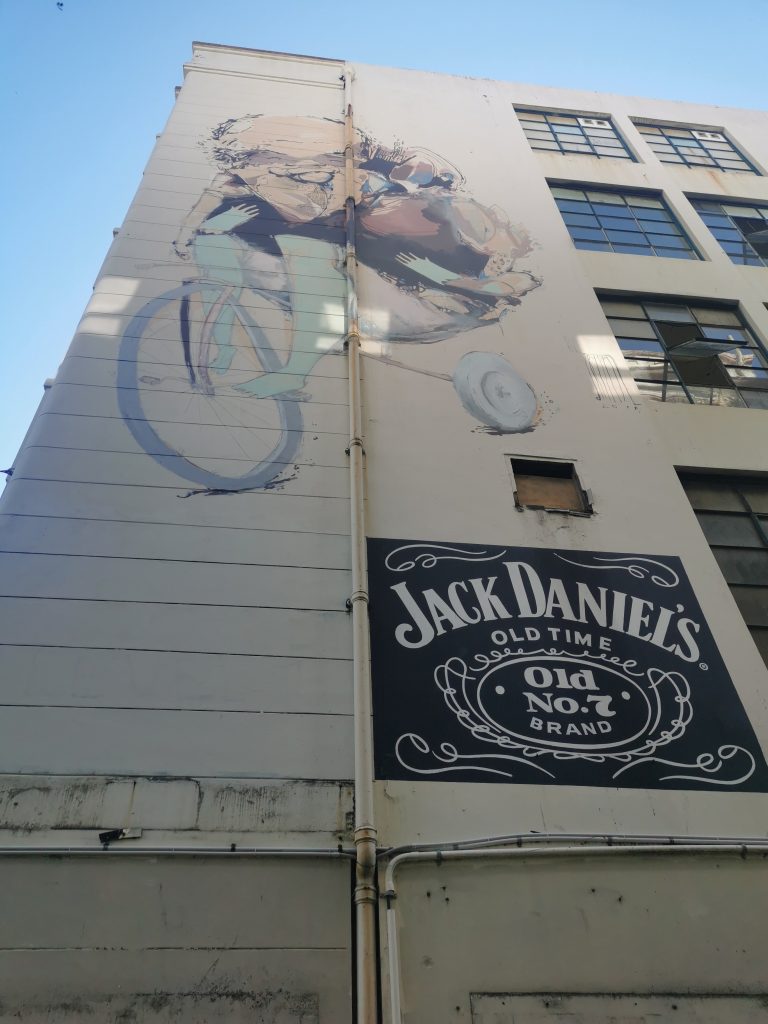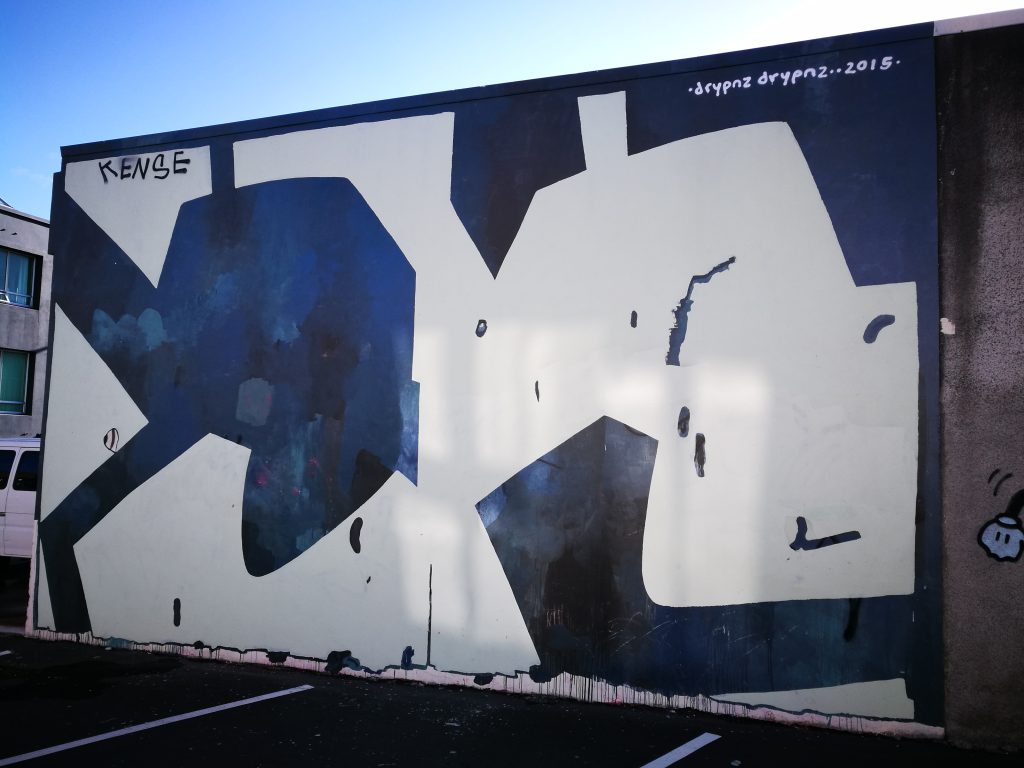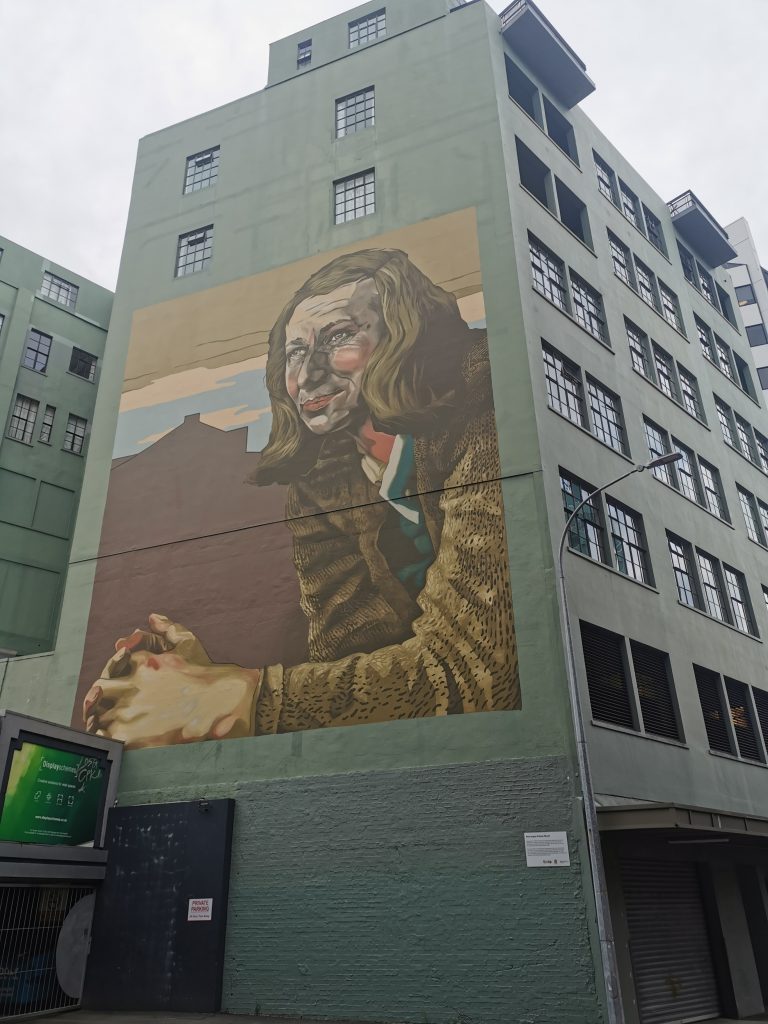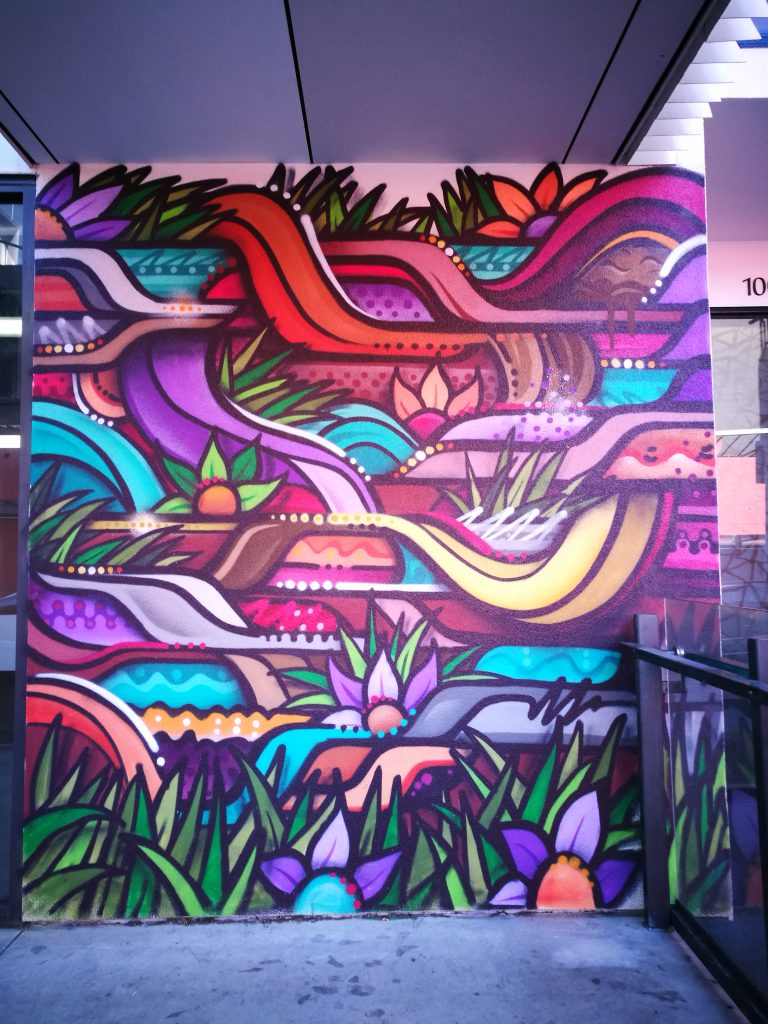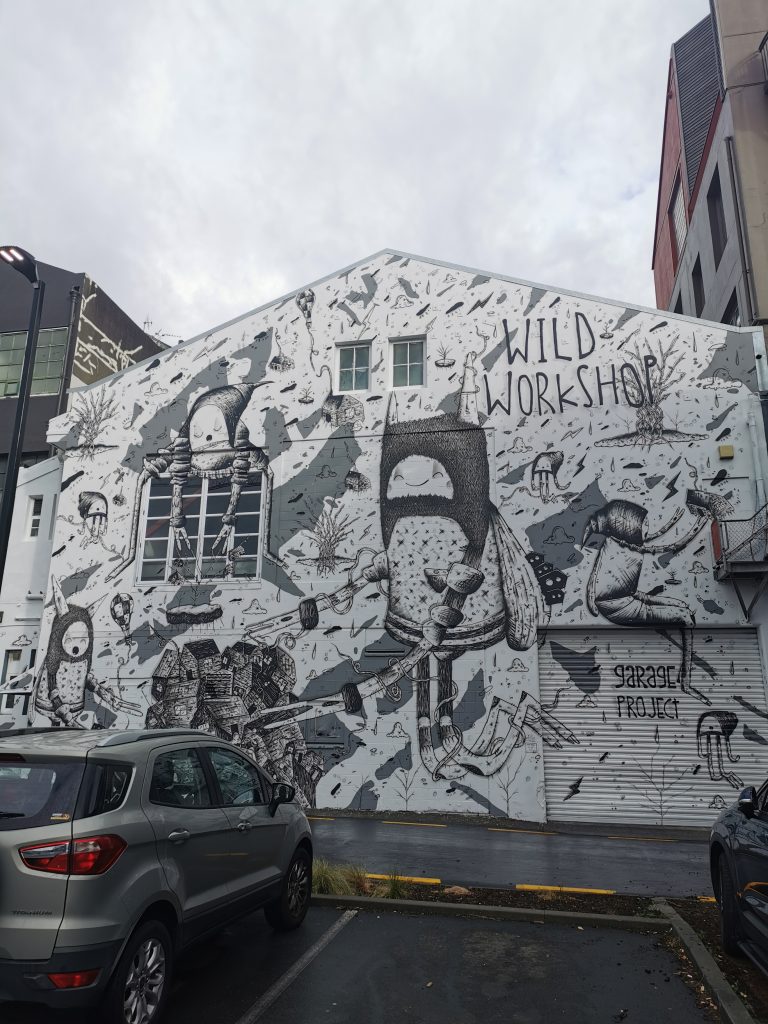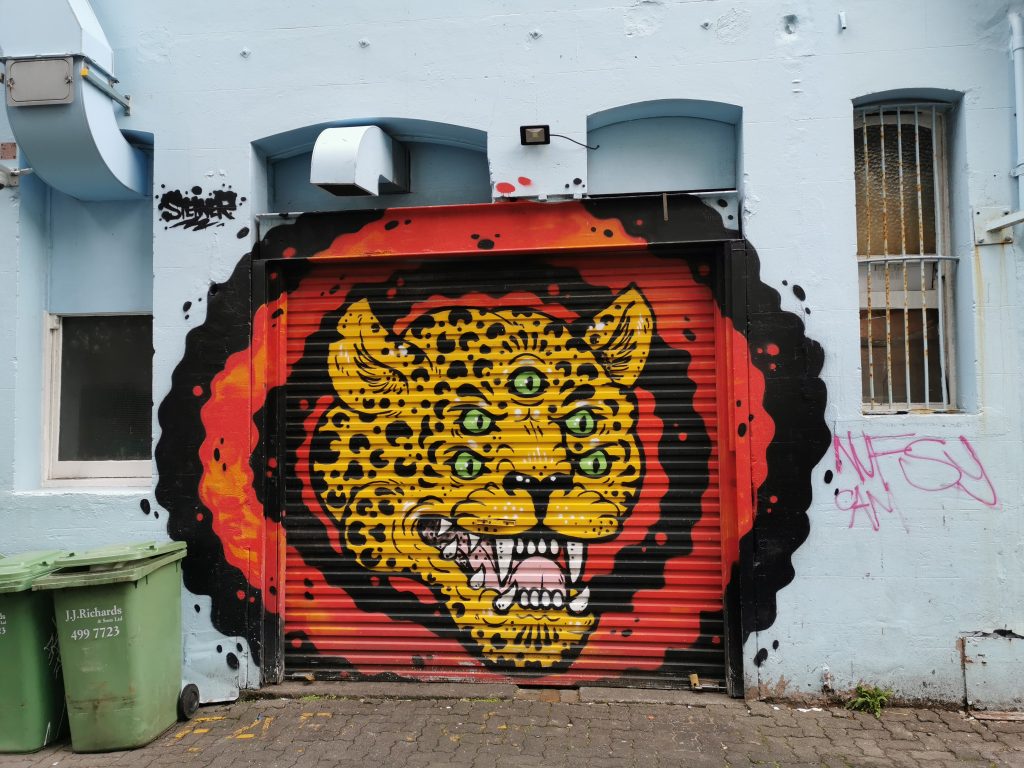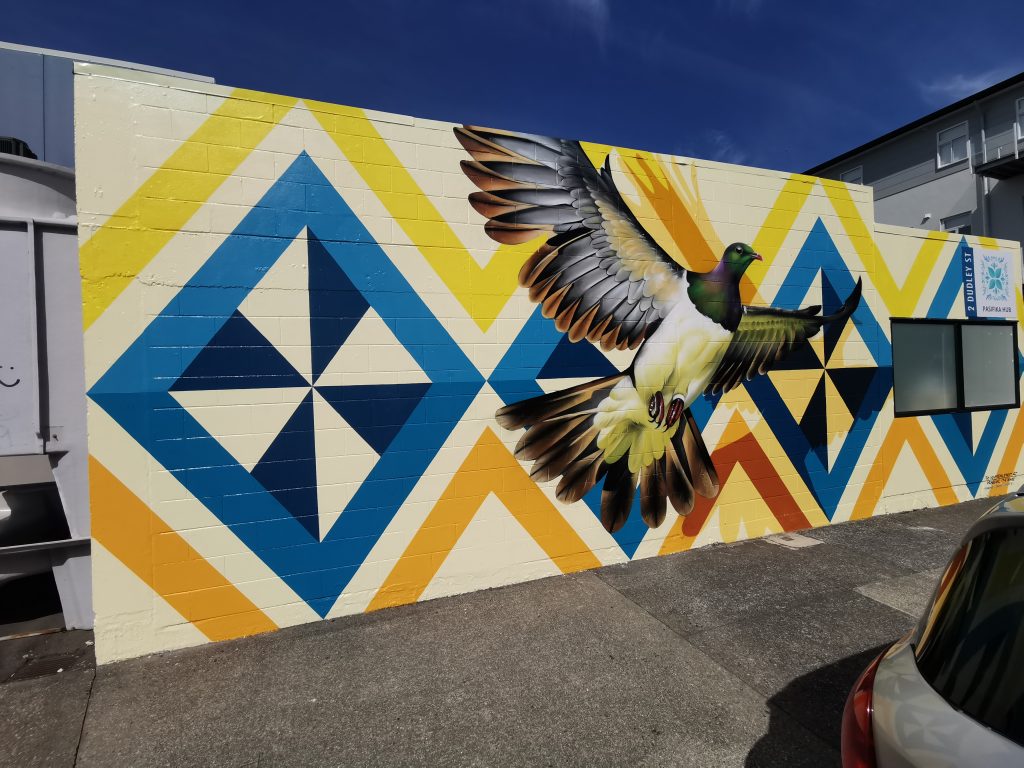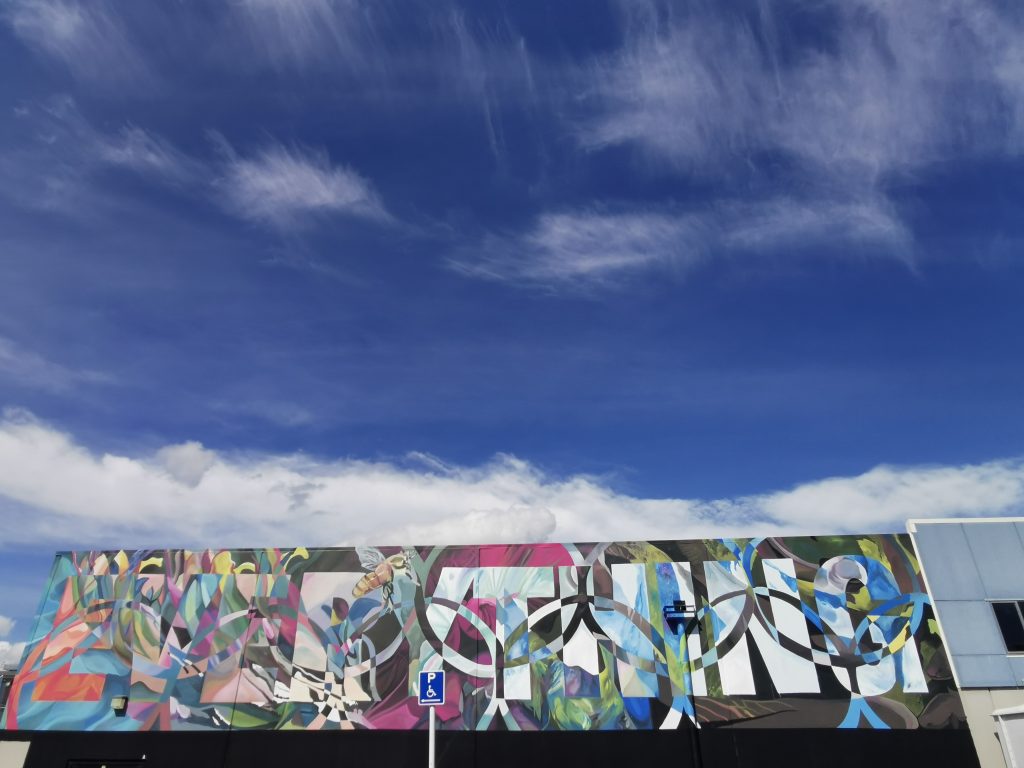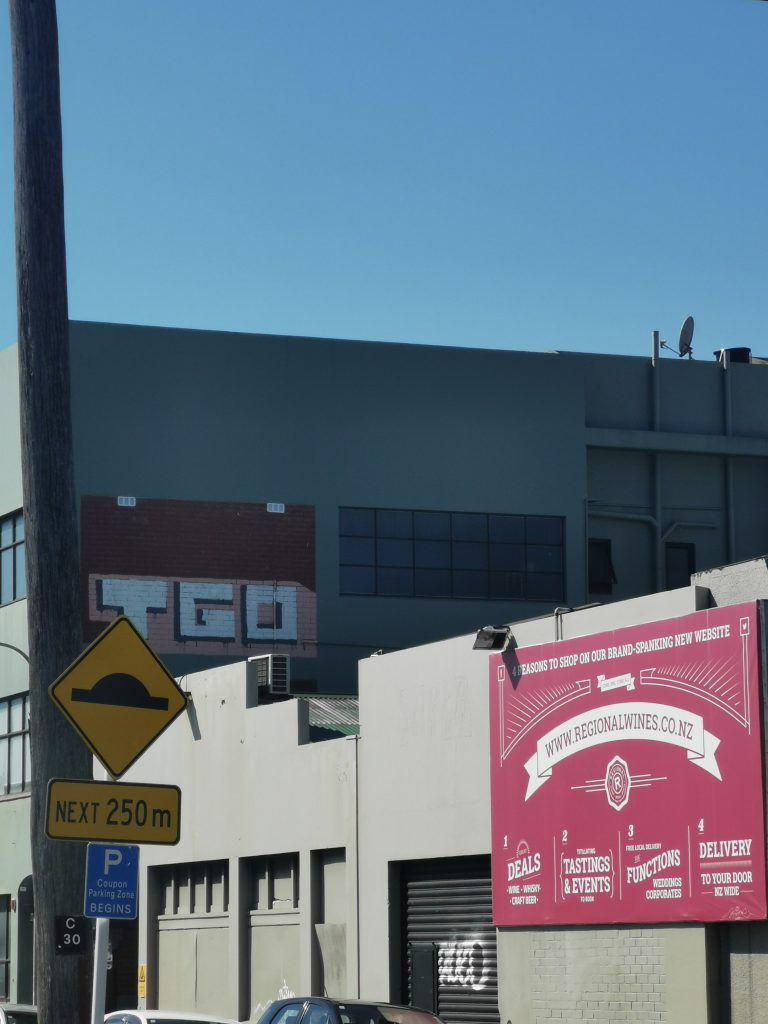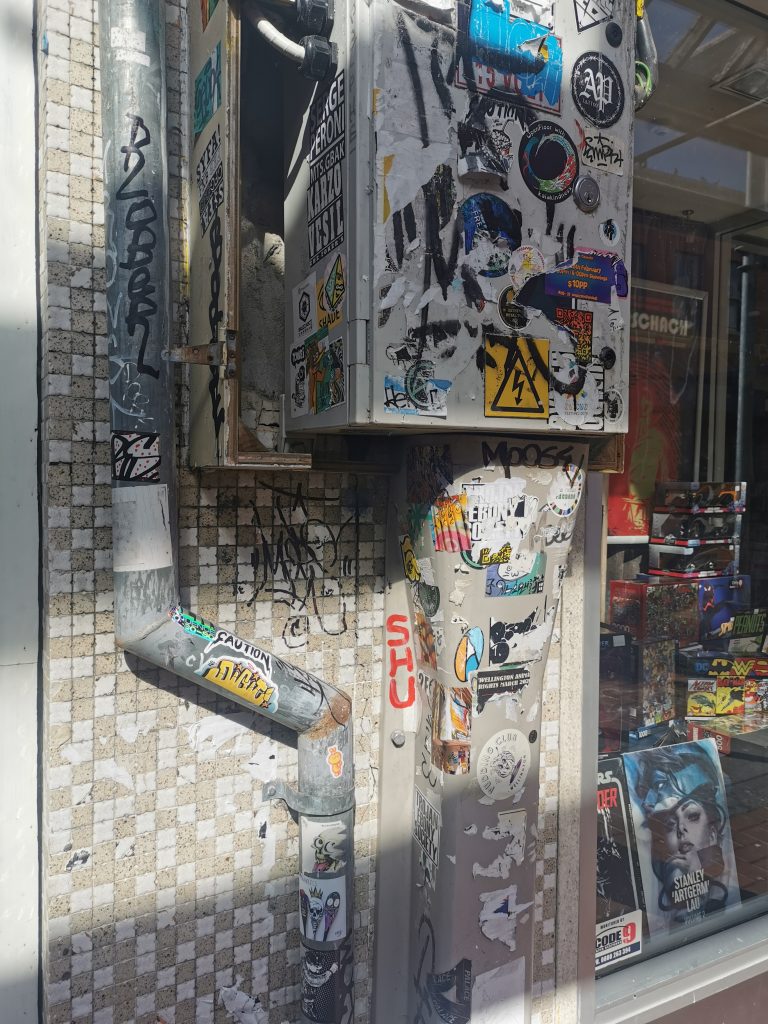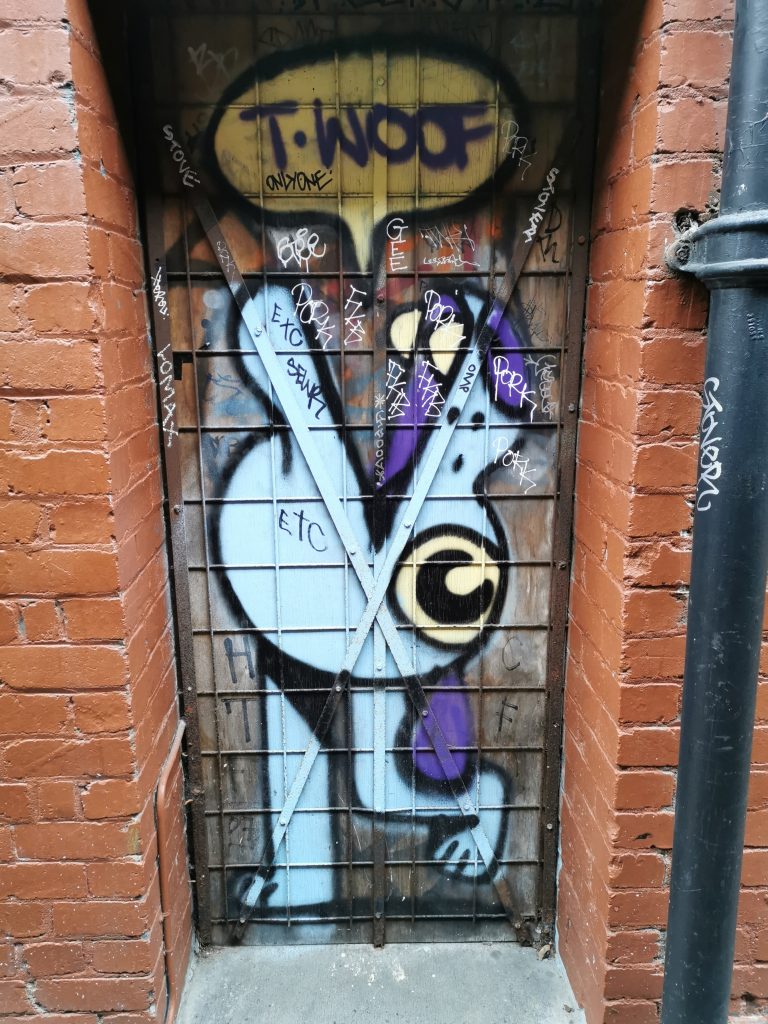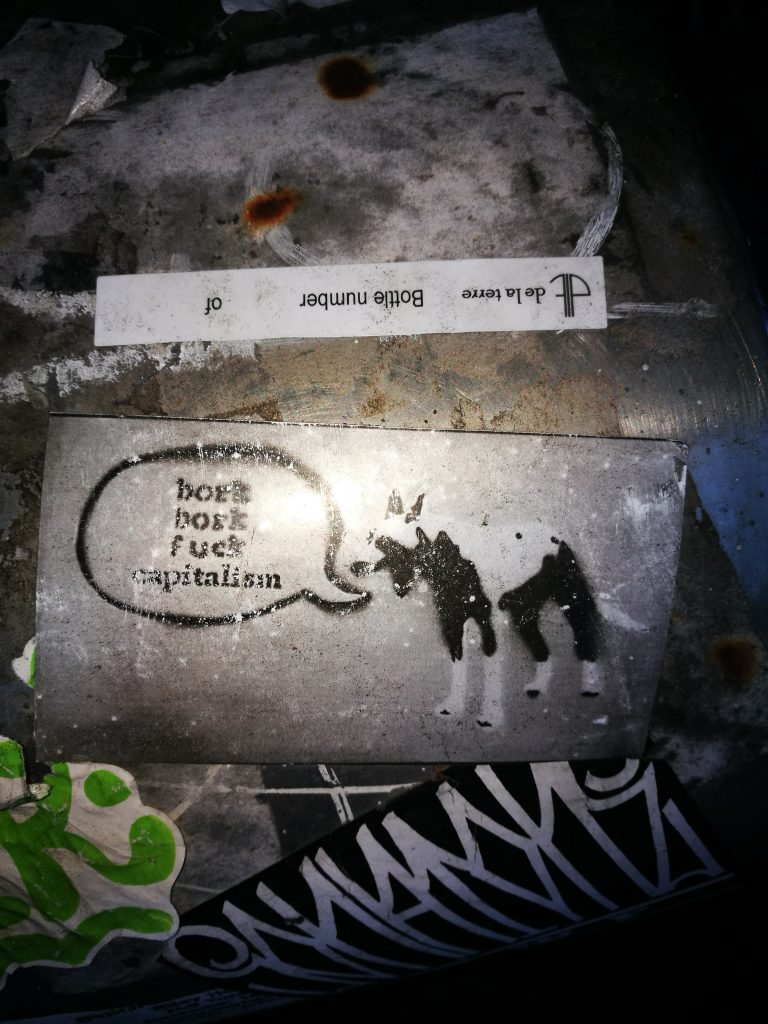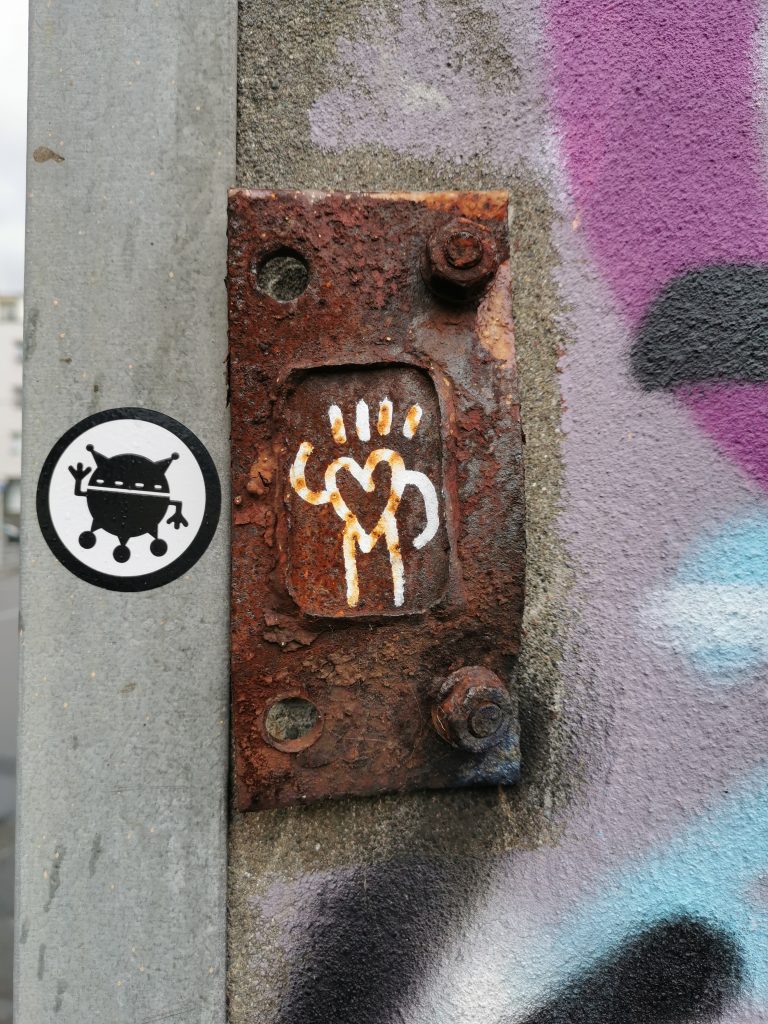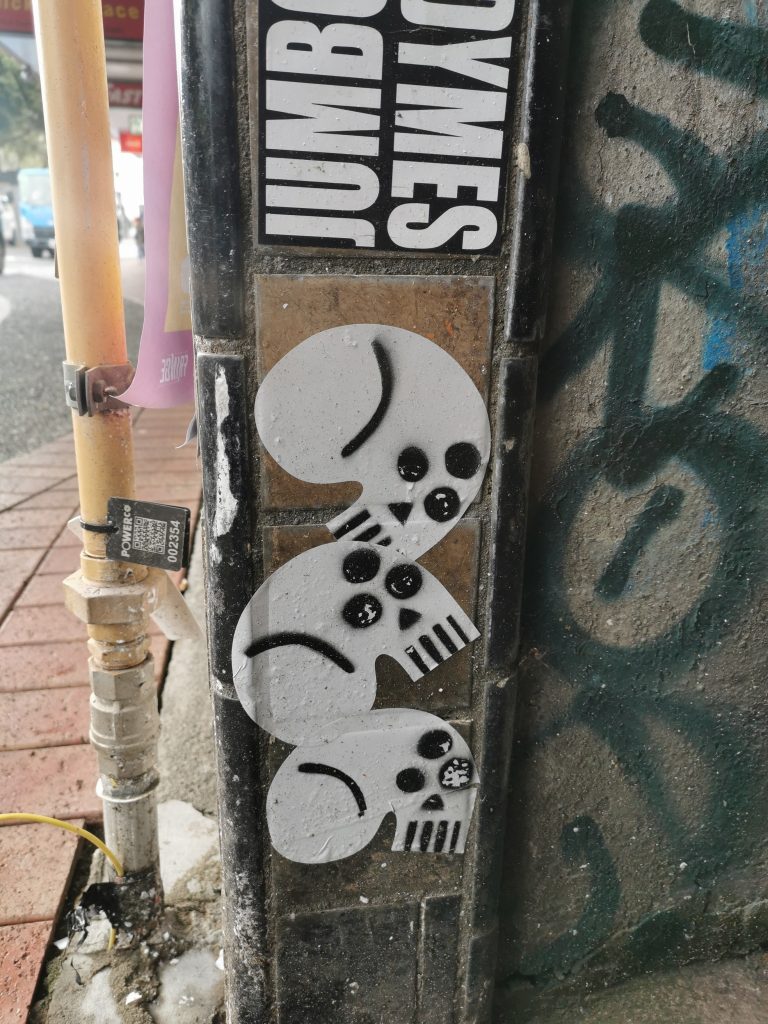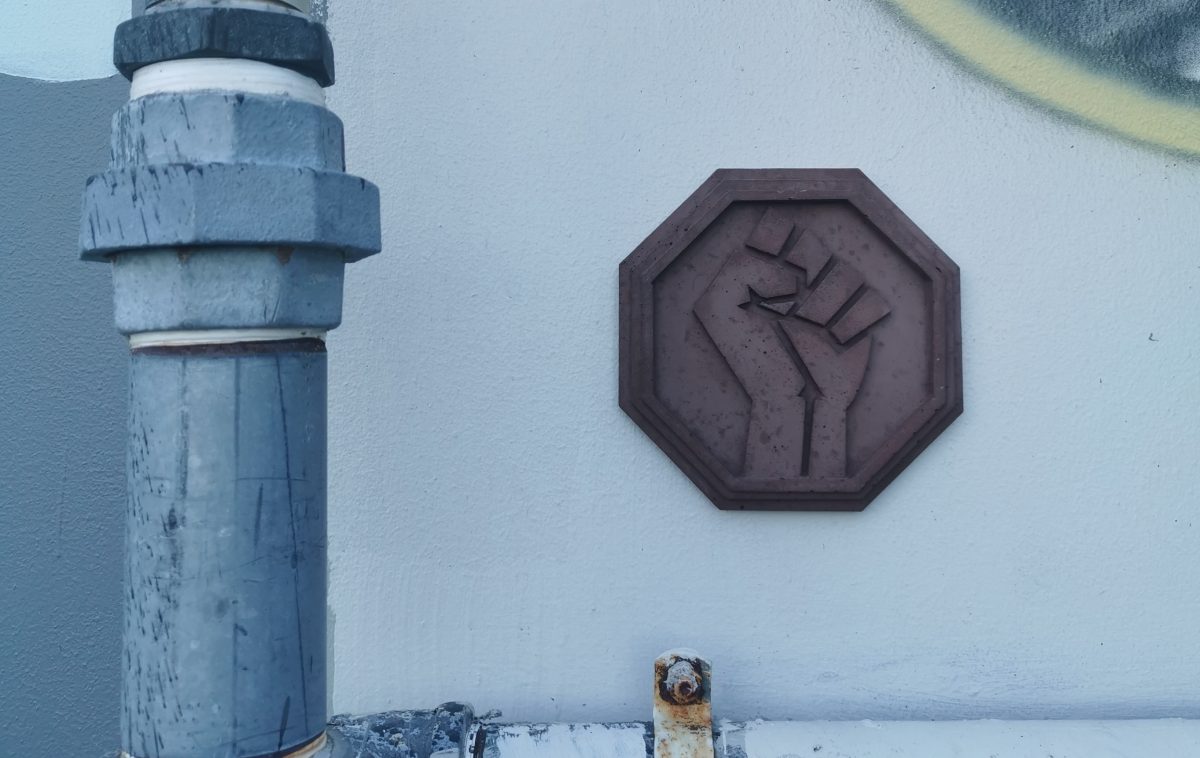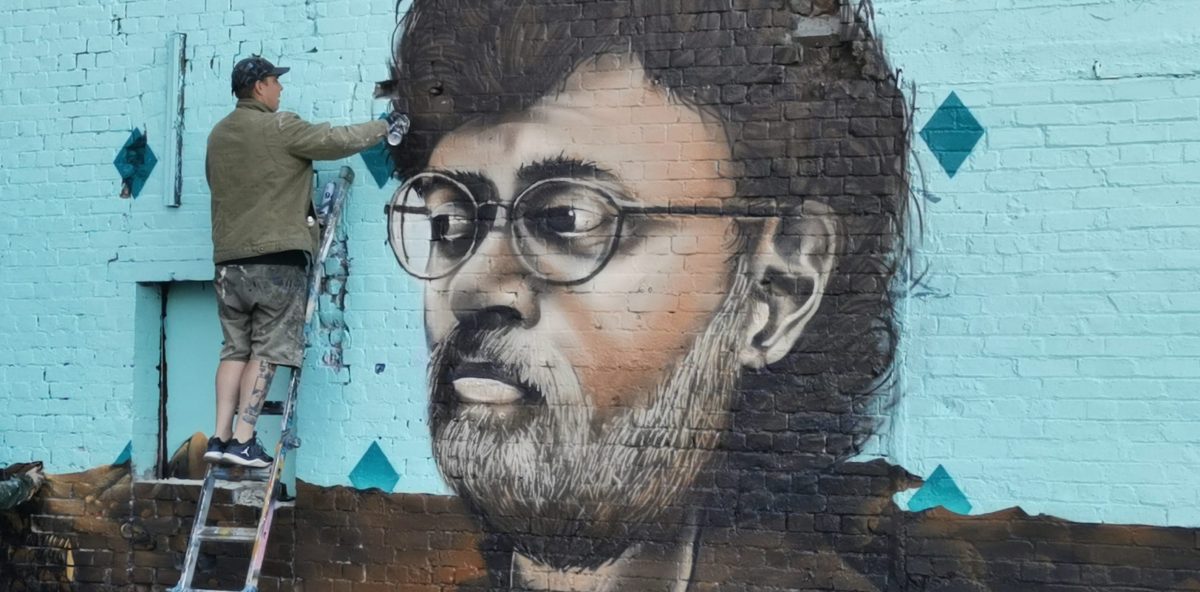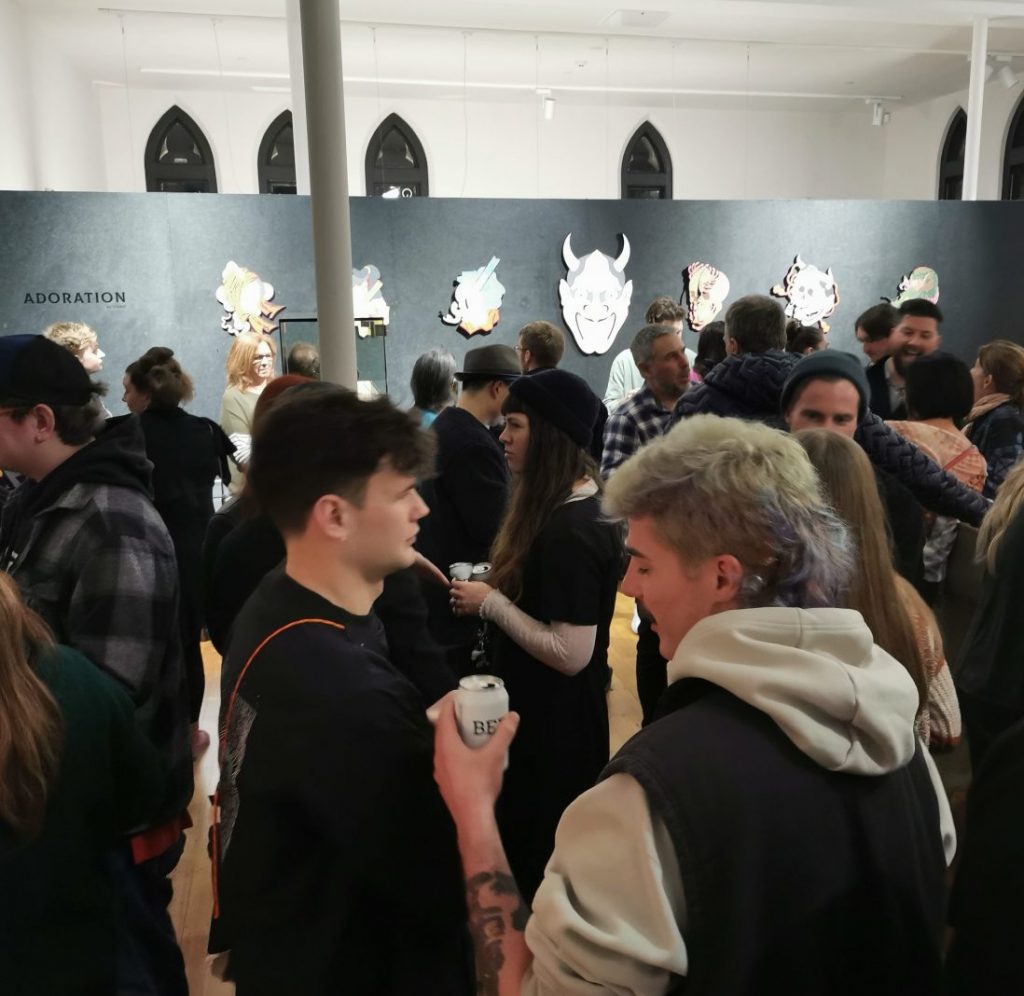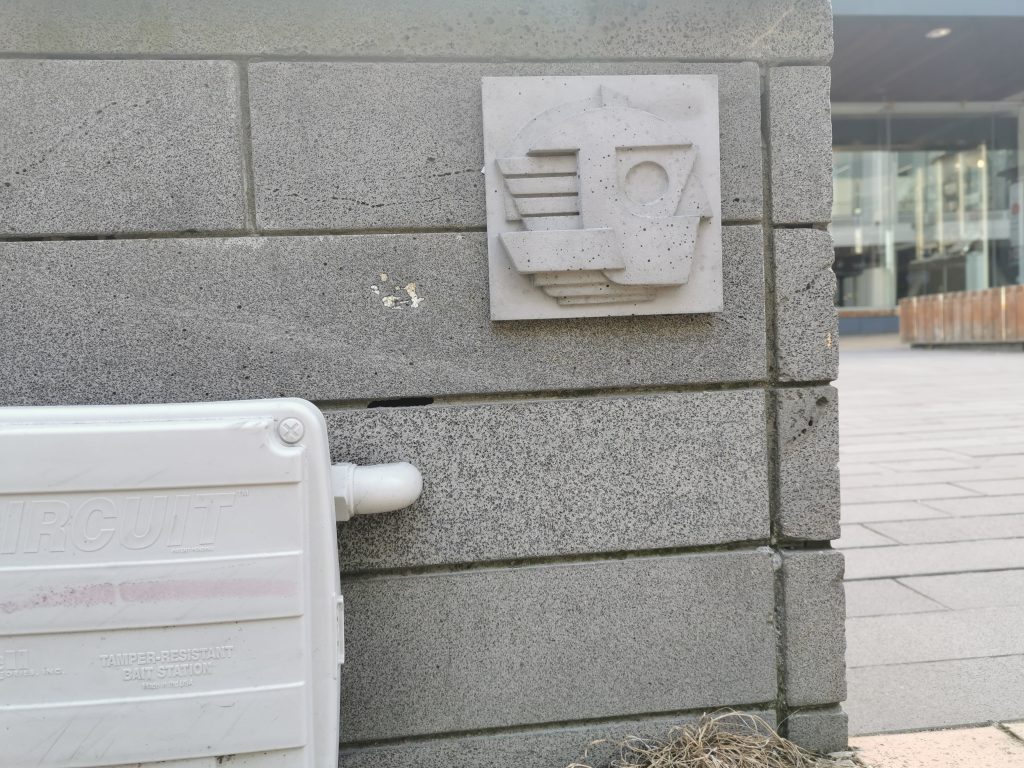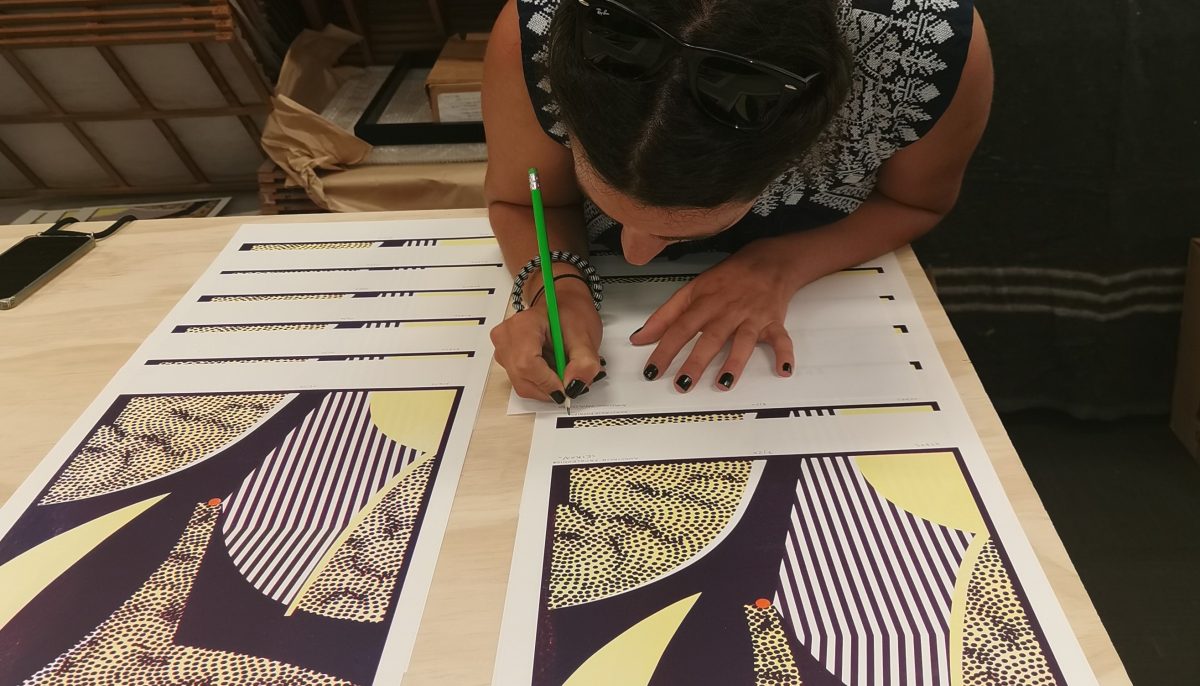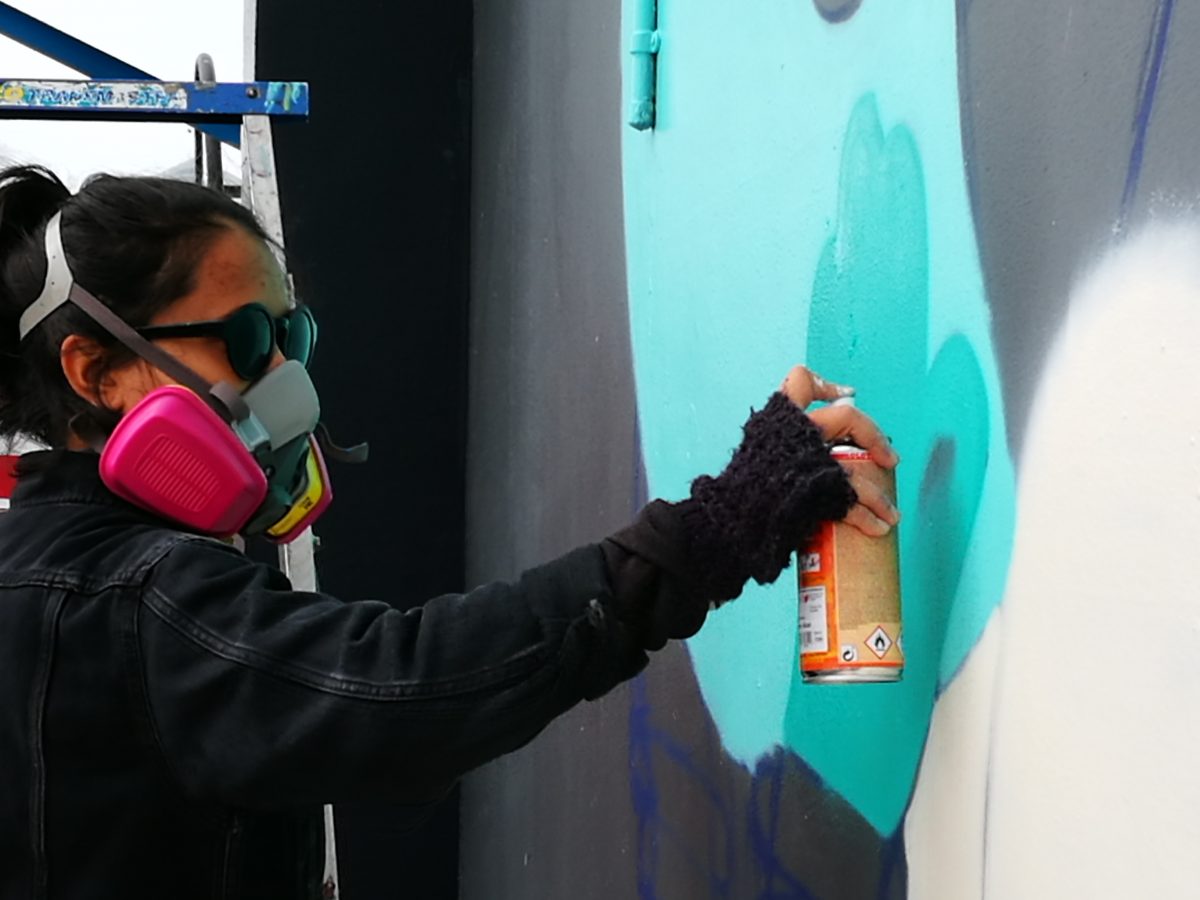Wellington. It’s a personal favourite. The capital city is perfect for an urban weekend away, with it’s cool bars, vibrant street life and innumerable cafes for mornings after (personally, no trip to Wellington is complete without a breakfast burrito from Sweet Mother’s Kitchen). While Ōtautahi will always be home, a trip to Wellington always leaves me planning a return, looking for reasons to make my way back soon. The beauty of the city for me is that the main event (Wellington is a favourite gig venue personally) is supported so well by the city’s additional charms – I always take a day to simply wander, up and down Cuba Street, along the waterfront, up the hills, and in doing so, catch the urban art that marks its walls and alleys. From big murals by well-known local artists, to the array of smaller additions, Wellington’s urban art is always fun to explore and seems a good fit with the city’s lively profile and physical layout. From painted boats to schools of sharks, piles of skulls to bicycle rides, playful to meaningful, what follows is a postcard from Wellington’s streets!
Tag: murals
And That Was… 2020
2020. Sigh. I still remember the first day of 2020, the sun was an ominously fiery orb in a grey sky, the result of the marauding bush fires in Australia. There were intriguing stories of a virus outbreak in China. There were rumblings of an escalating conflict between the U.S. and Iran. Let’s just say the markers were there.
2020 just continually threw curveballs. While we spent a lot more time at home (and for some legitimately feared the supermarket), faced massive uncertainty around our futures, and watched the insanity of the U.S. political system play out (t.b.c…) while death counts and infection rates continued to spiral and spike, it is important to look for positives amongst the icebergs, like the vital discourses arising from the Black Lives Matter movement, or our embrace of new avenues to enjoy the things that seemed so far away for much of 2020 (online exhibitions and concerts, and personally, Josh Gad’s Reunited Apart series, where the casts of Back to the Future, Ferris Bueller’s Day Off and The Goonies got back together via Zoom). Good or bad, the effects of 2020 (which themselves extend back far further than those 12 months) will linger far longer, surely influencing our behaviour and output in untold ways, from the way we make art to the institutions that police our communities. Indeed, the relative sense of calm normality here in Godzone is a far cry from distant shores, where 2021 is already following an equally hectic path…
With that reflection in mind, we once again reached out to a heap of our friends to look back over the last twelve months and how their year played out. We asked each contributor five questions; the changes they faced in 2020, their lockdown experience, their creative highlights and the art that mattered in 2020, and their contingency plans for 2021…
Here’s what some of our favourite Christchurch creatives made of 2020…
Jenna Ingram (@jen_heads, @fiksate_gallery)

What changes did 2020 bring for you personally? The biggest change for me personally was a new focus and direction within my Jen Head works, which came about through a friend’s request for a birthday card, that I then developed further over lockdown, and it’s just carried on. It has been a sort of ‘ah-ha’ moment. I’m loving this direction, it’s more simplified and has focus, but with endless options to explore, and best of all, it has been well received. I’m enjoying doing personalised commissions at the moment. I’m loving painting realism again and when combined with the abstract character of my Jen Heads, it creates impact.
The biggest change for Fiksate, is packing up and moving to a new location. It has been a stressful few months, but I’m super excited about the new space, it’s a warehouse style spot [54 Hawdon Street, Sydenham] and we can’t wait to start fresh in the new year.
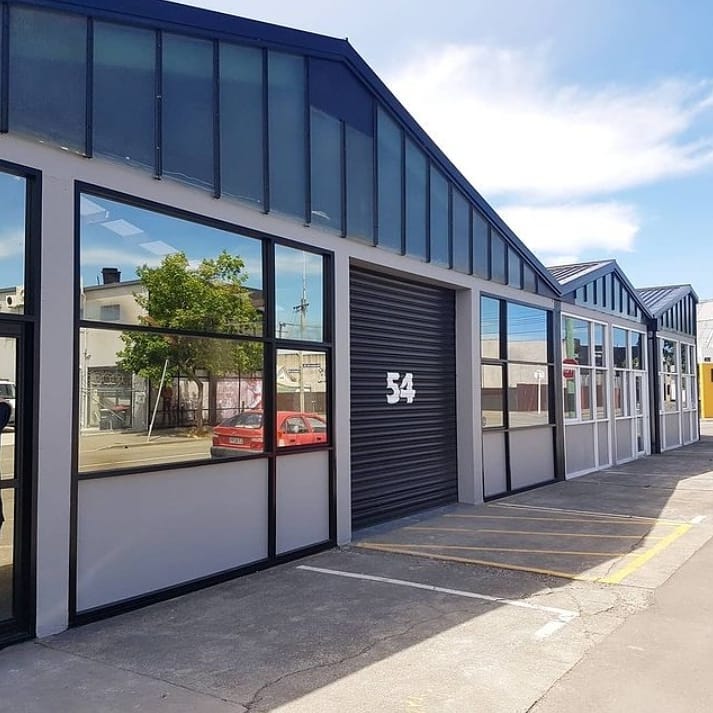
What got you through lockdown? The fact my three-year-old son, Frank, still takes naps got me through! I could count on those two or three hours for my alone time, to create artwork, to have some space. We packed up a lot of studio material and made a desk space in our spare room during lockdown. It was a godsend. Dr Suits [Jen’s husband and Fiksate co-owner] was working at a large scale in the backyard, but I enjoyed sitting and really focusing. I wrote and illustrated a children’s book, developed my Jen Heads and played with patterns and ideas.
Dr Suits was a massive support and did all the supermarket shopping, but there was never enough beer! Our neighbours were amazing and the North Beach crew in general, we could keep in touch through the fences or distanced walks. Facebook video calls daily with my Mum/Frank’s Nana were also helpful!
What has been your personal artistic/creative highlight of 2020? The start of the year was a banger with the Ōrua Paeroa mural in New Brighton. I was able to take part in Shared Lines, an exhibition curated and organised by Audrey Baldwin and colleagues [Now displayed in the new Spark building on the corner of Hereford and Colombo Streets]. I took part in the Conscious Club’s SDG Exhibition, which was amazing. I also organised Perspective – Women in Urban Art, a line-up full of top female urban artists in New Zealand, as well as international graffiti artist Glam. Perspective was super special, we produced a zine to accompany the exhibition which included amazing insights into the creative backstories, challenges, and successes of the artists. Dr. Suits, Porta and I also completed a large mural at Switch New Brighton. It was really fun, and it felt good to bring colour to our neighbourhood.

What pieces of art or cultural events, local or international, caught your eye and which do you think will define 2020? This question is too hard! There are too many in my mind to list!
What are your plans if 2021 turns out worse than 2020? My plan for 2021, if it turns out worse than 2020, is to focus on what brings me and my family joy, from the small things in my daily, to bigger actions, like giving and sharing. To really focus on nature and getting out there and into it. I’ll try not to ‘stress drink’ as much as I did throughout this year, haha!
Kophie Hulsbosch / Meep One (@kophie_loaf, @future_nz, @the.conscious.club)
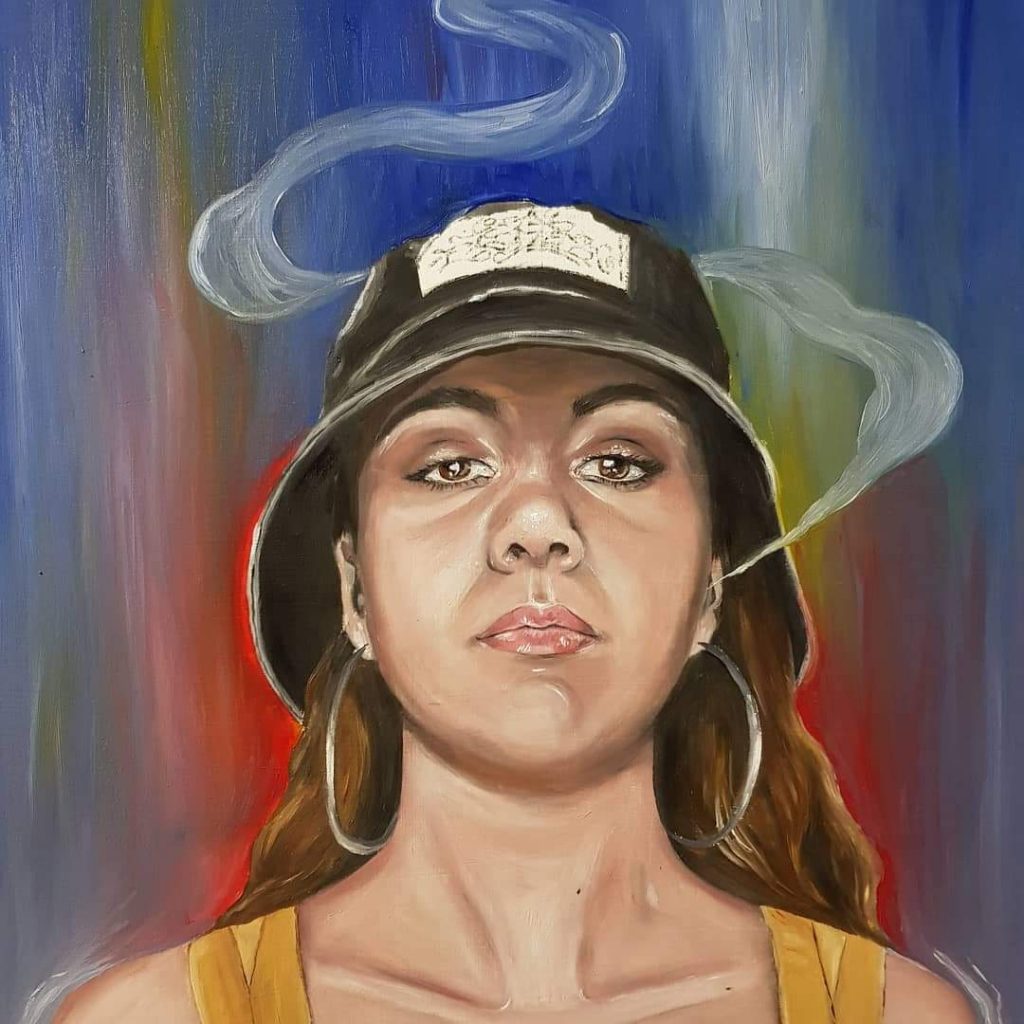
What changes did 2020 bring for you personally? At the start of the year I had secured a massive job, I was really excited as it would have been one of my biggest murals yet, but unfortunately due to Covid-19 and the economic recession, the client had to cancel which sucked! So that was my first realisation how serious the pandemic would be for the rest of the year being self-employed. But besides that, I had a relatively steady year in my art/design business, it got pretty scary there for a bit but the Government and CreativeNZ really pulled through for self-employed creatives, which I am very grateful for. Other than that, I have had a HUGE rise this year of people asking me for free or cheap work which really fucks me off. My other business that I co-own, The Conscious Club, definitely struggled as we mainly host events, but we managed to keep going and pulled through together in these rough times. We even got a studio/retail space in town which is pretty awesome.
What got you through lockdown? My partner and I live together, and he had been going full conspiracy mode since the start of January as our friend was over in Hong Kong and telling us how crazy the pandemic was and that it could come to New Zealand. So, by the time it got here we were quite prepared but still pretty freaked out. We both used the time to be creative. I still had work I could do from home, and my partner was making a hip-hop album. The only downside was both our studios were in the same room, so it was pretty loud and distracting. Other than that, we went on lots of walks with the dog and lots of Zoom calls with mates. It wasn’t too bad apart from when you had to go to the supermarket!
What has been your personal artistic/creative highlight of 2020? I have been in a lot more exhibitions this year which has been cool, and I also curated a massive exhibition fundraising and bringing awareness to the UN’s Sustainable Development Goals [SDGs]. Also, I have been working with a really cool producer from the UK doing album covers for some big names in hip-hop. Also, the Risograph print run with Fiksate and M/K Press was really cool. That’s all I can remember, I think I have blacked out a lot of this year, haha…

What pieces of art or cultural events, local or international, caught your eye and which do you think will define 2020? I think the anti-racism movement is a huge part of 2020 and from my experience there are a lot of people that are becoming more aware of racism and what it looks like and what people of colour go through every day. I still feel like there is a big divide, and I can see the opposite where there are a lot of people pushing back on the movement too. Getting in amongst it all can be pretty intense and overwhelming sometimes to say the least. This year me and my friends started a campaign called Stand The Fuck Up, sharing the story of our friend who was racially attacked at a party and ended up on the news. We have an event surrounding this planned for 2021 to continue the conversation.
What are your plans if 2021 turns out worse than 2020? Hmm, I think I’ll probably head for the bush, I can’t take much more!
P.K. (graffiti writer, photographer)
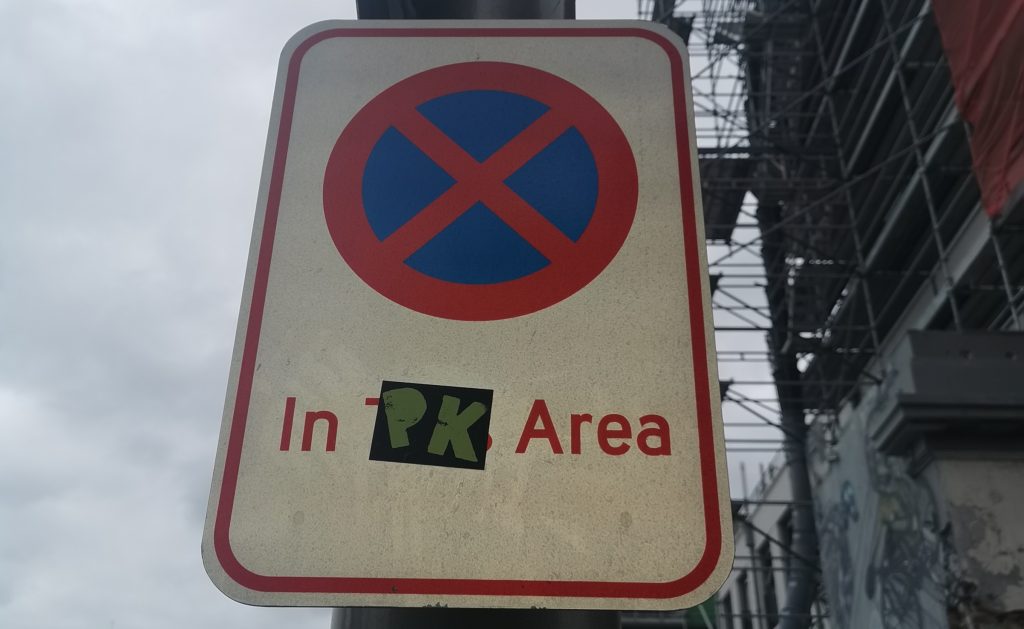
What changes did 2020 bring for you personally? This year I moved to a new house, where I can have an actual studio space, which has given me the opportunity to experiment with more things and be closer to the city than I was back at my old place.
What got you through lockdown? Once I figured out it was chill to leave the house without getting stopped in the street, I had a great time in lockdown. I really enjoyed going for long walks and bike rides while it was quiet. The cleaner air was awesome! Although I do feel it has made me even more reclusive than I was before lockdown happened. I’m still not very used to being in situations with lots of people even months after it.
What has been your personal artistic/creative highlight of 2020? Something that stands out in my memory of 2020 is the group show A Tribe Called Haz put on at Outsiders, Haz Called a Tribe, that I was fortunate to be a part of. It was really cool to see such a good and diverse selection of work from people who often don’t exhibit their creations publicly.
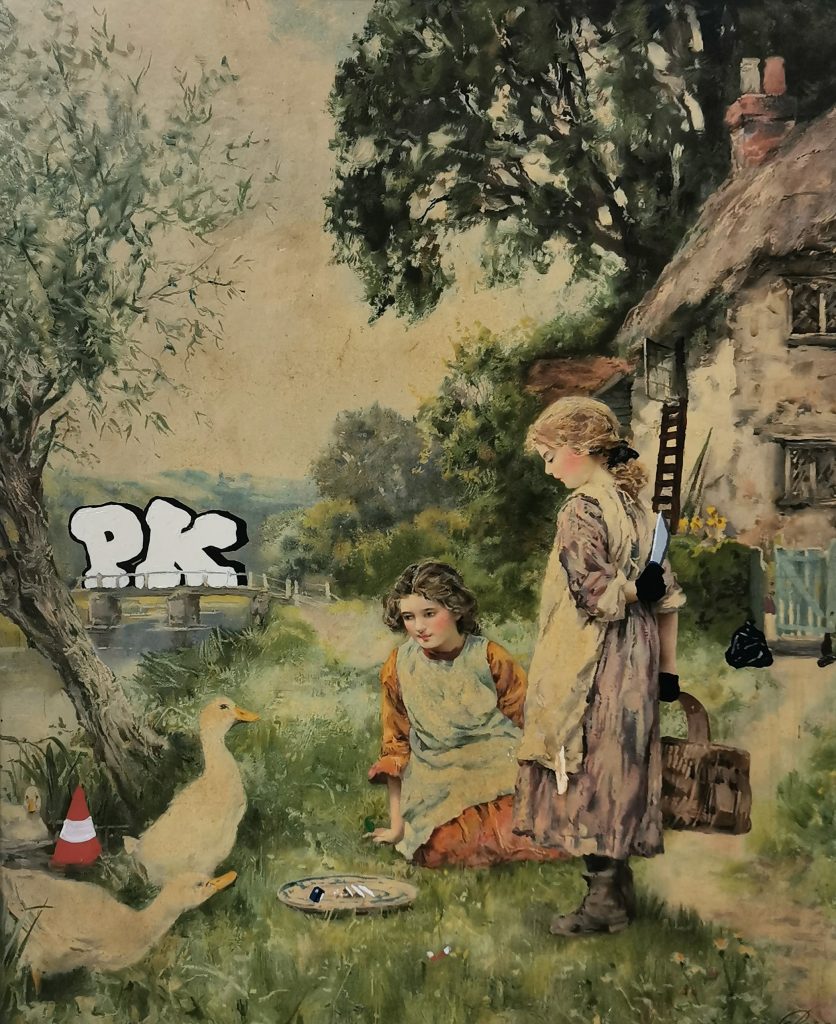
What pieces of art or cultural events, local or international, caught your eye and which do you think will define 2020? Props to Weks, Vesil and Dofey for winning graf, the Green Party for all their good work in parliament this year, and to everyone that’s dedicated their year to trying to make the world a better place.
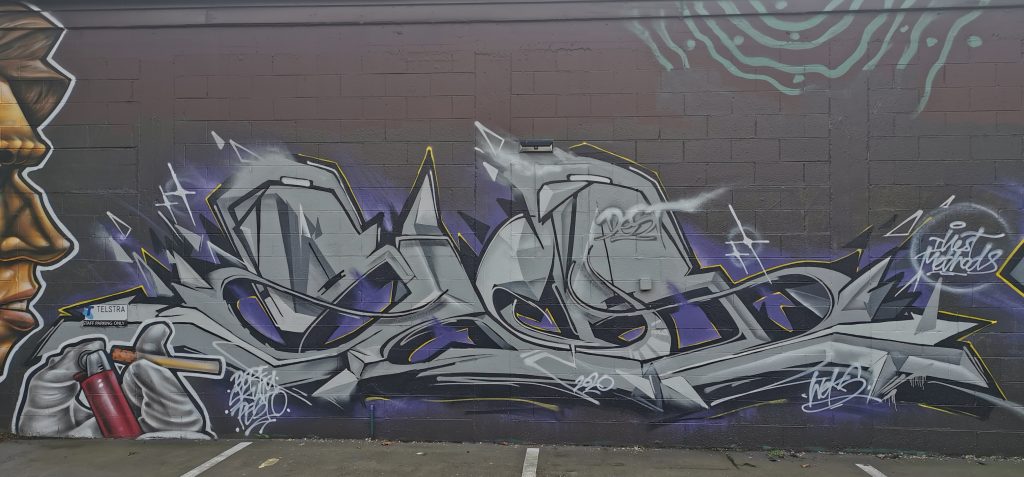
What are your plans if 2021 turns out worse than 2020? Never plan anything.
Ikarus (@highdoctornick)

What changes did 2020 bring for you personally? I’m anti-social as shit, so it didn’t affect me too much apart from delays on a couple of projects, haha. But most, if not all, of those already had funding secured so they were just postponed until after the initial lock down period. Isolation was tight: be lazy a.f. and don’t feel guilty about it, hahaha!
What got you through lockdown? I hang out with my girlfriend all day erry day anyway, so it wasn’t that much different. We did groceries like real adults for a change though and made more interesting dinners cos there was so much more time. I don’t remember if I even did any drawings or arts, but maybe I did…
What has been your personal artistic/creative highlight of 2020? It’d be a toss-up between the South Frame mural and the New Brighton Outdoor Art Festival production. Both were rad concepts and large walls that incorporated large amounts of traditional graffiti pieces and elements. Also, making some 3D diorama street scenes and other kinda sculpture related works was cool.

What pieces of art or cultural events, local or international, caught your eye and which do you think will define 2020? Honestly, I’m a bit of a savage and don’t really even look at or follow art or cultural shit. Fuck racists anyway, if you needed BLM to tell you that shit is fucked up out here, you’re a goddamn idiot. Was it even positive or just more divisive than ever? Weks and Pesto’s killer run during lockdown is my favourite art movement of 2020, hands down. Vesil and Dofey get the honourable mentions too, straight up crushing the city.
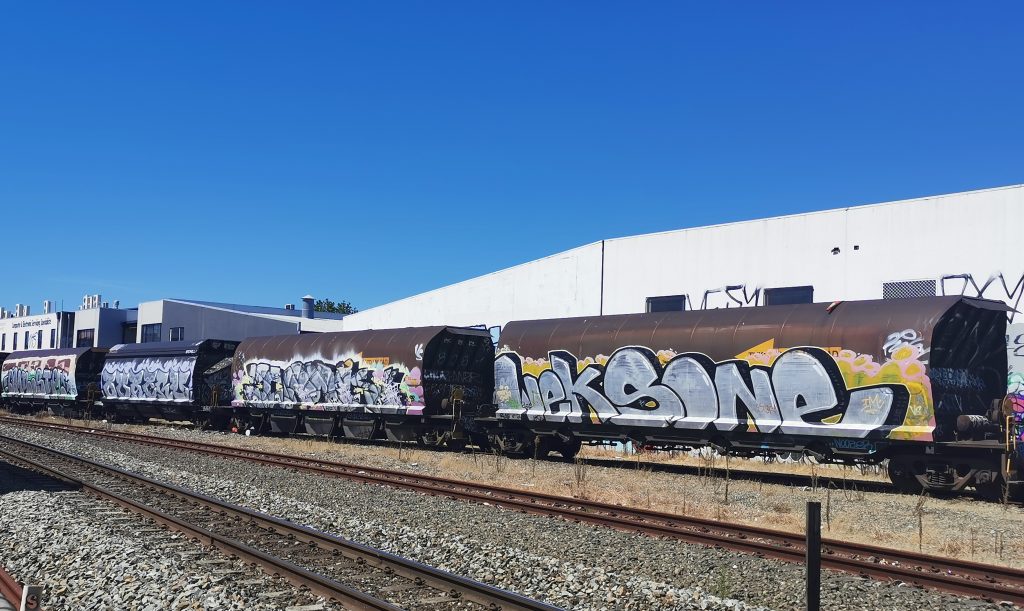
What are your plans if 2021 turns out worse than 2020? Keep doing my thing and watch the world burn down around me. I’m more afraid of meteors crashing into the earth than catching a cold. Realistically I’d be kinda keen for the planet to descend into complete chaos and anarchy, we’re too comfortable anyway…
Dcypher (@dcypher_dtrcbs)

What changes did 2020 bring for you personally? One of the biggest changes in 2020 for me involved experimenting in the studio during lock down, which was well overdue. But once the lockdowns were lifted work definitely picked back up pretty quickly. It felt like it almost gave people an extra drive to get new or pending projects underway.
What got you through lockdown? What got me through lockdown was painting canvases in the studio for sure, nothing serious just painting for therapy really. Obviously, friends and family definitely help in times like that as well. I have friends in the States who are still dealing with the whole problem and its endless ramifications. Just trying to be supportive for them in any way possible was and still is a focus of mine.
What has been your personal artistic/creative highlight of 2020? Some of my biggest and most complex projects to date have happened in 2020, so I can’t complain. All the big walls we’ve painted as a crew would have to be my personal favourites, from the Jungle tribute by the Moorhouse tracks, to the South Frame wall and the NBOAF seaside wall, to name a few.

What pieces of art or cultural events, local or international, caught your eye and which do you think will define 2020? For sure all the looting and rioting and peaceful protests that were attached to the Black Lives Matter movement. And all the street parties after Trump lost the election! America has had a real bi-polar year! I do feel 2020 was a super productive year for graffiti and street art internationally.
What are your plans if 2021 turns out worse than 2020? If 2021 is worse than 2020, I’m going to make the most of it in the studio and really try to produce a large body of work for a show in 2022!
Befaaany (@befaaany)
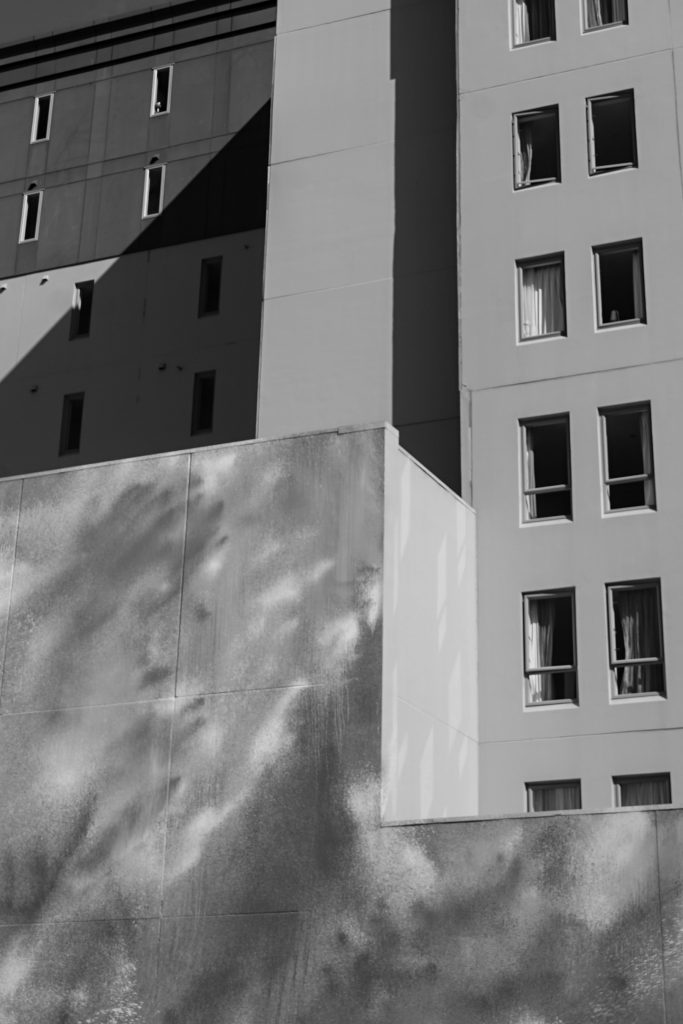
What changes did 2020 bring for you personally? My studies went fully online which just made me have a lot more control over time. I found myself able to relocate my study to evening where I was more productive anyway, and use my days to go out (while we weren’t in lock down). Everything that happened in 2020 gave me the opportunity to find my love for photography again.
What got you through lockdown? Netflix, routine, university studies, naps. Boring things mainly. I wish I could be one of those cool people who were super productive during that time.
What has been your personal artistic/creative highlight of 2020? Being part of the Perspective exhibition at Fiksate gallery. But also just learning how to set aside time for creative projects.
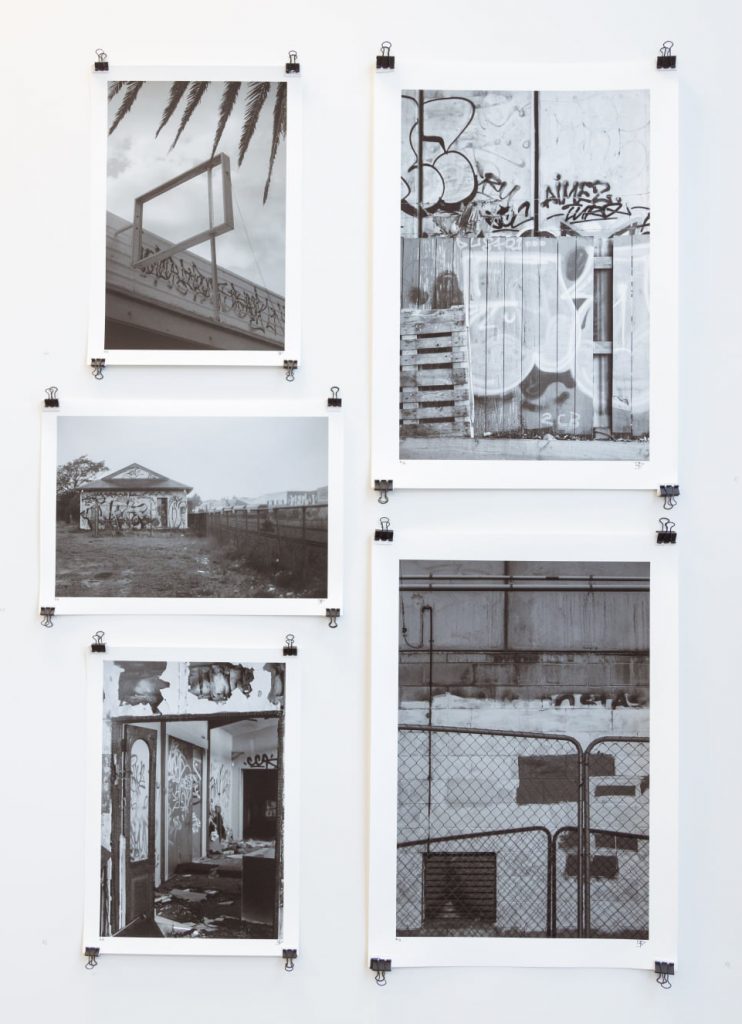
What pieces of art or cultural events, local or international, caught your eye and which do you think will define 2020? I think that celebrity Imagine cover captures 2020 pretty great. And if you wanna get more deep than just how shit it was, the reaction to it was a great example of people (maybe) starting to understand that different people in the same society have different experiences. Whether it’s black people vs white people’s experience with the cops or rich vs poor people with the pandemic.
What are your plans if 2021 turns out worse than 2020? More naps.
Teeth Like Screwdrivers (@teethlikescrewdrivers)

What changes did 2020 bring for you personally? I guess my biggest change was a steely determination to get out and put stuff up rather than take a photo for Instagram to show people what I had put up. I pretty much shut all my social media accounts at the start of the year and only restarted my sticker one when my #slapcitycollab started up. I am always on the cusp of shutting it all down. I’ve heard Flickr is making a comeback amongst sticker artists!
What got you through lockdown? Two things: A battery powered chainsaw and the #slapcitycollab (that eventually morphed into #slapcitymashup). I started doing a lockdown challenge, but the inspiration words were a bit ‘meh’, so I wrote out a list of artists I wanted to mashup/collab with my stuff and just started there. Then it turned into 20 days, then 40 days, then 60 days… A whole bunch of rad artists from all over the world got involved and some awesome collaborations came out of it. I was so hyped to see @awasgaga doing a huge Teeth Like Screwdrivers wall for his entry and getting a mashup sticker made with Ocky_bop was pretty epic!
Also, I have a nice garden now.
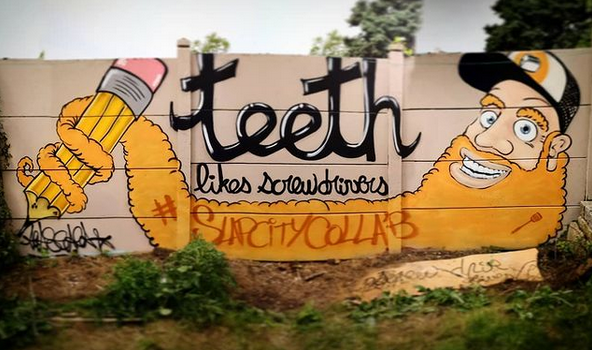
What has been your personal artistic/creative highlight of 2020? The Slap City Sticker Workshops at Fiksate have been huge for me. We started them at the end of last year and while they obviously stopped during lockdown, when we came out of all that it seemed even more important for us to get together and hang out. While the rest of the world dealt with Covid-19, we were able to sit, draw, chat, have a drink then go out into the street and sprinkle a bit of love around the city. We are fucking lucky, really. Slapcity family!
What pieces of art or cultural events, local or international, caught your eye and which do you think will define 2020? As I said, we are pretty damn lucky here in New Zealand to be able to host art shows, wander the streets and look at stuff and hang out together. Other places are not so lucky. So, my highlight this year happened right at the end in the good old US of A.
The DC Sticker Expo 5.0 was obviously not going to happen in real life this year, so they put the whole show on virtually. You can wander around the gallery and zoom in on stickers and pieces. They did a virtual treasure hunt and I have spent a fair bit of time just looking around. So good! (Keep your eye out for a couple of pencils in there!) Peel Magazine (which used to run in the early 2000s) started a new project after a decade or so: ‘Peel Magazine has a posse’. The basic premise was to design your own version of the classic ‘Andre The Giant has a posse’ sticker and get them all together in one book. Shepard Fairey gave it the green light and it just got printed. Stoked that my design got a full-page spread!
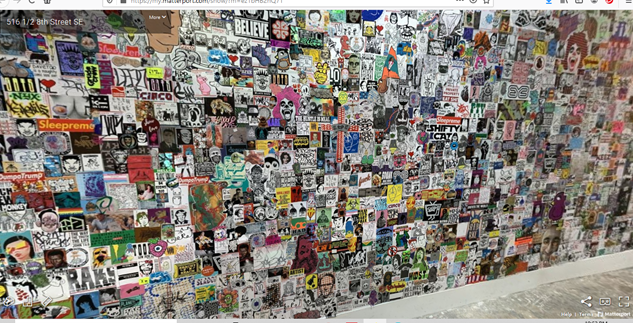
What are your plans if 2021 turns out worse than 2020? To just keep doing shit that makes me happy, I guess. I’m stoked to see friends getting the recognition they deserve. I’m constantly inspired by seeing other people doing amazing things. I like the idea of getting my stuff bigger. I’m going to probably fall out with Instagram again, keep skating a long way, keep buying more records and still be grinning from ear to ear whenever I start up my old car!
Vez (@vez_streetart)

What changes did 2020 bring for you personally? The biggest change for me in 2020 was my relocation from the UK to NZ. Moving on my own to the opposite side of the world was always going to be a challenge. As well as saying goodbye to my family and friends, I also said goodbye to my regular pasting crew. I knew I had to find fellow street artists to connect with in Christchurch. Luckily, the Slap City events at Fiksate Gallery helped me enormously with that! Finding this group helped me to not only connect with street artists, but I made friends. Inevitably this helped me settle in. It has also influenced my style, too. I’ve done lots more stickering and started making handmade stickers too, which I hadn’t done before I moved here.
What got you through lockdown? Lockdown was an interesting time. I had just arrived in the country and I didn’t have my current network of friends. My furniture, which I shipped from the UK, got delayed. I was in an empty house (no bed, no couch, no TV, no WiFi!), and on my own. I kind of enjoyed having time to myself and having space to think. I spent the time doing yoga, preparing handmade stickers and making plenty of video calls with family and friends back home in the UK.
What has been your personal artistic/creative highlight of 2020? My highlight this year was taking part in Perspective, an exhibition of women in urban art at Fiksate. It made me really happy to be asked to participate and to have my art showcased with lots of talented artists. It was an exciting project to take part in.
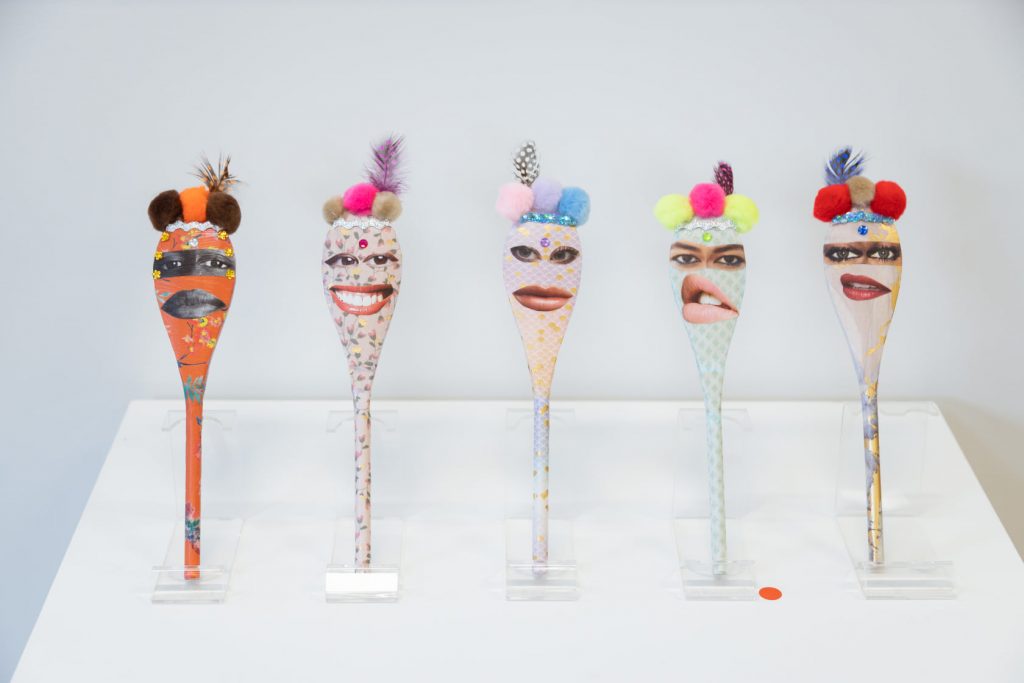
What pieces of art or cultural events, local or international, caught your eye and which do you think will define 2020? What stands out for me in 2020 is how lock down and quarantine seemed to bring artists together from all over the world… So many lockdown art collaborations were being done… I think a lot were initiated by Teeth Like Screwdrivers! I did a lot of collaborations too during lockdown. I guess we all had time, and that’s wonderful.
What are your plans if 2021 turns out worse than 2020? At this stage I have no particular plans for 2021. I think what 2020 has taught me is that life is so unpredictable, no one knows what is around the corner. I’ll continue to make art and spread the spoon love.
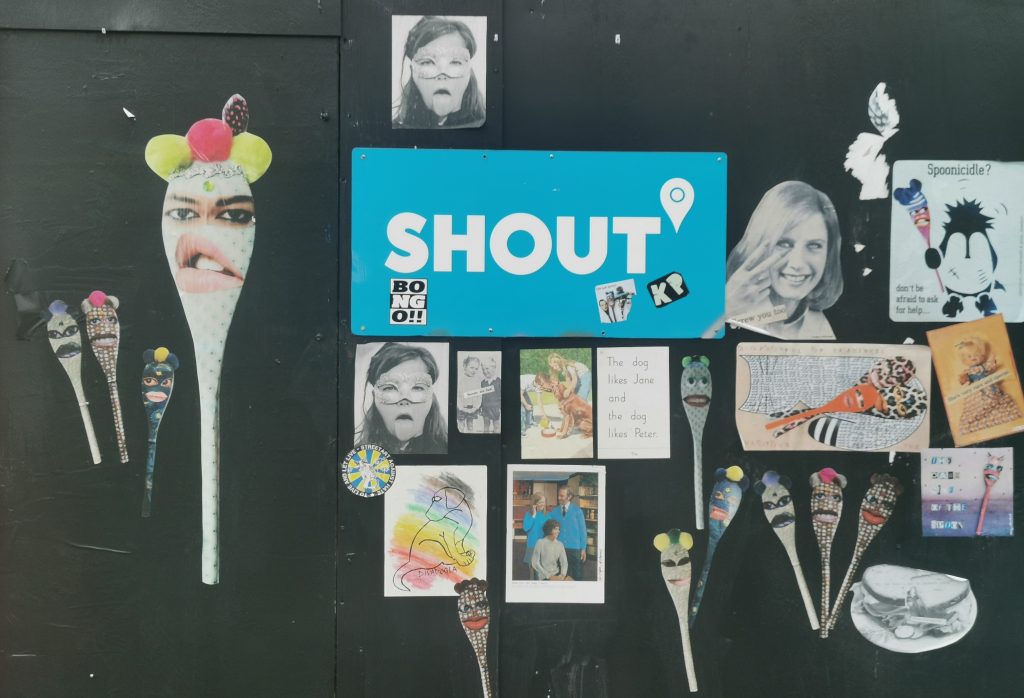
A Tribe Called Haz (@atribecalledhaz)
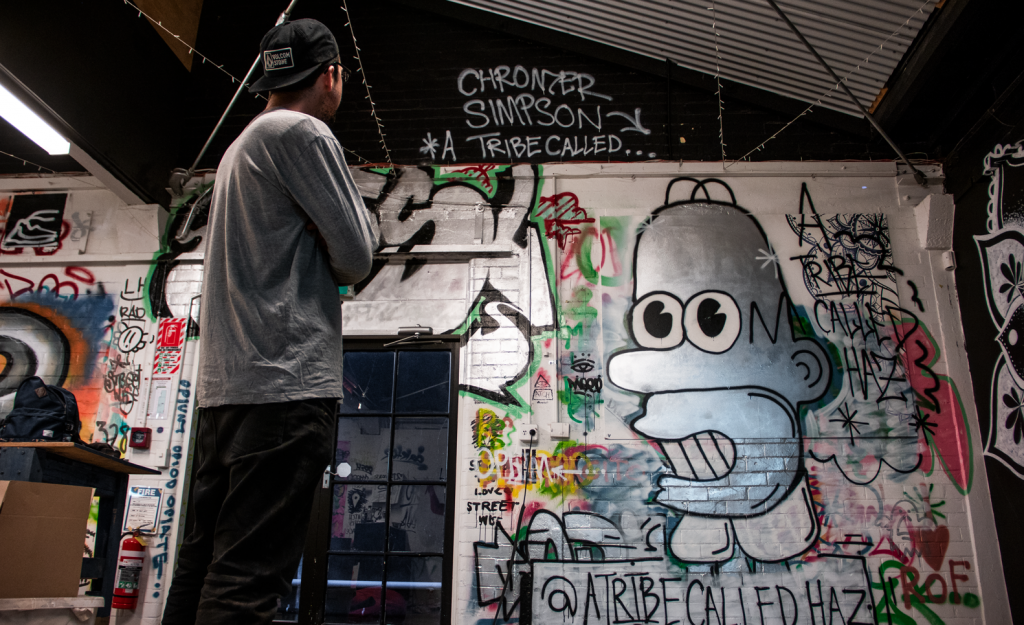
What changes did 2020 bring for you personally? One of the biggest changes for 2020 was not being able to head overseas. I’d been psyching myself up, planning to head out into the world and see some sights and experience other ways of life. As to changes in work, I’ve moved away from painting with watercolour into painting primarily with ink. I’ve also used traditional American tattooing designs as inspiration a lot more than I have in previous years.

What got you through lockdown? Pretty much all my energy during lockdown was directed towards painting, DJing or running. I’d wake up around seven each morning, chuck on a podcast and just paint at the kitchen table until I got hungry then I’d make breakfast and carry-on painting. I definitely produced the most works I’ve ever made in my life during that period. Then if the inspiration fountain was running a little dry, I’d jump on the DJ setup we (the Winton Street crew) had also set up in the kitchen. I began getting really into running to combat the claustrophobia I’d feel from spending every day in the kitchen. Everyone knows how good exercise is, so I don’t really need to gas up running and its benefits!
What has been your personal artistic/creative highlight of 2020? My highlights would definitely include Halves on an Exhibition, which Reece Brooker and I had at Outsiders in March (pre-lockdown), then Haz Called A Tribe, the first group show Becca Barclay and I put together at Outsiders in July (post-lockdown). It featured two-and-a-bit handfuls of talented locals/pals. The night got pretty large! I also had my first month-long exhibition filling up all the walls at Black & White Coffee Origins (thanks Chris!), it was an awesome experience, and I learnt a lot.
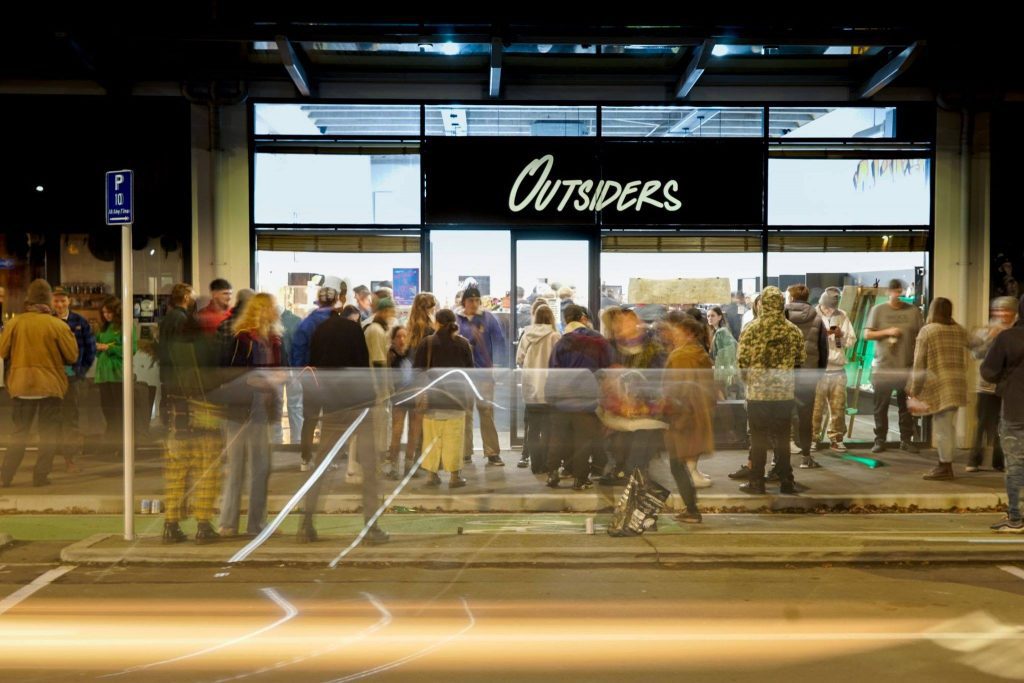
What pieces of art or cultural events, local or international, caught your eye and which do you think will define 2020? The BLM protests and the USA 2020 election featuring COVID-19 will definitely be the most “2020” thing. You wouldn’t believe it if it wasn’t true, absolutely unreal!
What are your plans if 2021 turns out worse than 2020? Probably learn how to cook, haha! (I can’t cook)
Josh Bradshaw (@joshbradshaw_art_)
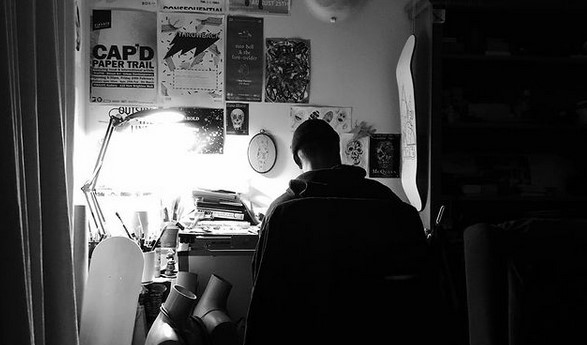
What changes did 2020 bring for you personally? Art wise, the biggest change that 2020 brought for me was probably the retirement of a particular style of work and the pseudonym under which all that work was made. With freedom from the confinement of that one style, I’ve been able to delve into producing work under my own name that has been floating around in my brain for a while. New work. New materials. New fun.
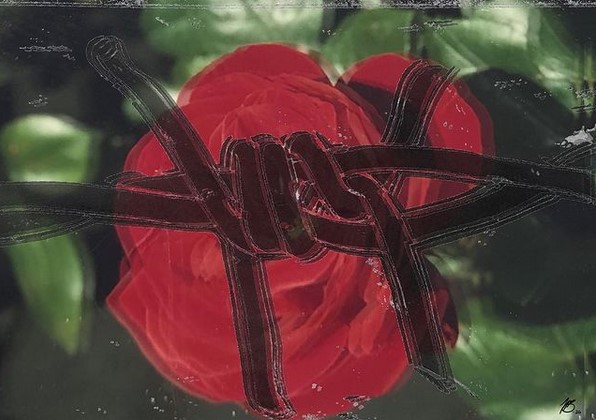
What got you through lockdown? Skateboarding every day in the car park next to my house made lockdown super bearable for me. Luckily, I had a pretty decent supply of art materials as well and with the extra time on my hands it was good to tinker away on plenty of new stuff. With the small amounts of “real work” that I had to do at home and skateboarding and good flat mates and art to work on, lockdown was surprisingly good. I was very lucky.
What has been your personal artistic/creative highlight of 2020? I would have to say the retirement of the ‘Uncle Harold’ pseudonym has been a huge highlight, such a weight off my shoulders that was obviously well overdue. As far as a particular project I was a part of in 2020 that was a highlight, it would have to be the See Me Skateboards project. A bunch of epic local artists got to go into schools and run workshops with the kids painting their own skateboards. It was awesome seeing kids realise art doesn’t always have to be super serious and boring and they got to go crazy with it and experiment with all sorts for materials and styles. Seeing all 200 of the kids’ boards exhibited at the 013 Gallery was fucking rad too.
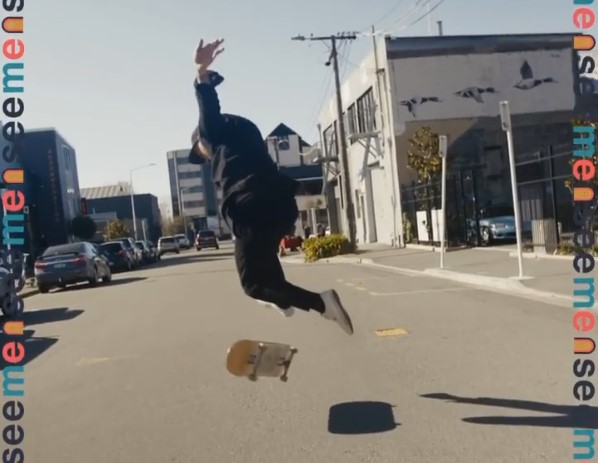
What pieces of art or cultural events, local or international, caught your eye and which do you think will define 2020? Reading this question, particularly the ‘2020’ part, regarding what pieces of art stood out, my mind instantly jumped to all the Covid-19 conspiracy theories written in chalk on the Bridge of Remembrance in town. I walked past new messages every day and I’m not sure which had more mistakes, the facts that supported those theories, or the actual spelling mistakes in the messages themselves. That’s pretty fucking 2020 if you ask me.
What are your plans if 2021 turns out worse than 2020? At the moment my life seems to be way more of a shit show than 2020 or 2021 could ever be, loooooool. Come at me 2021, I’m already way ahead of ya! Hahahahaha…
Daken (@whatsdakalakin, @413localgallery)
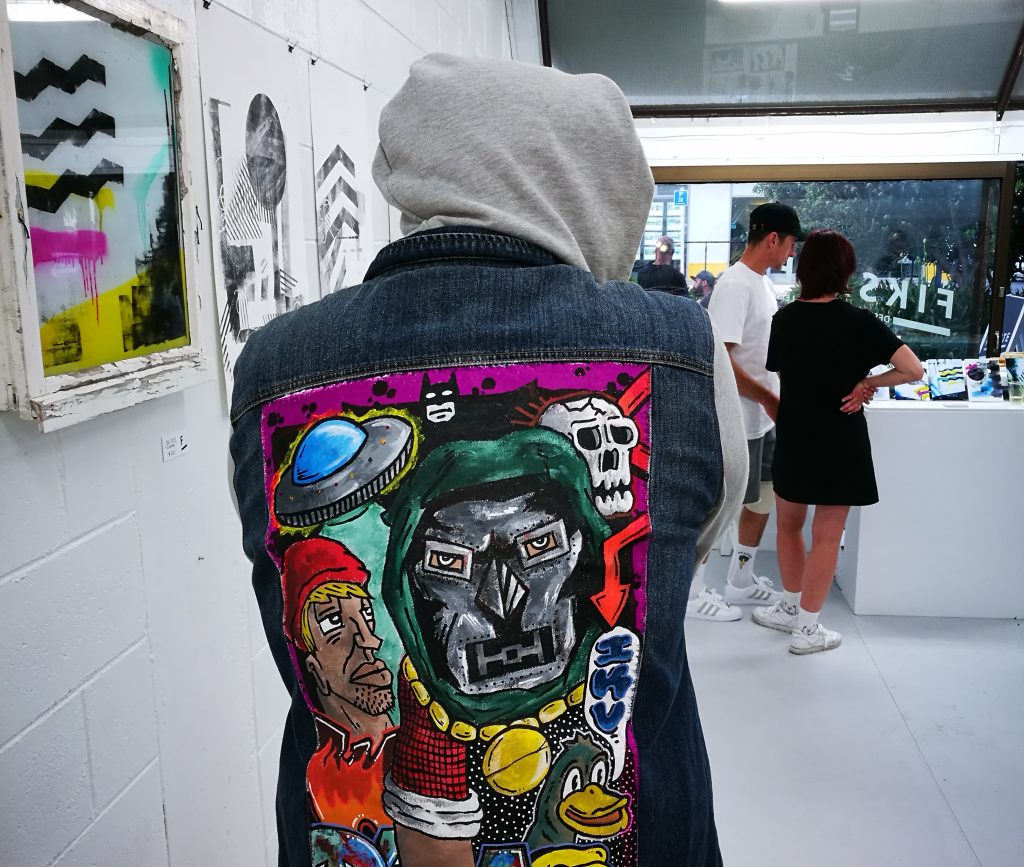
What changes did 2020 bring for you personally? 2020 was the year of change! The whole world is going through a cosmic shift. At the same time, my personal world also went through HUGE changes. I managed to get married, go on a honeymoon, renovate my house and have a baby all within the year of Covid-19. (That’s just the main stuff!) With all of that put together, change is inevitable. I only got to host one show at my gallery (The 413 Local), we put it on after the lockdown. It was called Isolation and the artists showed work either made in or inspired by the New Zealand lockdown. Before Covid-19, I had hoped of putting on at least two or three shows. But alas, plans change. I did end up trying a lot of different mediums and techniques that I have never used. The changes around me allowed me to become more experimental and less precious about my art. I tried my hand at watercolours, pushed myself with Copic markers, and made my first bootleg toy. All while also having fun with my usual tools and materials. My main focus for my personal art this year though was drawing and making my first comic book. I released A Dog’s Mind (Issue 1) with the thought “There are no such things as mistakes, just happy accidents” in mind. (Thanks Bob Ross!)
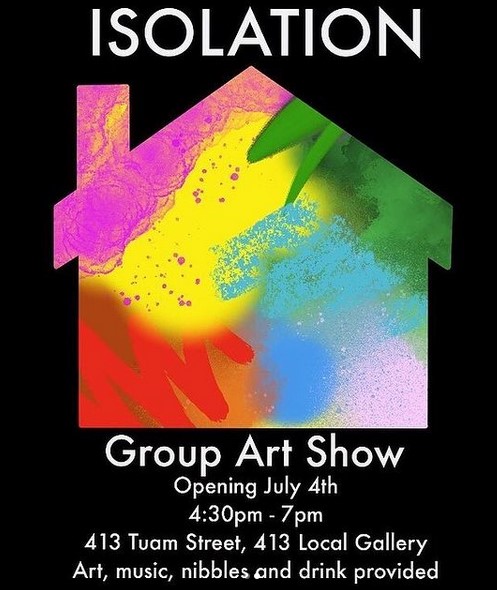
What got you through lock down? Definitely my wife, Sammie, she pushed me to create and make things when I fell into the trap of Playstation and potato chips. But also, a lot of podcasts, I’ve been on a real scary story/horror and live play 5E D&D buzz this year. Music is a big one. Lots of O.G. hip-hop, Fall Out Boy and I ain’t afraid to say it, Lewis Capaldi. Then reading, I’m really into non-fiction lately, and a healthy dose of comic books, of course! I have actually been moving away from the big two (Marvel and DC) lately and finding more indie/underground artists and books, which is really refreshing.
What has been your personal artistic/creative highlight of 2020? So, I also joined a local comic group called Funtime Comics. We meet once a month and talk and draw comics and hang out. Every year they produce a graphic novel from artists all over New Zealand. I got published in their special Covid-19 issue and will have work in their next issue as well. So, on top of hand-producing the first issue of my own comic, and starting the next issue, I will be in two Funtime comics as well. Pretty chuffed with that to be fair! I also did my own version of Inktober called Daktober. I did 31 prompted ink drawings. It did take me like two months longer than everyone else to complete, but my daughter Clarke was born just after I started, so I kind of had a good excuse! But to tell the truth, she is probably the greatest thing I have ever had a hand in making. Clarke is definitely my biggest highlight this year!
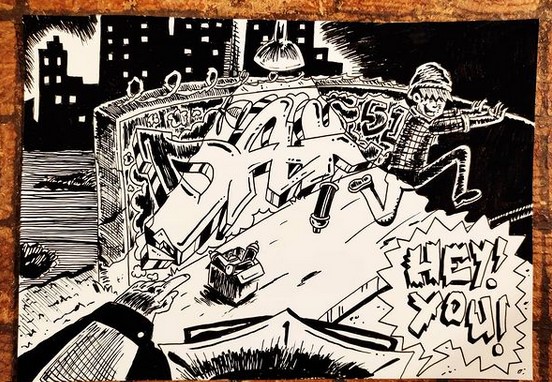
What pieces of art or cultural events, local or international, caught your eye and which do you think will define 2020? As I was reading this question, instantly the BLM movement came to mind. How could it not? Tragic events that are still shaping worldwide generational protests. Compare that with taping a banana to a wall, I don’t think it stacks up… Not only did I see art come from the reaction to the BLM movement, but it’s still on going. From fine art, graffiti, music, there is a massive influence. It seems to me that the arts are not only a tool but also a release for artists all over the globe to tell others about their emotions and experiences. That’s what the arts are for, right? To give a message, leave a mark, communicate. It’s not often that a culture-changing event like BLM happens. A Van Gogh painting got verified this year. A Salvador Dali painting might have been found in a thrift store. Both are amazing events that took place this year. Both add to their narratives in the space of society. But it is the old guard. BLM has a spark of new energy. Watching statues of Confederate generals fall and being replaced by A Surge of Power, a work by Marc Quinn and Jen Reid depicting a young black female protestor raising her hand with the Black Power salute, was powerful. Listening to the stories and political knowledge woven together with beats from the likes of Run the Jewels or Tobe Nwigwe, or seeing a painting by Shaquille-Aaron Keith, while reading a poem he wrote to accompany it, I feel like there has been a shift. BLM was a massive push in the right direction. A direction with many events and situations that seem to have been culminating the last couple of years, have come together. Looking to the future, I feel under-represented people from all walks of life, extending beyond BLM, will not only find their voices in all genres of the art world, but they will dominate it, leading the way for more diverse storytelling, bringing more people together.
What are your plans if 2021 turns out worse than 2020? Not too sure, but I got my crow-bar ready for the zombie apocalypse (it’s the superior choice for that situation).
Jessie Rawcliffe (@jessie.e.r)
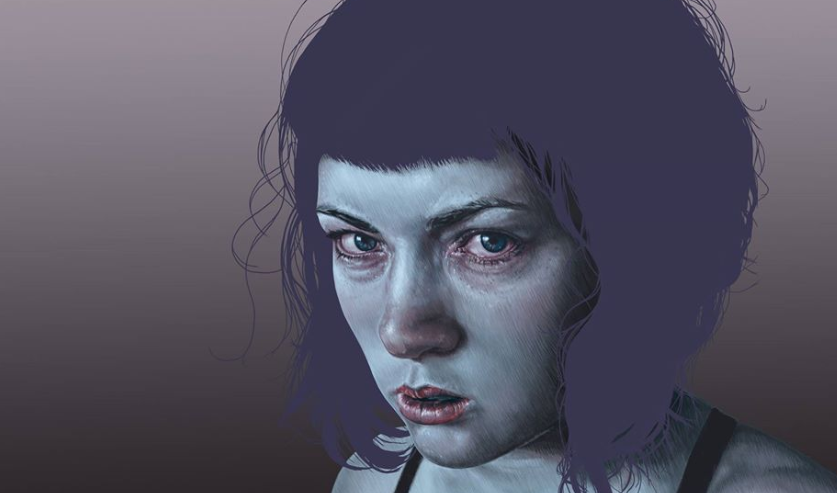
What changes did 2020 bring for you personally? I’d planned to spend a lot more time out of Christchurch and lean on some North Island connections to push my work getting seen in other places. I definitely had to put this on hold but managed to change my focus to making some stuff I’d had in my head for a whole so overall I came out reasonably unscathed.
What got you through lockdown? Having a routine but also being fluid enough to decide each day with what it was that I needed (emotionally, physically) and letting myself deviate as required… Having my studio at home, checking in with my close friends, Star Wars, our espresso machine, a boxing bag, oh and the Covid-19 Wage Subsidy!
What has been your personal artistic/creative highlight of 2020? Lockdown gave me time and space to experiment without impending deadlines or having to go to work. The most notable thing I made this year, which encompasses lots of the ideas I played with during that time, was probably a painting called Ophelia which was in an exhibition run by the Conscious Club. It ended up being something I was super proud of and didn’t immediately want to pick apart.

What pieces of art or cultural events, local or international, caught your eye and which do you think will define 2020? Has to be Vesil’s toilet paper piece that went up just before lockdown, iconic.
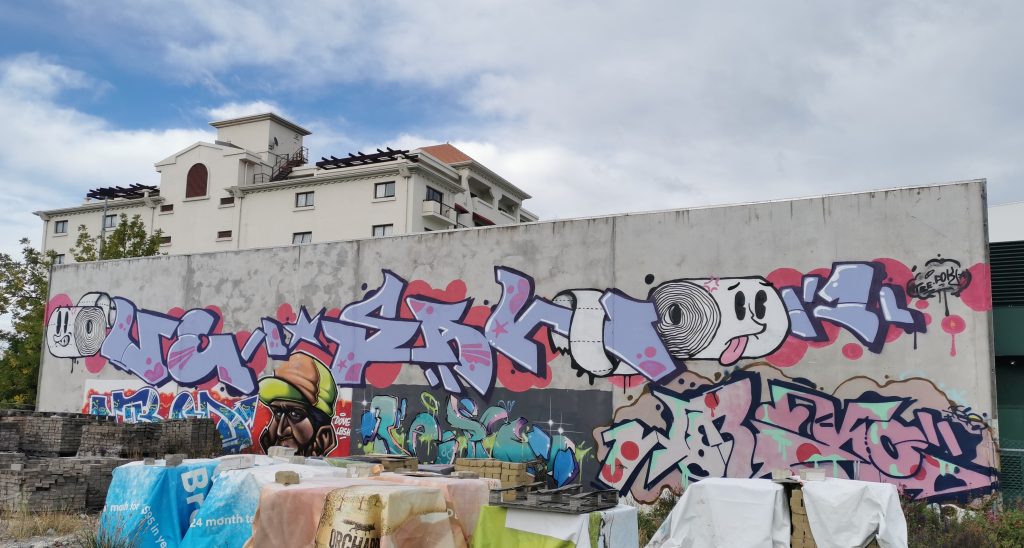
What are your plans if 2021 turns out worse than 2020? Go full hermit and probably have the most productive year of my life with nobody around to give a single fuck.
Keep an eye out for our monthly And That Was… entries throughout 2021!
Feature Image: One of Levi Hawken‘s BLM concrete solvs in central Christchurch
And That Was… December 2020
Well, thank god that is over, right?
Actually, 2020 has been such a surreal and, truthfully, emotional year that it almost seems insensitive to joke about it. Between the Covid-19 pandemic, the loss of lives and livelihoods, the Black Lives Matter movement, the farcical post-election shenanigans in the U.S. and more, there has been real and wide-spread heartbreak and tragedy. While some developments will stretch beyond the 12 months of 2020, in part due to their enormity and the necessary concentration to effect meaningful change, it is still necessary to take stock of the good things in a year we mostly just want to be over. The And That Was… series has always been about those things that bring joy, from the seemingly incidental, to the showstoppers, so let’s finish 2020 with a recap of some good stuff from December. With the end of the year approaching and a flurry of projects and events taking place, thankfully there has been a fair bit to consider… (This month we took the reigns, but don’t worry, we are working on something with a whole bunch of friends for the coming days, so keep your eyes peeled!)
Mike Beer goes to the dogs…
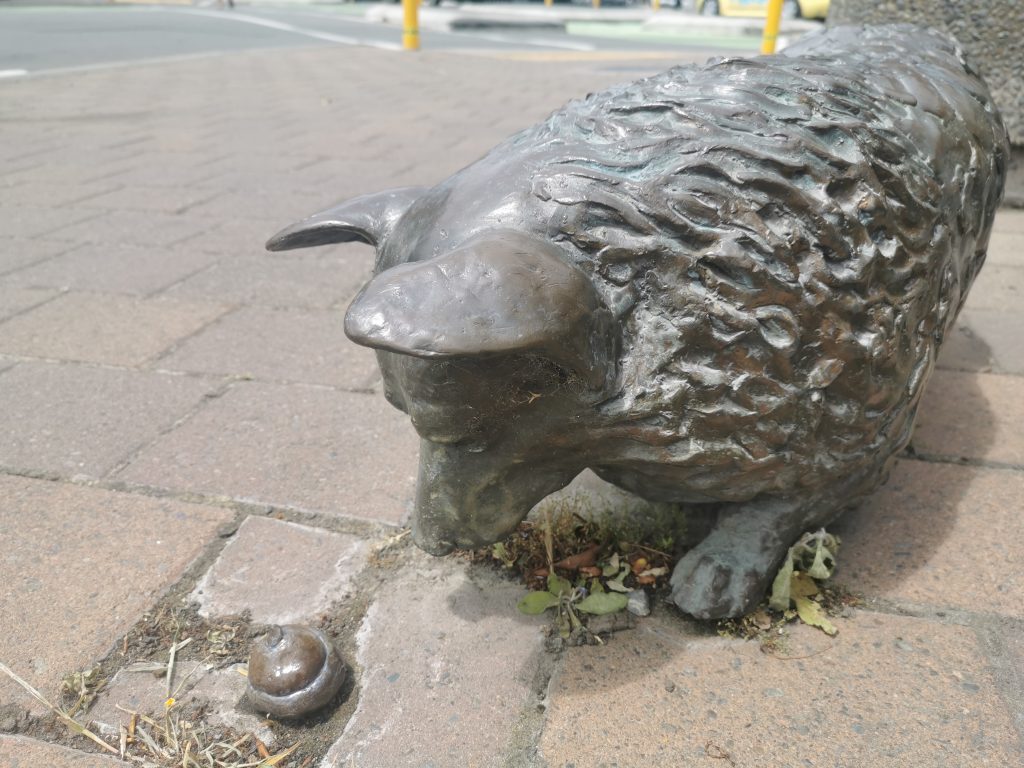
You probably all know sculptor David Marshall’s three bronze corgis on High Street, right? I mean, they have been there for over a decade now. What you may not have noticed was that a few weeks ago, the dropped ice cream cone one pup inquisitively sniffed disappeared. Sniffing an opportunity himself, our new favourite scratch builder Mike Beer decided to create and install something a playful replacement, drawing on the influence of subversive guerrilla street sculptors. You may just need to check it out for yourself, but perhaps don’t get too close…
Dcypher dropping science…
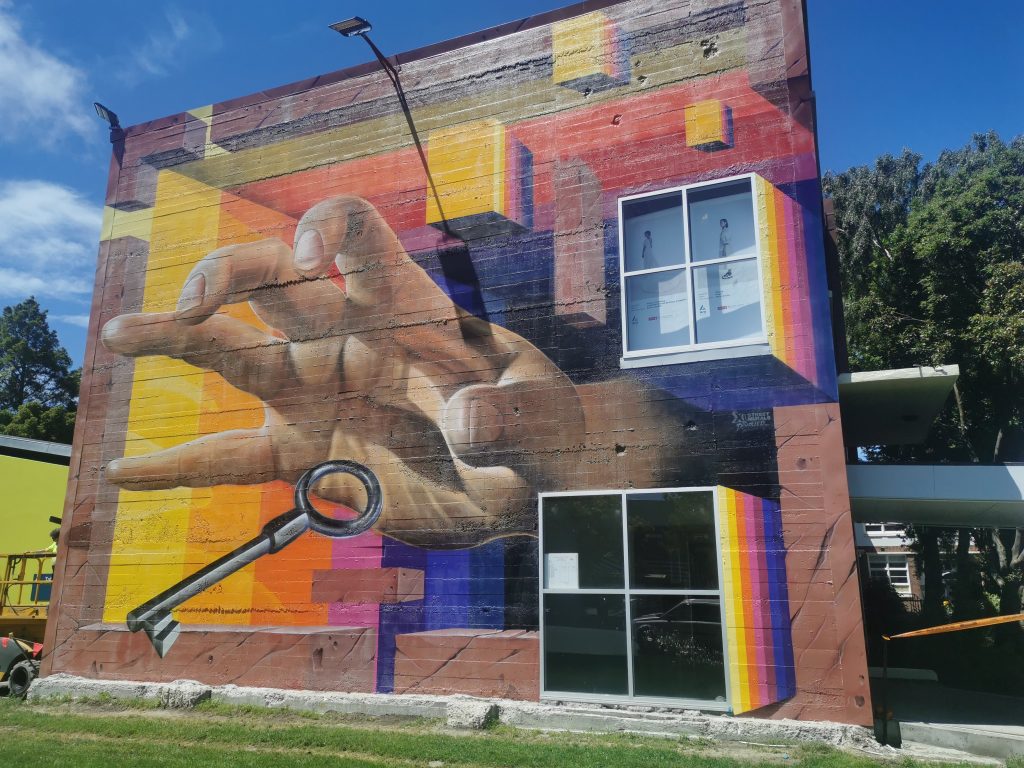
With a massive wall exposed by the demolition of a section of the Ara campus on Madras Street, which incidentally also meant the eradication of the Vans the Omega mural produced back in 2013 to announce the coming Rise festival, a new mural seemed an obvious requirement. Into that void stepped Dcypher, filling the gap with a striking anamorphic mural. A giant hand reaches towards a silver key, suggesting the importance of the search for knowledge, all within a disintegrating framework that dissolves the built environment. It has already gained international attention on Global Street Art.
Glass Vaults at Space Academy
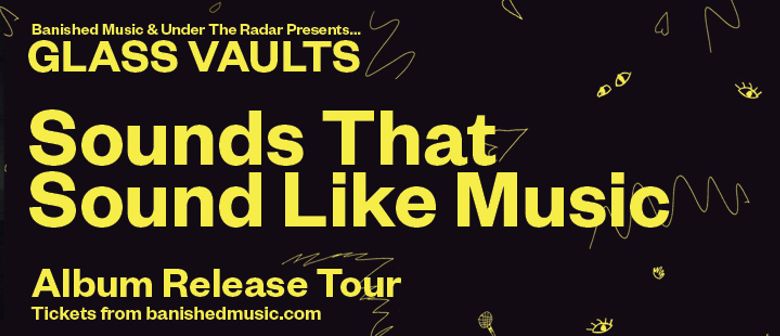
The return of live music must be one of the best things about the second half of 2020! Space Academy hosted Christchurch-based Glass Vaults in early December, the group touring their new Sounds That Sound Like Music album. Their unique psychedelic-pop is heading towards dreamy disco funk, and the live show was definitely a winner, culminating with the infectious 2017 track Brooklyn. Also, is the pocket of St Asaph Street now home to the Darkroom, Space Academy now the live music district of the city?
Distranged Design goes big…

Jacob Root (a.k.a. Distranged Design) has generally worked to a scale that reflects his stencil-based approach. But with a new technique that still allows his stencil aesthetic, the artist produced his biggest work yet in December. The work, visible from Manchester Street and Tuam Street, was commissioned by a local property developer and seemingly pays tribute to the lost churches around the city, titled Christ Church Restoration City and featuring an angel figure flanked by two crosses.
Fiksate find a new home
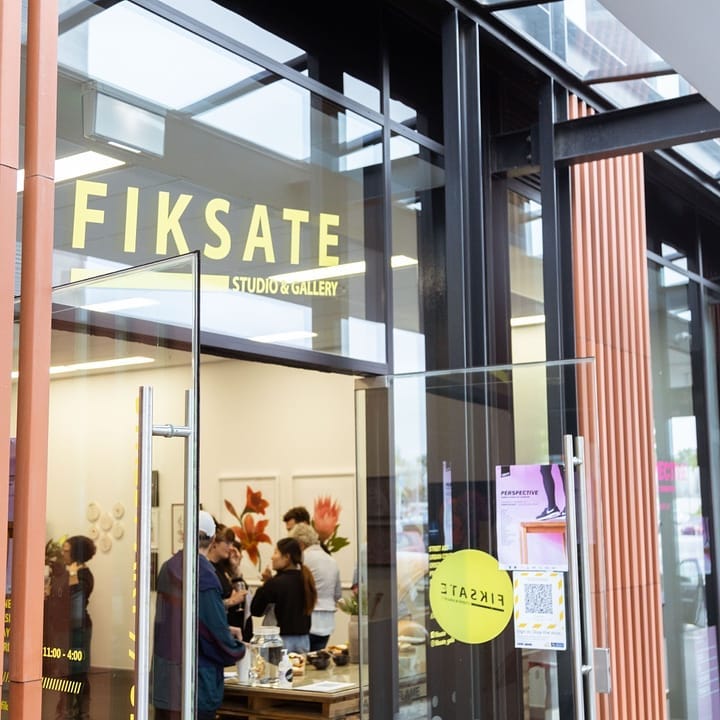
Fittingly, the last And That Was… of 2020 (kind of, you’ll see…) ends with the beginning of a new chapter for a local institution. After two years and plenty of memorable exhibitions, Fiksate will close the doors at Gloucester Street, relocating to a new base in Sydenham (details to come!). With a new home and surely a dash of revitalising energy, it will be exciting to see what Jen, Dr Suits present in 2021…
Well 2020, what else can I say but, see you, wouldn’t want to be you! We do however, look forward to what 2021 brings, so stay tuned for future installments of And That Was…
Ōtautahi Christchurch Urban Art Video Series
During the Covid-19 lock down, with our guided tours unable to run, we applied to Creative New Zealand for funding to create a virtual tour – a video series where you could learn more about some of the city’s most beloved graffiti, street art and murals from the artists who created them, all from the socially safe distance of your couch. With our friend Centuri Chan manning the camera and the editing desk, we talked to 17 New Zealand artists to get some insights into a range of works and topics, from Ikarus‘ take on graffiti writing and Paul Walters‘ stories about the massive SALT mural, to Jacob Yikes‘ discussing his signature style and Flox recalling her Ode to Hinewai work in Beckenham.
Originally conceived as a singular continuous feature, it became apparent that a segmented, episodic approach would prove more manageable, more adaptable and more consumable. As a result, the concept evolved into 16 individual vignettes, forming a cohesive series and spread across multiple platforms, including our online map entries. Featuring artists from around New Zealand (Paul X Walsh, Cracked Ink, Berst, Chimp) alongside local talent (Wongi ‘Freak’ Wilson, Dcypher, Dr Suits, Nick Lowry (Tepid), Dove, Jacob Root (Distranged Design), Josh O’Rourke, Jen Heads, Caelan Walsh), the series spans an array of styles and projects, highlighting the multifarious approaches within Ōtautahi’s urban art scene. Artists share humorous stories, intriguing insights and technical details, providing context and content to works that have become familiar sights in the city. With a level of normality returned, we like to think the Ōtautahi Christchurch Urban Art series is a perfect companion to a guided walking tour!
The Ōtautahi Christchurch Urban Art series can be viewed on our YouTube channel, via our social media platforms or on our website. With new episodes released each week, follow and subscribe to our various forums to receive notifications when new episodes go live!
Check out some of the videos below:
And That Was… August 2020
With the return of Level Two, August has been a bit of a roller-coaster, with the highs of communal gatherings matched by the returning weariness of congregations and the tiresome political bickering and conspiracy theory wackiness dominating much discourse. But that is where art is so effective, it can be both a glorious shared activity and a private independent adventure, a distraction from what is going on and a reflection of those same issues. The month started with a sense of excitement as I met with artist Tom Bell to discuss his upcoming show Adoration, which provided a great opening night. As time passed, more things turned my head. It was clear people were busy, from guerrilla interventionists, to mural artists, and it felt like the city was alive with activity. This energy has been somewhat tempered by the potential of a shut down (at the time of writing this at least), but it gives me pause to believe that even when difficult times emerge, art can always find a way to help out…
Tom Bell – Adoration @ Absolution
The month kicked off with a farewell as Tom Bell presented Adoration at Absolution in the Arts Centre. Tom has been based in Ōtautahi for several years, working as a graphic designer, while diving back into painting more recently as a creative outlet. His art has long been entrenched in Japanese imagery, and Adoration played homage to that ‘adored’ visual style. Intricately cut and painted plywood, with subtle layering and flashes of detail made for a striking collection. The turn out was also impressive, with Absolution jam-packed, a well-deserved result for the artist’s long path towards Adoration.
Levi Hawken’s urban installations
Auckland-based artist Levi Hawken’s concrete sculptures were introduced to the city at the Fiksate show Urban Abstract last year. Placed within the gallery setting, they were immediately recognisable as versatile aesthetic objects. But Hawken’s works are undeniably influenced by the urban environment and they gain so much from their placement within the cityscape. It was therefore an awesome surprise to see a number of his small works mysteriously applied to walls and fixtures around the city, subtly subverting expectations.
Wongi ‘Freak’ Wilson’s TradeStaff mural update
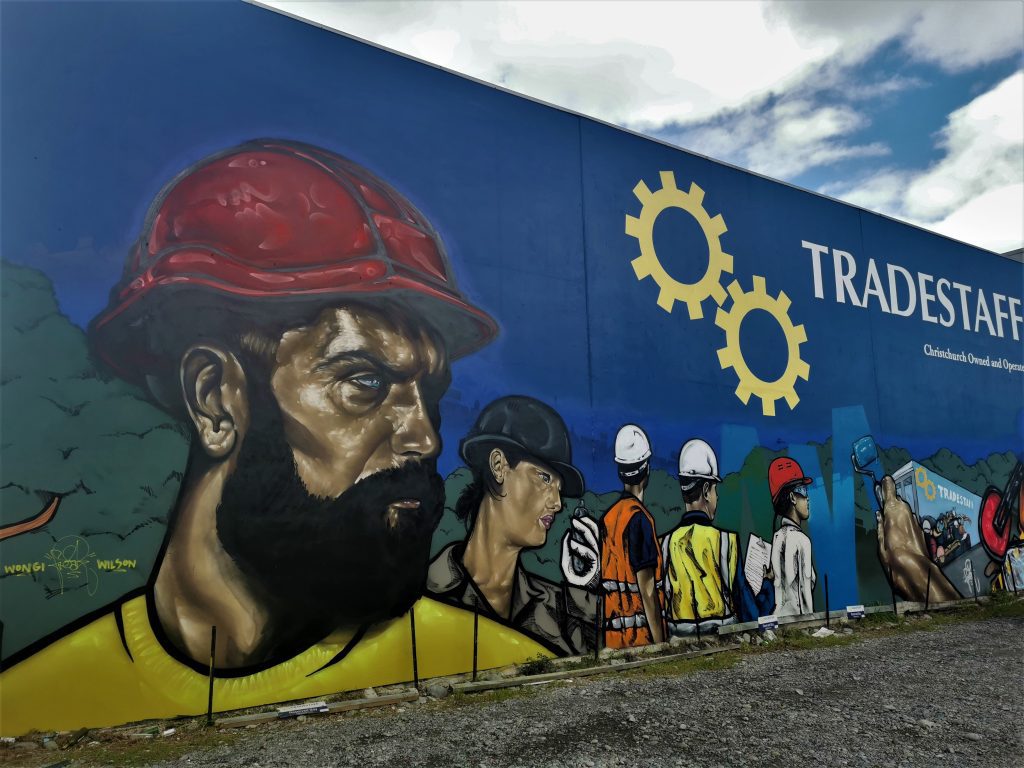
We all know Wongi Wilson’s aerosol technique is mightily impressive, and that rings even more true as time passes and he refines his approach. That reality is instantly recognisable with his recent refresh of his own TradeStaff mural on the corner of Colombo Street and St Asaph Street. The original mural, painted around 2013, had become a familiar site in the CBD, but the new work, still in progress when I first saw it, is incredibly striking, almost invoking the proletariat intensity of propaganda posters…
Catching up with old friends…
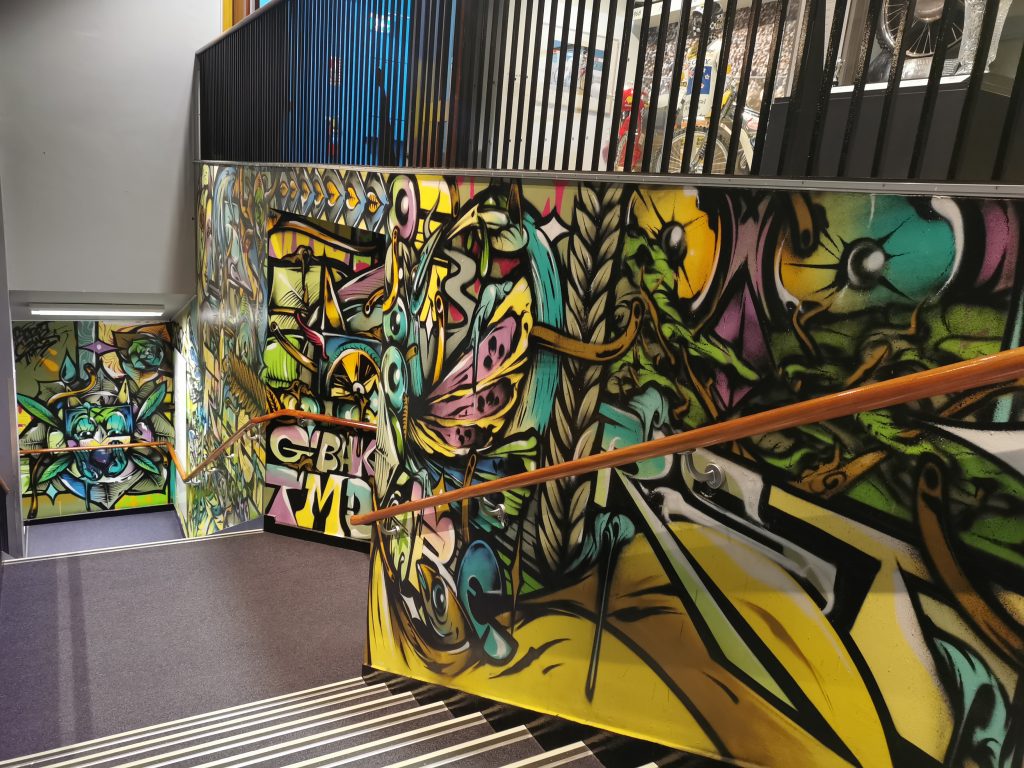
Over the month of August, we have been putting together a project that we can’t wait to share… but for now, it is enough to say it has been a heap of fun catching up with a bunch of our favourite artists and revisiting some of their most memorable works (including some more recent additions), such as Berst and his God of the Forest in Sydenham and staircase mural inside the Canterbury Museum (pictured).
Distranged Design on Manchester Street
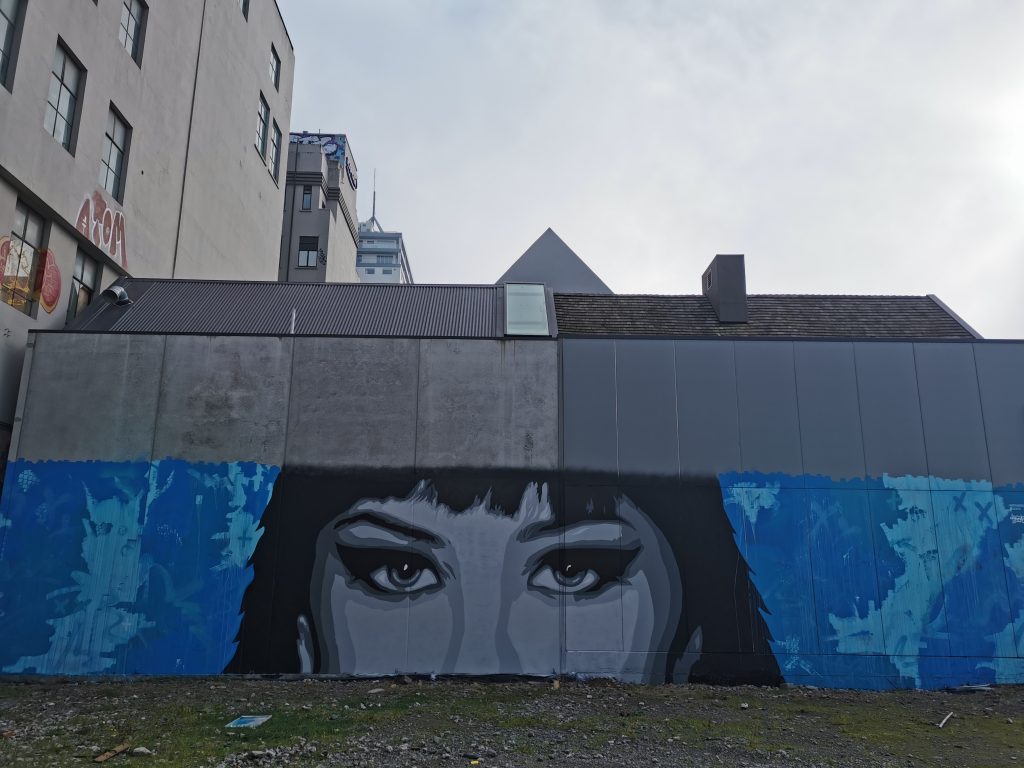
Distranged Design’s newest outdoor work on Manchester Street is an impactful surprise, anonymous eyes peering out from an expressionistic blue background splashed across a distressed wall. Staring at passing traffic from behind hurricane fencing it is an alluring sight and forms part of a larger collection of interventions in the vacant lot…
What were your highlights from August 2020? Let us know in the comments below…
Long Trip of the Kokos – Robert Seikon and Anastasia Papaleonida
For the month of January Fiksate became a second home for itinerant artists Robert Seikon and Anastasia Papaleonida, the gallery’s first international residents. While Seikon is Polish, the couple are based in Greece, Papaleonida’s home country. That international flavor is further enhanced by their travels, with their arrival in Aotearoa following a stay in the Philippines and an exhibition in Taiwan. During their residency, I was able to spend time with the endearing duo. It was fascinating watching the two, who have been working together for almost twelve months, operate in the studio, each maintaining their distinct stylistic identity, while investigating the potential of collaboration. The artists alternate between a hyper-focus on their individual contributions and conferences around subtle details of composition and colour. But it is not just the studio where their collaborations flourish, with their work appearing on walls in numerous locations, including a number of works produced during their stay in Christchurch. While Seikon’s background in graffiti provides a lineage for this public practice, Papaleonida is relatively new to this approach, coming from a design foundation, bringing a unique consideration to their creative process. Their pairing has resulted in visually stunning works, where sharp, angular aspects contrast with organic elements, creating optical effects that invite the viewer to immerse themselves in the image, only to discover small, unsettling details that disrupt expectation, rewarding inspection. We caught up with Robert and Anastasia as their exhibition Long Trip of the Kokos drew near, taking in the sights and delights of Lyttelton, sitting down for a discussion about their experiences in Christchurch and New Zealand, their collaborative partnership and the differences working indoors and outside…
Welcome to Aotearoa! How long have you been in the country now?
RS: We have been here for one month already. It’s very nice.
AP: Amazing.
What are your perceptions of New Zealand so far?
AP: Everything is very organized and super clean! You are in the middle of nowhere and there’s a bathroom with a paper, it’s like, what the fuck?! And in general, the people are super nice.
RS: It’s not only the toilets that are clean! The grass is cut everywhere, fresh walls are repainted, everything is clean. You get the feeling you are at the end of the world, that you are very far away. But everyone is super friendly, you feel comfortable as soon as you get out of the airport.
As artists, do the distinct atmospheres of different cities and countries start to influence your work?
RS: It makes a difference for sure. Here for example, during our trip from the North Island to the South Island, the landscape was changing almost every hour. The landscapes in New Zealand combine parts of European landscapes all together, which is very interesting for us. All the colors and shapes we have seen during this trip have made a big impact on us.
Both of you work in abstraction. What specific influences have fed into the recurring motifs in your work? Have they come from real world references?
AP: For me, it’s about landscapes, plants, organic things…
RS: For me it is both the natural landscape and the urban environment. But in this case, for this exhibition, I think mostly the landscape, because we have worked with the memories that we have collected over the last few weeks of being in New Zealand. Sometimes I like to be inspired by the city, but here it hasn’t been the case. If we work with a wall in the city, the surrounding area is going to inspire the wall, but for this exhibition the influence is mostly the natural landscape.
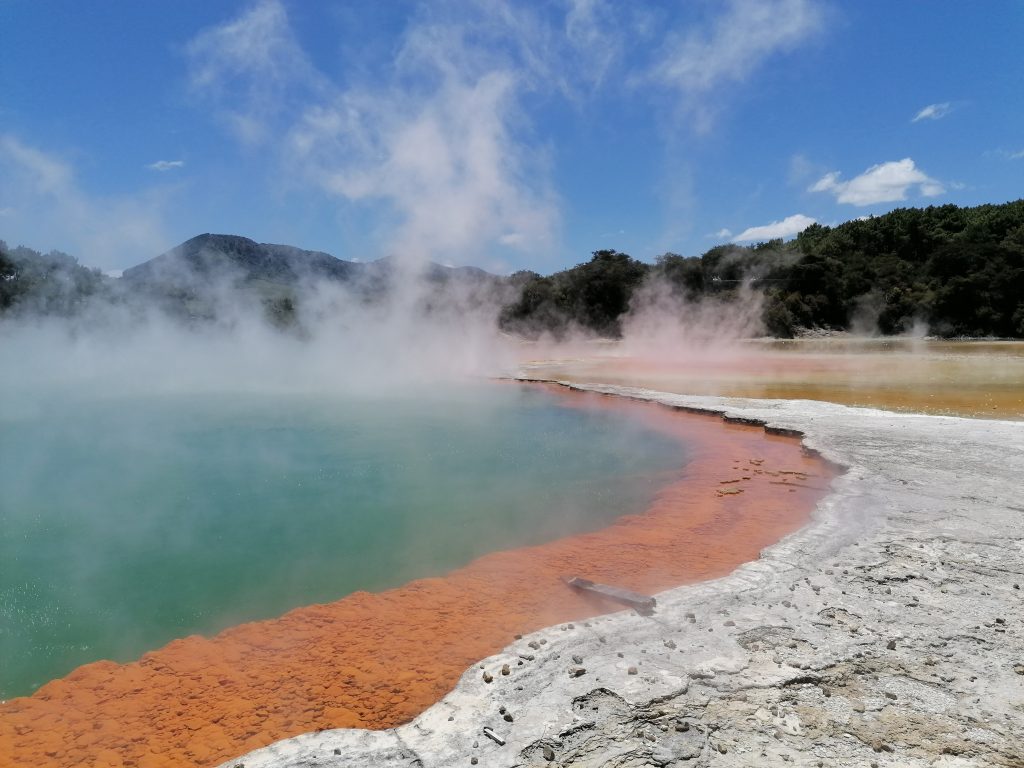
There is an interesting interplay between your individual approaches; Anastasia, your more organic forms that seem to reference the cellular and biological, while Robert, your lines and geometric forms seem more hard-edged. While those aspects are quite distinct, the colors seem much more of a collaborative component…
RS: We enjoy talking about color.
AP: Yes, on this trip we have worked a lot more with color. In the past we didn’t have the opportunity to do that much, we were working a lot with black and white.
RS: In general, we like to use black and white.
AP: But, after this trip, travelling in the Philippines and here, the colors we have seen have been amazing and we have started to mix more colours. With all the work we have prepared for this exhibition, we have mixed I don’t know how many colors…
RS: We haven’t used straight black like we have before. Everything is mixed with something…
AP: The vision that we have for the exhibition is to create an atmosphere that is unique, which comes through not using straight black like we have in the past.

This body of work has been created as part of your residency at Fiksate. You have noted the influence of your travels, but did you already have an idea of the work you were going to make when you arrived in Christchurch, or has the experience of the residency, the place and people, inspired the works as well?
AP: It has been interesting to work with other people around. For me, often when I’m working on something new, it takes time before I realize that something is happening for a particular reason. I can’t always see it at the time, but when I look back I can see that it came from somewhere…
I’ve noticed that your shared work station is very organized, from paint cups numbered in a spectrum of tints, to the way tools are laid out, is that something that has developed as part of your working relationship, or was it always evident individually?
RS: I think that is something we’ve both had from the past. Me, I always like to be precise and clean. We don’t even talk about it. We’ve got the same thinking in common…
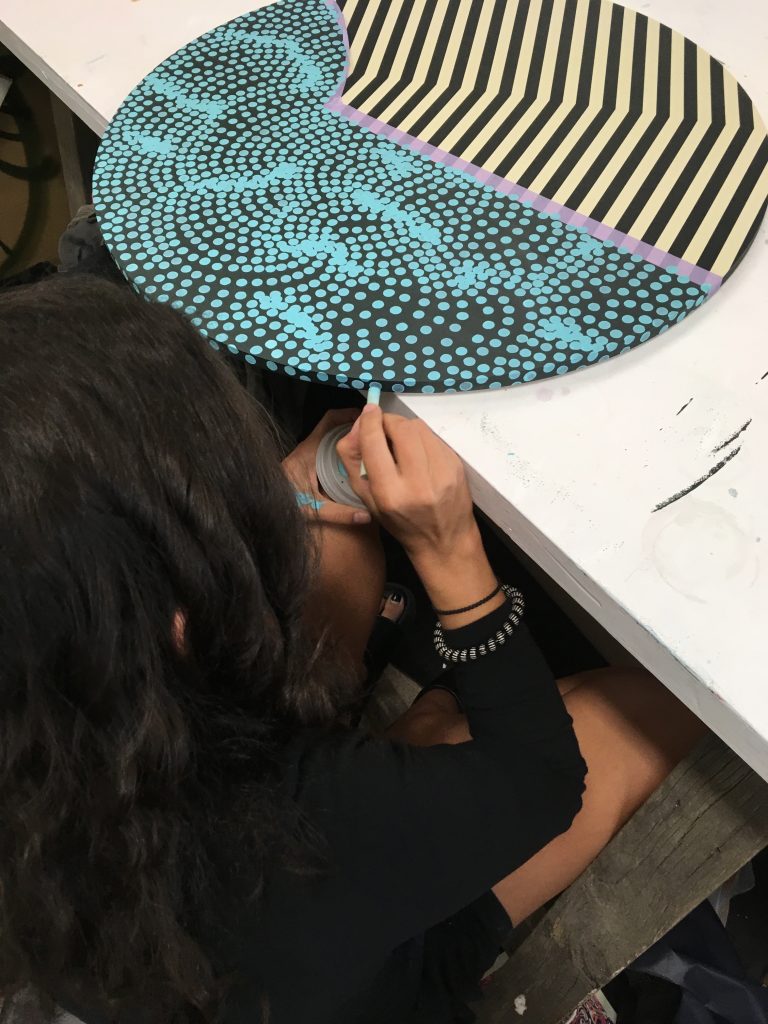
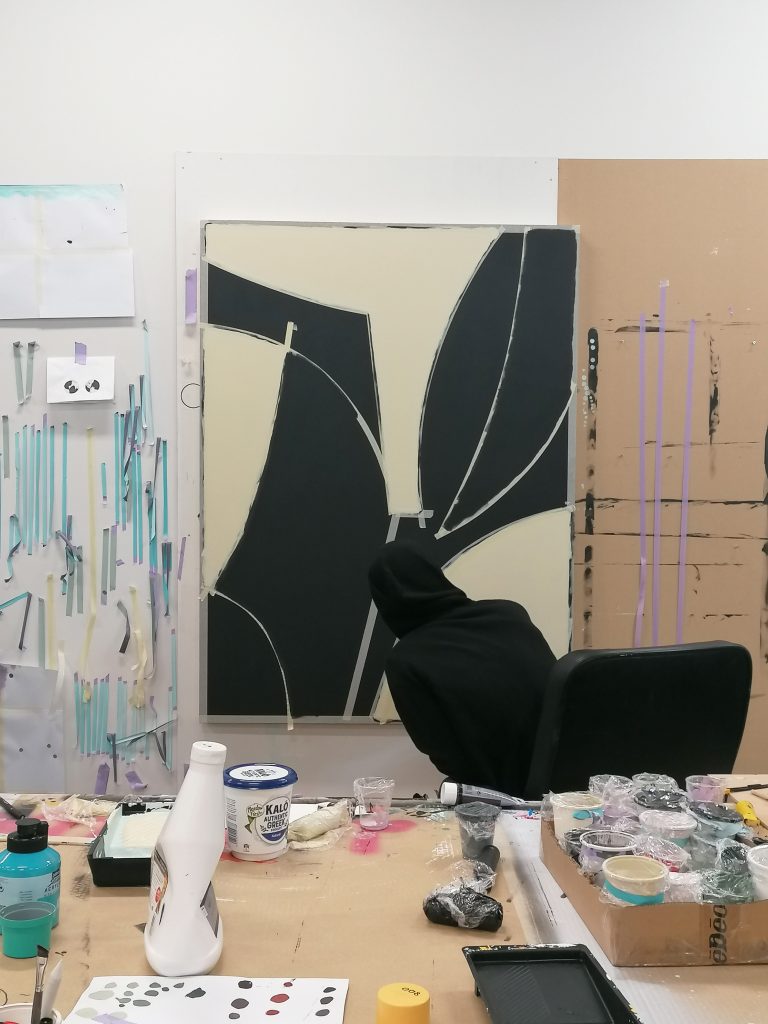
Is that sense of order intrinsically necessary to make the work look the way it does, or is it just a comforting aspect? I’m sure you are both very particular about the clean lines, the perfect dots, the sharp shapes and the smooth gradients, so that organisation must be important in achieving those effects, right? In the studio you can control those elements a little bit more, but do you have the same level of preparedness and organization when you’re painting outdoors?
RS: Oh yes, I like to prepare my bag the day before, so I am ready to have breakfast and go. Then, the morning before painting, I check everything is in my bag; the roller, the sketchbook…
AP: You need this, you need this… Outdoors, it’s like a small studio because you are spending hours in that place and you need your stuff in specific places, so it is free for the wall and for your movements…
There is a physicality to the way each of you work, a physical activity that goes into creating the details, from precise movements to more sweeping gestures. I’ve noticed that when you are working in the studio, while there are times when you’re both working on the same piece, often one of you is active and the other is either observing or off to the side, is that simply to give each other the physical space for these movements?
AP: To be honest I haven’t thought about that before, but maybe, now that you’re saying it, it does work like that, because when someone wants to do something more precise, you need to give him the space to do it…
RS: It’s a good observation. When we work, for example when Anastasia is working and I’ve got a small break, I’m also thinking about the things that I will do next, I’m waiting for Anastasia to move so I can get another answer, you know? It’s like, this little bit here is developing, so what is going to happen next?
AP: It’s not like we are doing sketches and they are the final product. When we create something, we will always add something new, because that touch goes like that, or this line goes like this, and we look at the balance and realize that maybe something new needs to be done. I think this is very interesting because we don’t really know what the final image will be.
RS: We don’t really know what will happen.
AP: And you build that slowly with small moves, it becomes a surprise…
Anastasia, it feels like your dots would have a more spontaneous nature, while Robert, your diagonal lines would be more carefully planned and constructed. But, is that actually the case, or are you both more balanced in your approach?
RS: The biggest similarity we have is that when we are working, we are super focused. You go inside an element and nothing can disturb you. Both of us are very focused on the process of our work. I don’t know, even if the lines or the dots are repeated forms, they can be created from elements all around us, even though they are clean, they can be natural as well.
Your studio output will become the exhibition, Long Trip of the Kokos, but you will also paint several outdoor commissions as well, each in very different settings. Is it important to get out of the studio?
RS: We like to change the environment around us. After spending weeks preparing the exhibition, we have had enough of the studio. We couldn’t start next week again in the studio. I like to have a change when I’m painting, it’s refreshing.
AP: What we will do on these walls will be a continuation of the inspiration that we have drawn from already. Although, with the Cosmic wall [a commission at the warehouse of iconic funk store Cosmic], we will work with a lot of colours, which is something we haven’t done much together. That will be very interesting for us…

Do you ever reflect on being in the position where you can travel to places and leave something of a legacy through painting public works? Do they create a connection to place that average tourists don’t necessarily get?
AP: To be honest, I’m not thinking about that so much, that I will leave this wall as a legacy. It’s more about the process, the time that I’m spending doing it, the time that I’m painting, the people that are around, the interactions with people, the small talk, a question or a smile…
RS: And the moment you finish the artwork, that’s it. You are doing it until that final moment. I’m always crazy happy when I’m painting, when I’m doing something, then the moment I’m satisfied it’s finished, it is for other people from that point. I have made my thing, this is it. I’m very happy if someone gets positive vibes or can see something interesting, but I don’t need feedback. It’s all about the process, like Anastasia said, the process is going to stay in our memories.
The studio environment is secure, but also isolating, it is different from a public presence where those small conversations can more easily take place…
AP: It is very nice to have a connection with people, but also the work carries on, it is seen by people that you don’t meet, even if they don’t say anything, or they say or think something bad…
RS: But here we have been very surprised about how people have reacted to our art. We were traveling here without any expectations, we said: ‘let’s go to New Zealand and see what happens…’ But both of us are very surprised by how people have reacted…
In all of your travel, are there moments of engaging with people while working on a painting or mural that stand out?
RS: I mean, it doesn’t need to be anything special, it can just be small things, you know, you wake up and you see people and they’re happy in the morning…
AP: In Estonia, there was this old lady, every day she was coming and checking, without any expression. I mean every day, seven days we were there, and every day she checked with no expression. Then when we were finished, she finally said: ‘Yes, it’s nice.’
I wanted to ask about the title of the show Long Trip of the Kokos, what does it refer to?
RS: The story behind the title, comes from when we were in the Philippines. We saw a lot of kokos [coconuts] and they were traveling, somehow, they would go to the water, they were moved by the ocean, they would jump to the other islands. We thought maybe we are a little bit like these kokos, travelling and stopping here to make this small mark. This exhibition is the mark of these small travelers coming here to grow a little bit.
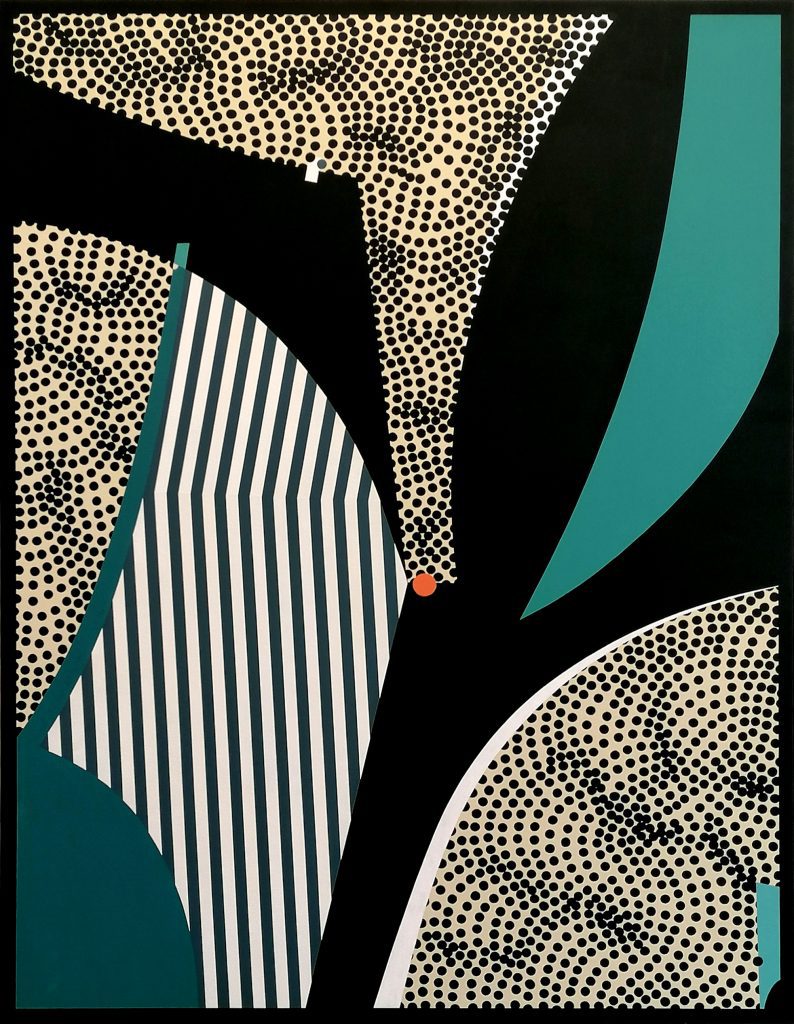
This is an audience that you haven’t really had much experience with, but based on what you’ve experienced so far at Fiksate, and the people who have come through, have you been able to get a gauge of what you might expect?
AP: You know, we don’t really know what is going to happen…
RS: We are not expecting anything, but we don’t really make work in that way.
AP: All the thinking was to make these works because of the inspiration this experience has given us. It isn’t about what we will sell, it’s more about what we would love to present.
RS: We like working in this very expressive way. We have thoughts. We start to talk about it. We have a conversation, and then we say: ‘OK, let’s do it, why not? Let’s see what will happen…’ We didn’t expect anything, but we have already very positive feedback.
AP: Yes, although I am still not sure about how the audience will respond to our point of view on abstract.
Right, abstraction has become more and more prevalent within both urban contemporary and mural practice, but New Zealand can lag behind in some trends. Fiksate recently staged their Urban Abstract show and that was perhaps quite new for a lot of the audience, who might have been more accustomed to letter forms, figurative stencils and illustrations, and representational murals…
AP: I was thinking about that, because in most of the cities we have visited, the murals are pretty figurative, abstraction doesn’t seem to be as popular.
RS: But the abstract things here are on a good level. Sculptures or installations, they seem to be in good taste, which we were happy to see.
Robert, you have investigated translating your work into sculptural forms, right?
RS: Yes but not a crazy big amount, I am just beginning to touch on this direction. I started some years ago. It is not super easy to do, but I want to keep going because it gives me different positive vibes…
It seems like more and more artists are translating their work in different ways, into objects, installations, using light, projections, etc. It seems that more doors are open for artists from the urban realm, due to the popularity and visibility of muralism. Anastasia, how do you think your work would translate into a three-dimensional, or kinetic form?
AP: I have worked with smaller forms of sculpture, but I am probably more interested in installations. I have a lot of ideas, and I’m going to keep going with other projects.
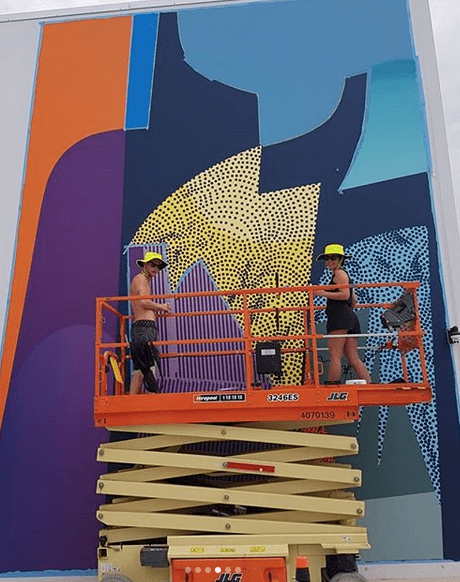
How do you operate in terms of having your own distinct paths as artists while still collaborating? Are you constantly working on your own things and then coming together for certain projects, or has it become more and more about the collaboration?
RS: We like to work in both ways, it depends of the project. Especially for this exhibition, it’s all about collaborative work. It’s nice for us to have the chance to involve our personal distinct paths and create something together.
AP: This is an interesting way to work because we have the opportunity for a dialogue.

It has only been just under a year that you’ve been working together…
AP: Almost a year.
That’s a relatively short time, so there is obviously a lot more to explore within your creative partnership. But long-term working partnerships can sometimes see the distinctions between each artist deteriorate, and a unified aesthetic develop, is that something you are consciously trying to avoid, or do you see it happening?
RS: That is a very open question, because already this year, new things have developed that can support our personal projects and we obviously have days when we want to create something by ourselves. The process is going here and the process is going there and we can mix those possibilities together. It’s super open for us.
What do you have planned for the rest of the year? When do you leave New Zealand?
RS: We leave on the 10th of February. We will go back home to Greece, and then we have something in Germany and a project in France, another project in Slovakia and that’s it for the moment. Maybe a small holiday after that…
It seems like travel is just an engrained part of the urban art movement…
RS: It’s not for everybody though. I’ve got artist friends who do not travel at all, they stay in the studio and that’s it.
AP: And for some artists it is not that important, I mean they feel better in their studio. It depends on the artist.
RS: For me, travel is the research about new places. From when I started painting, my city started to be like, OK, I’ve seen all the streets, all the nice places, I’ve painted here, I’ve painted there, but I need to search for more possibilities. I need to see different things that could inspire me, collect new knowledge and have that energy, this is important in my creative process.
How do you make your work resonate with different places? With abstraction, you aren’t using explicit cultural references, which can be a minefield anyway. Is your visual language such a personal reflection that it doesn’t necessarily need to display that connection to place in any overt way?
RS: I started to realize this a short time ago to be honest, I was traveling for many years and just reached a point where I’ve got things that I start to talk about and understand more. Now, I keep collecting those ideas as I travel, and they come out in my work.
AP: I think it’s important to observe what’s going on in any country because I don’t want to offend anyone. For example, in the Philippines, black is very bad. It’s the color of death. The associations of black mean you don’t use it. We tried to find it in the paint stores, but you couldn’t. When we went there, we didn’t realize how important it was to not use black, but we adapted over the month we were there and we started to realize more things that were important for people there, especially since we were painting a lot on small houses in the middle of the forest.
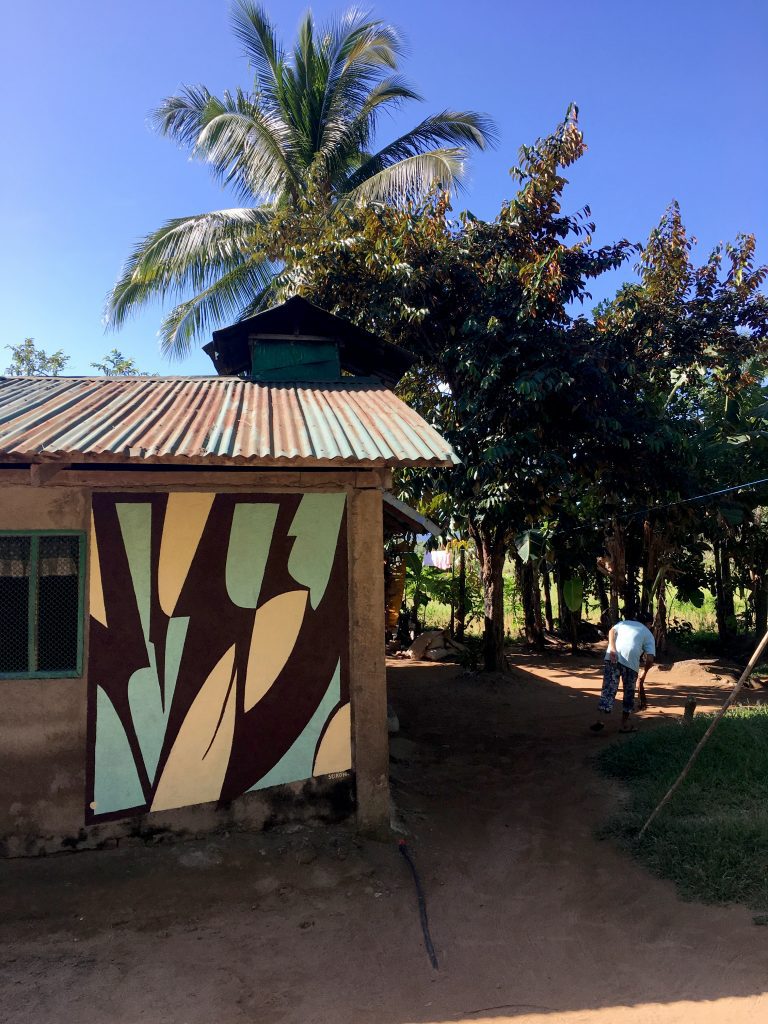
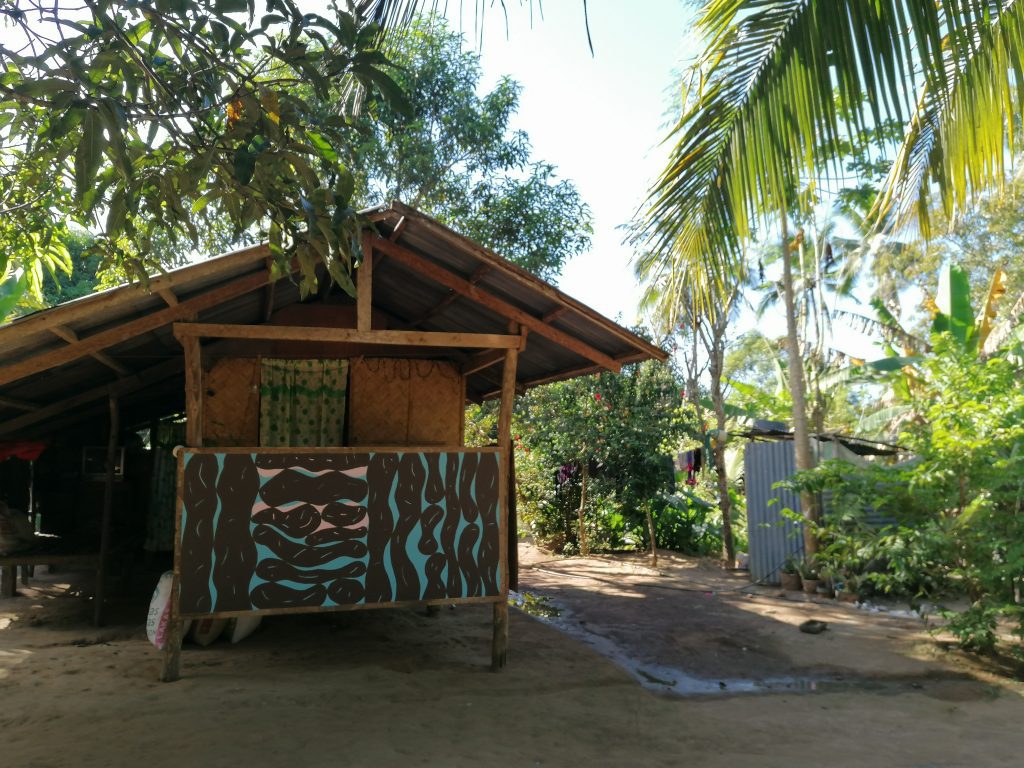
The chance to do research isn’t as easy for some artists, who might not have the luxury of a site visit or to acclimatize, especially if you are moving from job to job and have to hit the ground running in any new place you find yourself…
RS: The perfect situation is where you come to the place and you’ve got some time to prepare, not just going to a place with the sketch, painting it and leaving…
AP: Although it might not be possible, because if you do a big mural, you often need to give something to the people to see…
RS: Yes, but for us, we like to say, this is the sketch but by the end it is going to be a bit different…
Do you want to say thank you to anyone from your time in New Zealand?
AP & RS: Thank you to Fiksate Gallery for the trust and to all crazy positive people that we met during our stay in New Zealand…
Follow Seikon and Papaleonida online…
Long Trip of the Kokos runs until February 29th, 2020 at Fiksate Gallery, 165 Gloucester Street, Christchurch.
And That Was… October 2019 (with Kophie)
Kophie (a.k.a Meep) is busy. Actually, that could be an understatement. From her art, including her increasingly large mural productions, to her clothing brand Future Apparel, and a number of other projects in between that are born of her social and environmental conscience and activism, she always has something on the go. So, when I asked her to compile this month’s And That Was… it was a bit of a double-edged sword – I knew she would have plenty to share, but the challenge would be finding time to put it together! Luckily, Kophie is the type of person who is always willing to help people out, and she was more than happy tell us some of her October highlights…
Flip Out
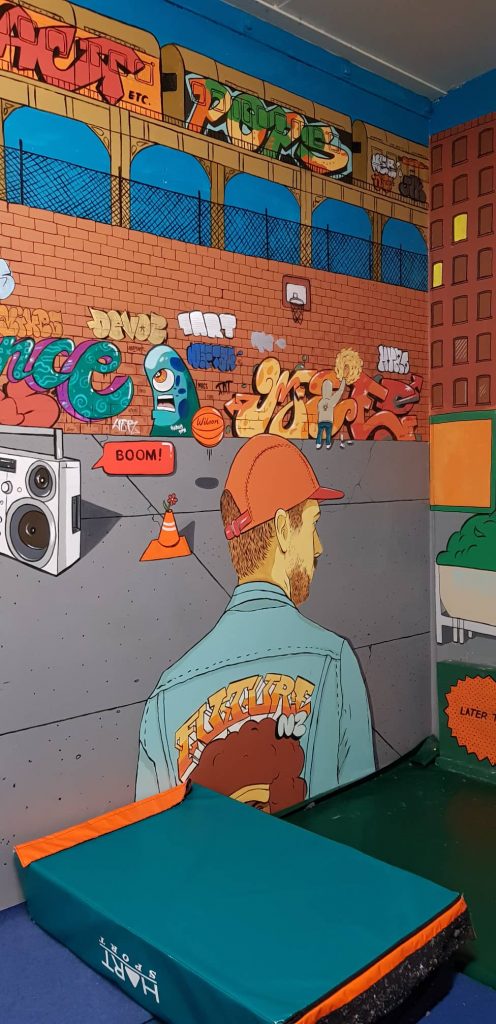
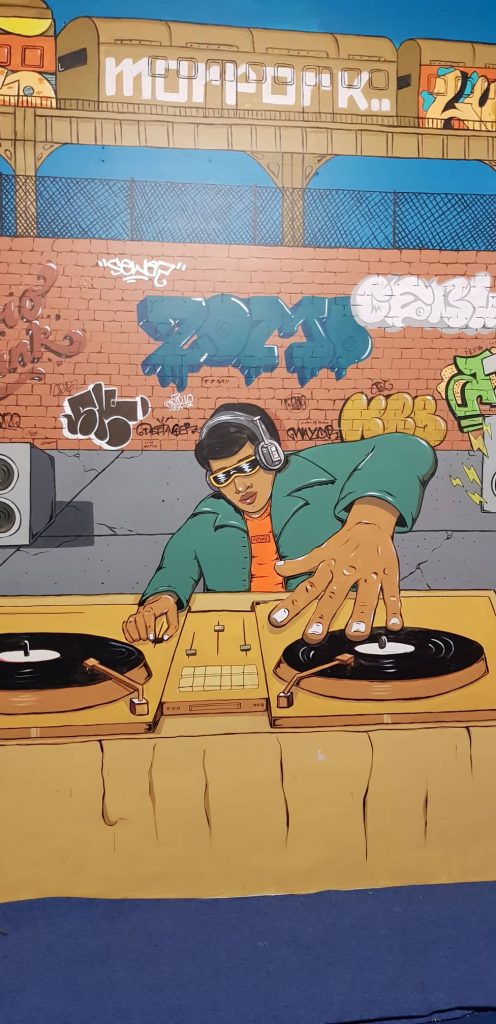
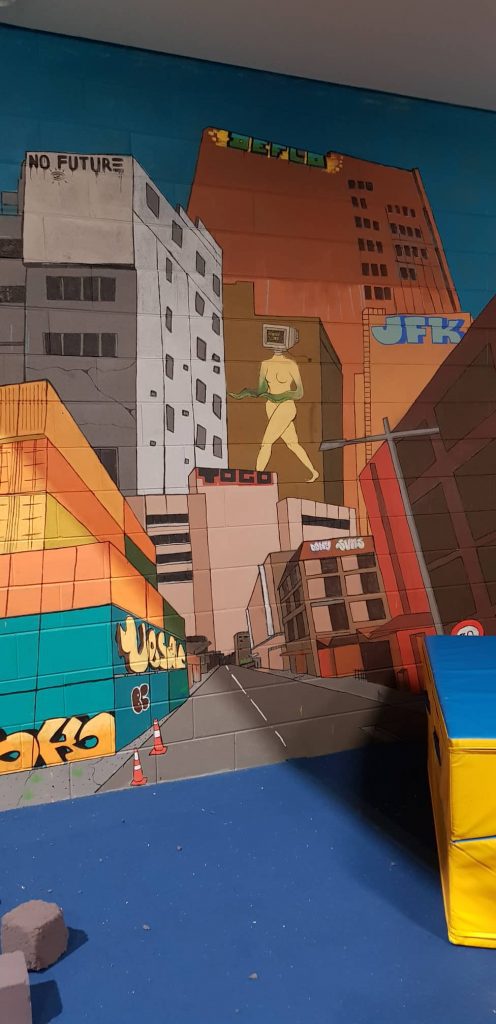
In October I finally completed a massive mural at Flip Out, the trampoline park. It was a BIG project, covering 45 square metres, and taking five months to finish! The concept was drawn from a graffiti comic book called Hip Hop Family Tree by Ed Piskor, which documents the early history of hip hop culture. I used this inspiration to make a mural highlighting Christchurch’s culture, including pre- and post-earthquake graffiti writers as a sort of homage to local graffiti history.
Shaka Bros at Riverside Market
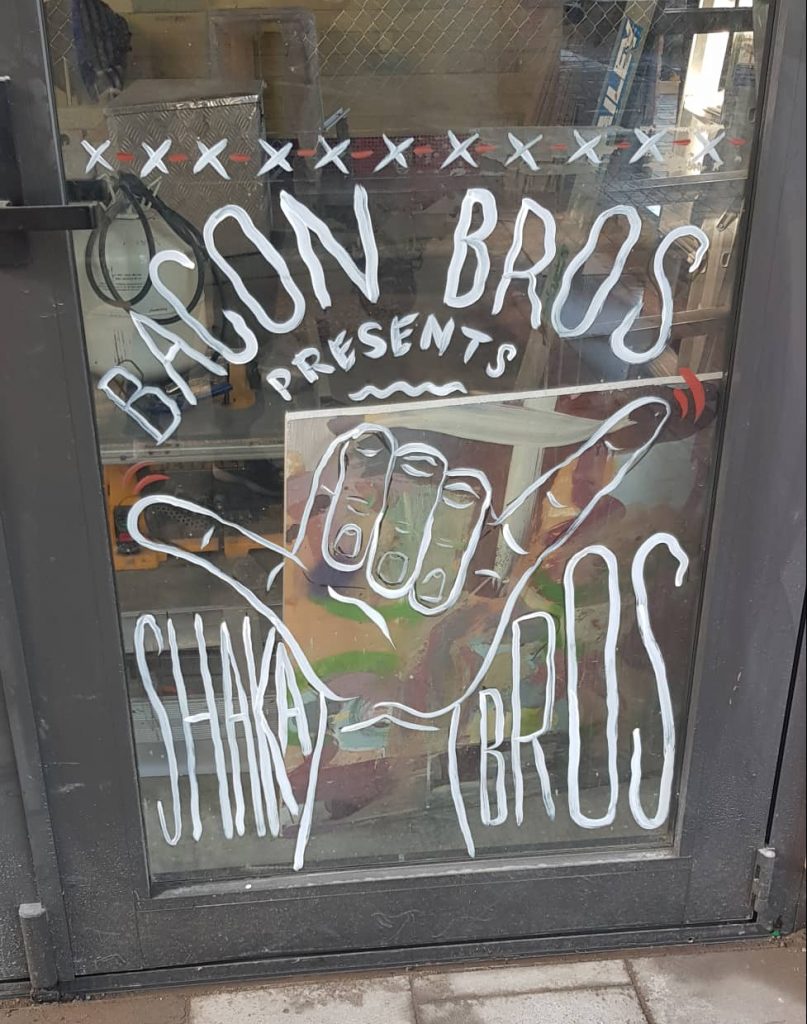
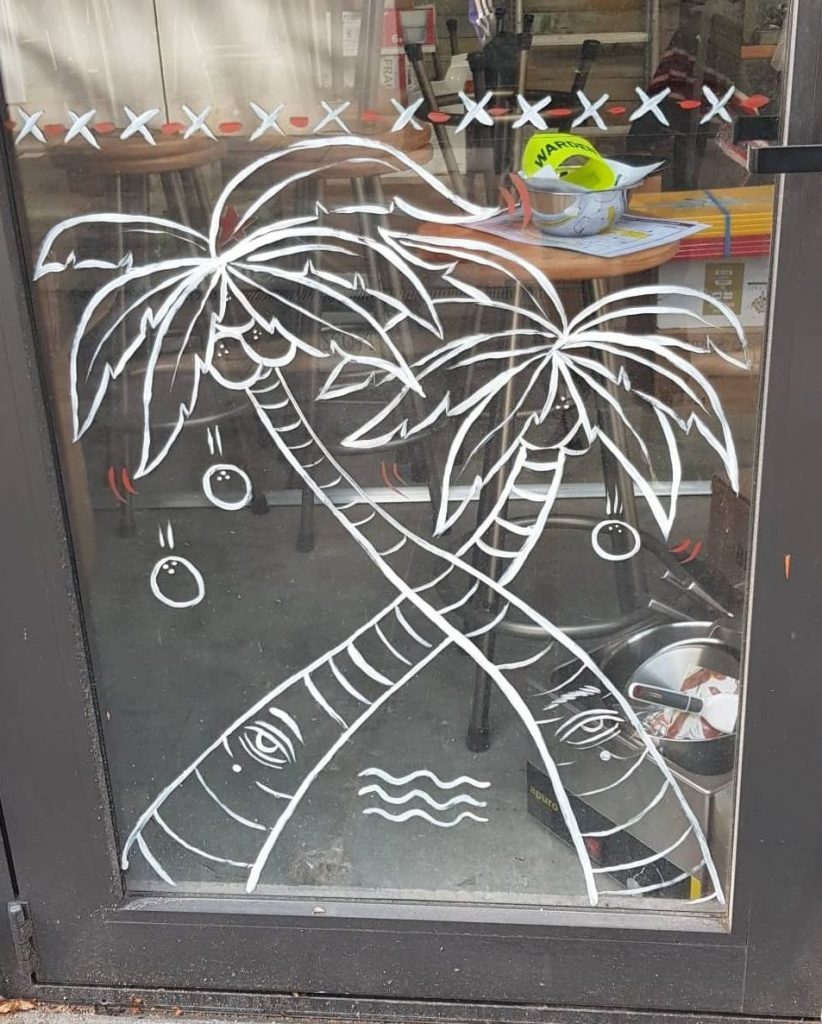

I also recently helped with the fit out for Shaka Bros, which is the new Bacon Bros’ burger restaurant in Riverside Market. I painted murals and added typography all through the restaurant (as well as a little guest outside…). I was really impressed that they used a lot of local suppliers and artists in their build, including Brendan Ryan, CW Works and Dale and Tanya, who made all the furniture from scratch.
Conscious Club Market
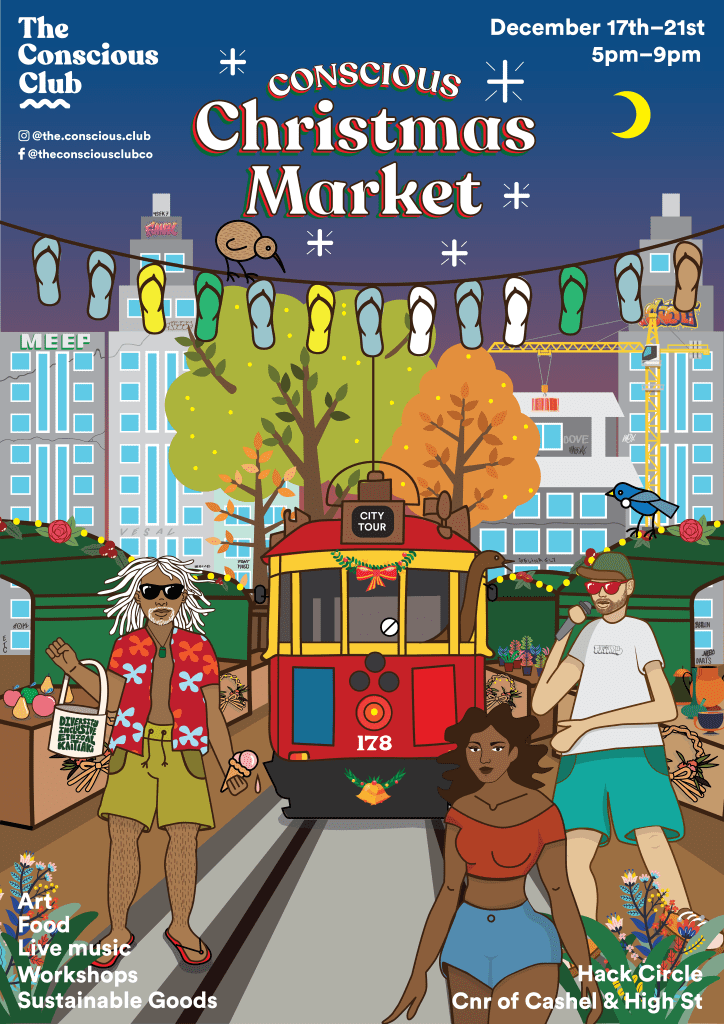
I have been organizing a Christmas market with The Conscious Club. The Conscious Club are a collective of four locally-based women (including myself) who run sustainable and ethical events in Christchurch. The Christmas market will be a five day event hosted in the ‘hack circle’ (where all the Emo kids used to hang out pre-quake in City Mall) surrounded by all the corporate businesses and fast fashion giants. We will have workshops by Rekindle, entertainment, food trucks and 25 rotating stallholders each night, all selling eco-friendly products. It will be a much better alternative to going to the monolithic malls for your Xmas shopping!
Future Photo Shoot
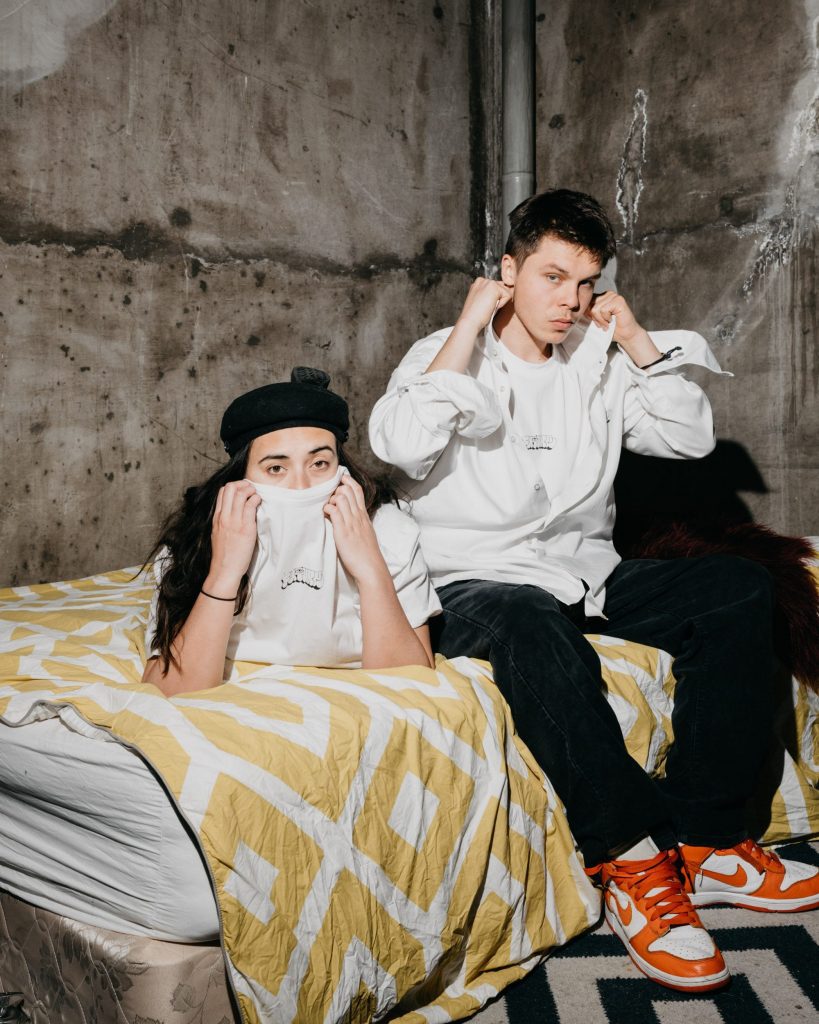
I worked with the amazing photographer Federico Corradi and awesome models Lucy, Ruby, Selina, Callum and Lucas at a super cool building in Lyttelton, taking some great photos for my sustainable clothing line Future Apparel. They look amazing! Future is all about up-cycling clothes to save them from waste, as the environmental impact of the fashion industry has long been a massive concern. I will be releasing the photos in conjunction with my website launch! So watch this space…
My Favourite Song
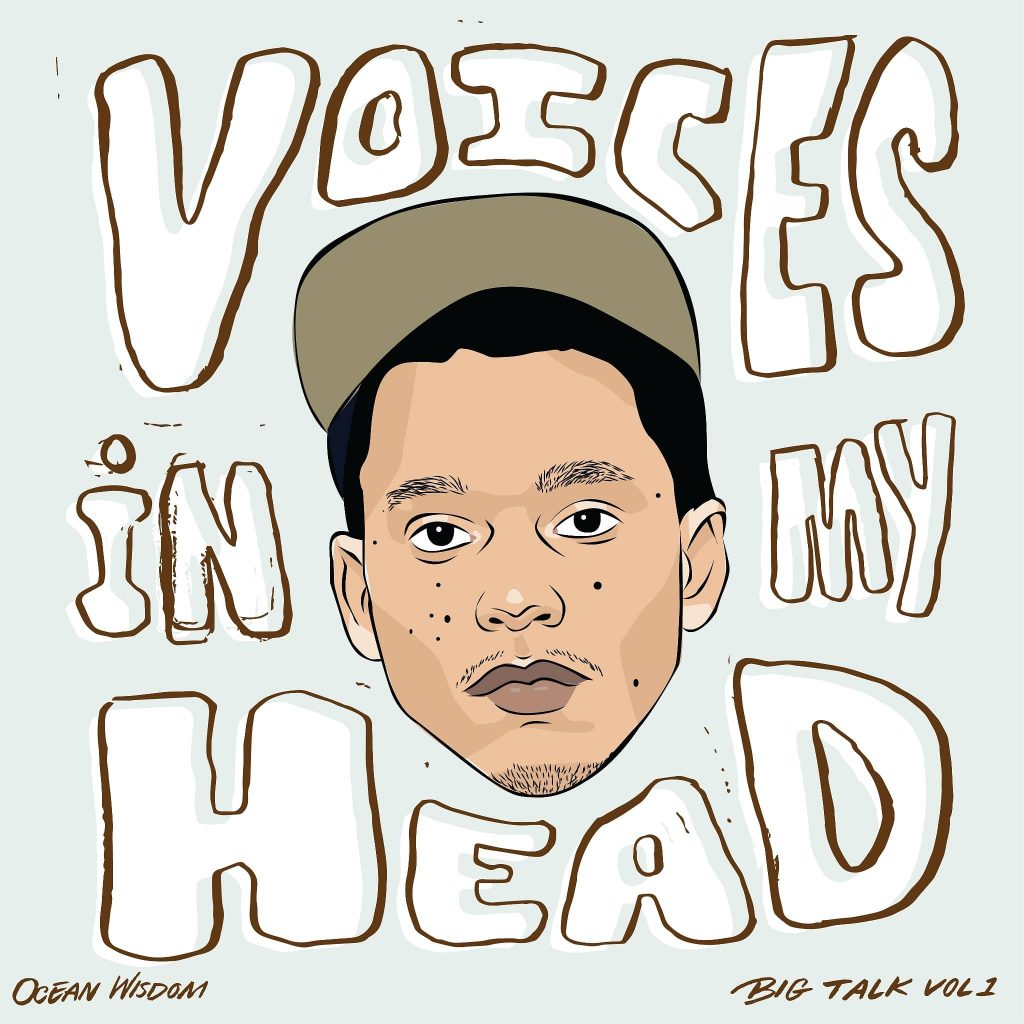
British rapper Ocean Wisdom’s mix tape Big Talk -Vol 1. was released in October and I have been listening to the song Voices on repeat for the last couple of weeks! I was inspired to make a graphic for the song, I loves it so much!
Follow Kophie on Facebook and Instagram to keep track of all her upcoming exploits…
Also follow Future Apparel and keep an eye out for the website launch!
And that was… January 2019
Well, January flew by, right? We thought that since life is so hectic, and the worlds of urban art are often so fleeting and ephemeral, it would be helpful to recap each month with a kind of top five list, you know, like in the Nick Hornby book High Fidelity (or the John Cusack movie adaptation, where Jack Black steals the show, take your pick), or a truncated Letterman Top Ten. We will list five things that we loved during the previous month – from new works, big or small, to events and exhibitions, or even just general talking points. And of course, we would love to hear what you think, so jump in and comment, or send us a suggestion for our upcoming lists…
So, without further delay, here, in no particular order, is the inaugural ‘And that was…’ list for January 2019 (drum roll please…):
- Face Value @ Fiksate Gallery
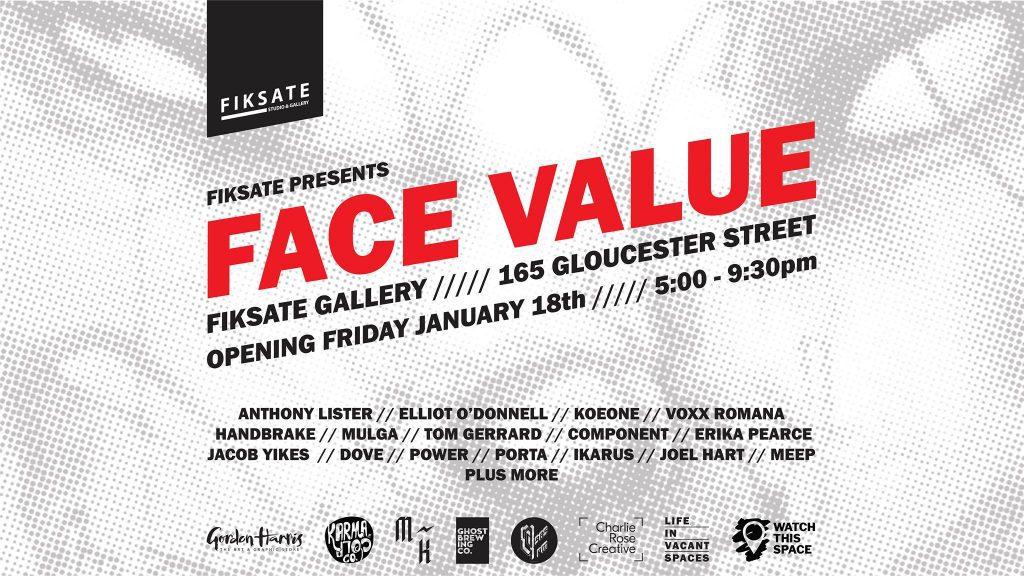
The team at Fiksate followed up the Jacob Yikes exhibition, Bad Company, with another impressive showing – the second incarnation of the Face Value: an exploration of portraiture, figuration, faces and characters through the lens of urban art. The show featured a range of talent, from emerging and established locals, to big names from wider Aotearoa and further abroad, such as Anthony Lister, Elliot O’Donnell (AskewOne) and Tom Gerrard (Aeon). Highlights included O’Donnell’s monochromatic apparition Chloe (Beta), the collective strength found in the juxtaposition of local artist Meep (Kophie Hulsbosch)’s bold self-portrait and the works of Auckland’s Erica Pearce, the elegant chaos of Lister’s Ballet Dancer, and Koe One’s typography-laced black and white portrait of urban youth.
- The Giant Cans get a makeover…
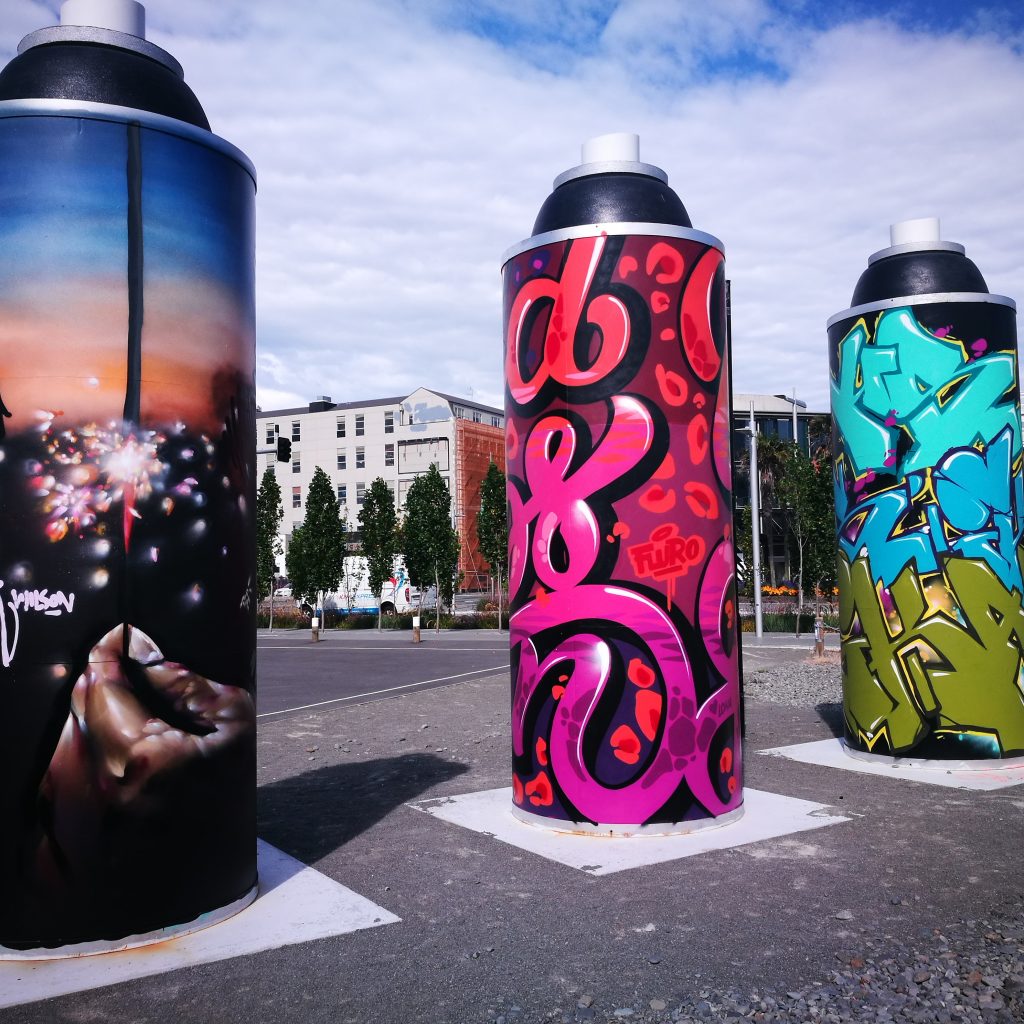
While five cans remain a constant open platform, the three cans that stand aside are designated as semi-permanent. Initially painted by Wongi ‘Freak’ Wilson, Ikarus and Jacob Yikes, in mid-January, the three metal sentinels were re-painted by Ikarus, Wongi and Fluro (Holly Ross), giving them some fresh evening wear for 2019. With Ikarus’ slick letterforms, Fluro’s elegant typography, and Wilson’s photorealism (with some nostalgic cartoon fun thrown in as well), the cans represent a variety of approaches and styles.
- Macadam Monkey chills in North Beach
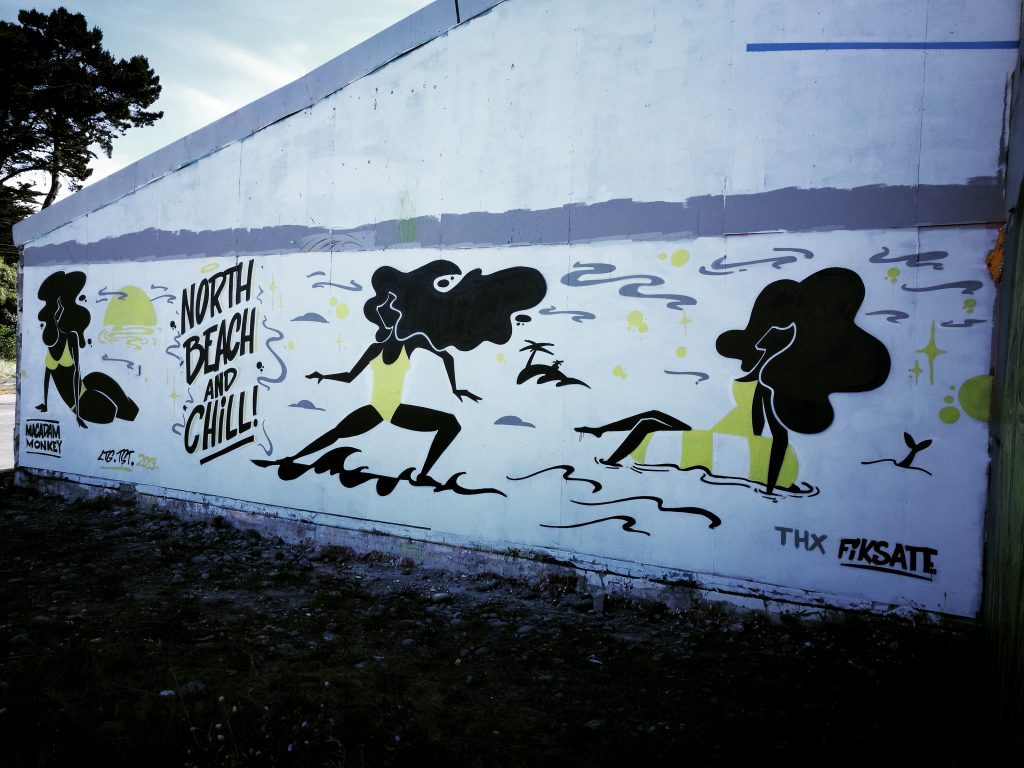
French artist Macadam Monkey spent several weeks in the city in late December and January, and he made the most of his time here. Hitting a few spots with his almost Art Deco-styled, elegant females as well as more traditional lettering, our favourite was probably his appropriately titled ‘North Beach and Chill’ wall beachside in North New Brighton. The refined (and recurring) colour palette of black \, grey, yellow and white added to the chilled vibe and the work itself seems to have the potential to be something of a small-scale landmark for the area (although time will tell of course…).
- Juse1, VRod and Torch in New Brighton
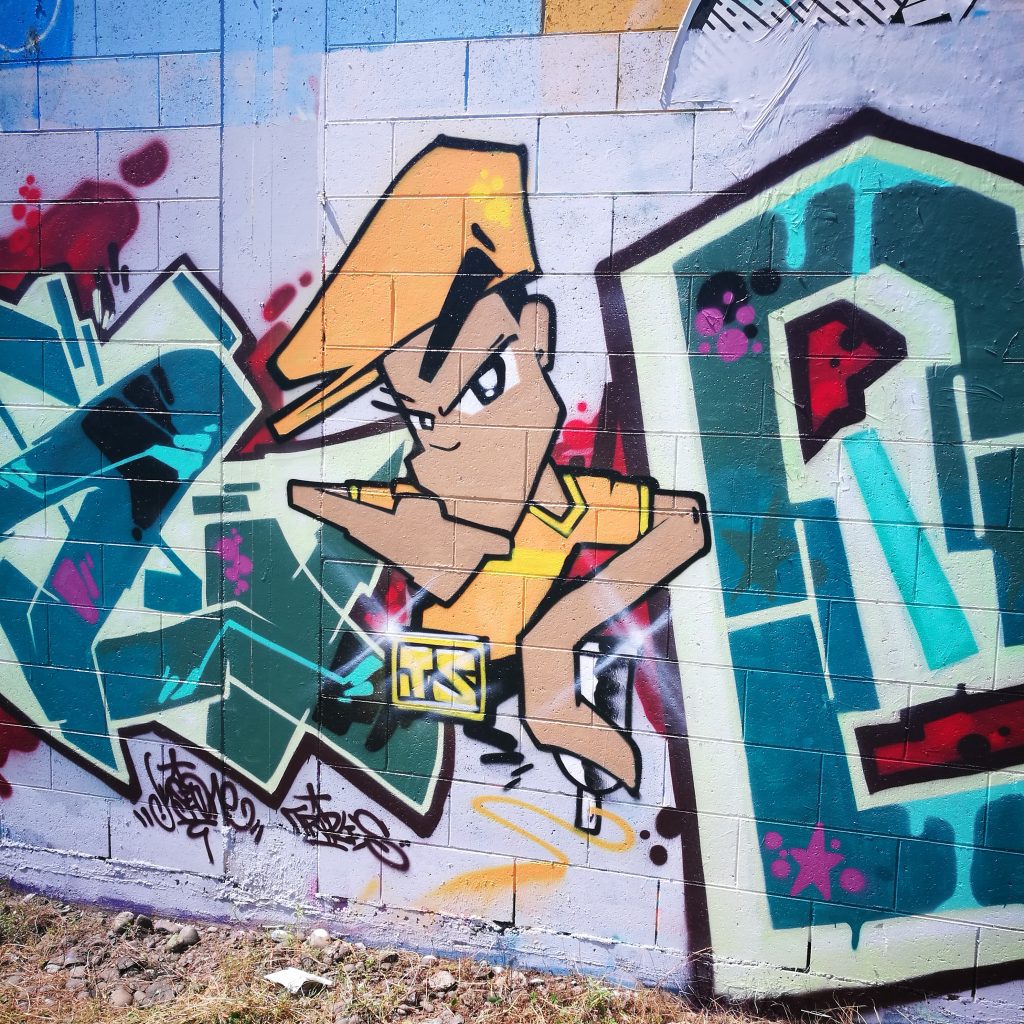
It was something of a meeting of generations and locations when Wellington legend Juse1 visited Christchurch. He spent time painting with local writers VRod (who hails from Auckland but is based in Christchurch) and Torch, and while the Hereford Street spot was a blink and you’ll miss it deal (in fact there have been a number of pieces there that could have made this list, shout out to Tepid, Lurq, Ikarus, Dove and more), their sprawling production in New Brighton has shown more legs. The pieces add to a vibrant setting, and Juse’s iconic B-Boy character adds a perfect nod to hip hop culture, as if it is straight off a New York subway train circa 1982, albeit still fresh to death…
- Jonny Waters, Dizney Dreamz @ Anchorage

Dunedin-based artist Jonny Waters goes by a few names, but one thing is always consistent: his playful, twisted aesthetic, which was on full display in Dizney Dreamz at The Anchorage on Walker Street. Presented by Kin Art, the show featured a new series of Waters’ cut-out characters, this time iconic (and several overlooked) players from the world of Disney cartoons (his previous works have taken on Looney Tunes, Rugrats, Sonic the Hedgehog and The Simpsons). While the silhouettes are familiar and intend to invoke a feeling of nostalgia, the details take the viewer on an unexpected trip; eyes where they shouldn’t be, limbs and heads protruding from fresh wounds. All these features are accompanied by a fine technical detail, with layered sections, perfectly imperfect lines and a use of various media.
Shraddha Shrestha – Shared Lines
Shraddha Shrestha is an example of street art’s truly global spread. In mid-September 2017, the Nepalese designer, illustrator and street artist arrived in Christchurch, by way of Glasgow (where she was completing her master’s degree in design), as a guest of local adventure clothing company Kathmandu. Shraddha’s journey to Christchurch signalled her selection as the inaugural artist for Kathmandu’s ‘Artist Series’ t-shirt collection, a project in support of the Australian Himalayan Foundation.
Shraddha’s arrival was marked by a ‘Nepalese street party’, where she and local hero Wongi Wilson painted on shutter doors in the laneway outside Kathmandu’s offices in the ‘Innovation Precinct’. Also featuring music and food trucks, the event provided a lively activation of the inner city area. Shraddha’s t-shirt design for Kathmandu, Yeti meets doko, exemplifies the artist’s distinct style; a mixture of contemporary illustration and pop culture with old world references. Her whimsical imagery and repeated patterns are immediately endearing, drawing on her own cultural identity and love of popular culture, meshing together in a playful, but often poignant synthesis.
I was able to get to know the softly spoken Shraddha as she painted a wall in New Brighton, observing her approach and chatting in between painting sessions. After initially planning to sit down and record an interview, a series of unexpected obstacles instead ensured we conducted a back and forth via e-mail in the weeks following Shraddha’s departure. The result is an interesting insight into Shraddha’s background, her perceptions of Christchurch and the growth of street art in Nepal…
Shraddha, tell us more about how you came to be in Christchurch. What is the Himalayan Foundation Art Award and what impact has it had on your career?
I was awarded the Australian Himalayan Foundation Artist Fellowship in 2015 by the Australian Himalayan Foundation (AHF). The AHF is an NGO (a not-for-profit non-governmental organisation) in Sydney, Australia, who work towards the improvement of life in the mountains of Nepal through things like education, health and sanitation. Each year the AHF awards fellowships to two artists from Nepal, and I was one of the artists in 2015.
Through this recognition, I was connected with the clothing company Kathmandu, who collaborate with AHF and have been contributing to the education, health and welfare of the communities in the mountains of Nepal. This year (2017) is Kathmandu’s 30th anniversary, and for the occasion they were planning to bring out a limited-edition t-shirt designed by an artist from Kathmandu. So that’s where I come in. In September 2017, they invited me to the t-shirt launch in Christchurch. I was also invited to an AHF fundraising gala dinner programme in Sydney.
The fellowship has allowed artists to create their own bodies of work and exhibit in the very well reputed Siddhartha Art Gallery in Kathmandu, Nepal. Winning the fellowship was a huge deal, as I was supported to create my own exhibition. After the exhibition and the fellowship, I am now one of the contributors towards AHF and it’s social work in my community. The award also helped me build a stronger portfolio and to get connected with many art enthusiasts and art buyers in Nepal.
How did you find working with Kathmandu? For many artists, it is important to know that any company they work with has a strong ethical foundation…
Working with Kathmandu was an absolute pleasure, they have been very supportive. I did not know the company properly before, I just knew that their brand name was the same as my home town. After I started working with them and after I visited the head office in Christchurch, I was surprised by how much work and time they invest in creating their products and trying to make them as environmentally friendly and ethical as possible. I got to meet the team there which was amazing! Most importantly, I observed that the people working for Kathmandu are so motivated and conscious about how the company works and their objective of making ethically manufactured products.

While you were in Christchurch, you managed to fit in quite a few adventures. You spent time in the North Canterbury village of Cust, painted in both the CDB and New Brighton, and you also went surfing and skiing. What were some of your impressions of Christchurch?
I found Christchurch very interesting, unlike other big cities, I felt it was very open and spacious. It must be because of the earthquakes, since there were less high-rise buildings. It felt like Christchurch had a bigger sky! Since I am from Nepal, I am more used to hills and mountains than flat land, so when I saw hills when I was in Christchurch, it felt a little bit like travelling back home. It was so amazing that you could see the mountains and the sea in one day! The sea always fascinates me because we don’t have oceans back home. The first time I saw the sea or touched sea water was just two years ago. I like adventure sport and I like trying out new things. When I was searching the internet for things that I could do during my visit to New Zealand, skiing and surfing were suggested. I had to do both as there is no skiing in the mountains and there is no sea to surf in Nepal. And I did it! and I loved it! I will definitely do it again if I get a chance.
I found the people in Christchurch very friendly and sweet! I especially felt this when I was working on the wall in New Brighton. Many people who passed by the wall smiled and greeted me and talked to me. It was very nice to talk to them and talk about the artwork I was doing. Moreover, they were from different age groups, small kids or old grandmothers, they seemed to be interested in what I was doing in their part of the city and they tried to talk to me which is really nice and heart-warming. Even today I get messages from people from New Brighton in my Instagram, complimenting me about the wall and asking me if I am still there! They make me want to come back again!
It was also interesting to see how the street art scene has become an important part of the city. The people of Christchurch love their street art and the street artists! They have accepted the art form as a way of them rising from the devastation of the earthquakes and a way of rebuilding which is very positive and motivating. I feel that it not only promotes the art form and the artists, it also makes art as a part of life and the city’s development. We need this approach and attitude back home in Nepal as we are rebuilding from the effects of an earthquake too. [Nepal suffered a massive earthquake in April 2015, with thousands of people dead] We are also trying to help people to get over the devastation through art events, workshops and of course street art. Now I feel that we need to continue this process like Christchurch has done.

How did the shared earthquake experiences of both Christchurch and Nepal influence your perception of Christchurch’s ongoing rebuild?
As I explained before, I found it very motivating as an artist and as an art lover how the city of Christchurch has accepted art to re-emerge and rebuild from the natural disaster. But I also think there are other connections between Kathmandu and Christchurch, or even Nepal and New Zealand more generally, other than the earthquakes, for instance, Sir Edmund Hillary climbing Mt. Everest along with Tenzing Norgay Sherpa, a Nepali mountaineer. During my trip to New Zealand, I talked to some people who sadly did not know the place ‘Kathmandu’, they only knew ‘Kathmandu’ as an outdoor adventure clothing brand, so I guess it depends on who you talk to…
You explained that street art is very new in Nepal – there is really only five or six years of history. How did you come to be a part of the culture and how did you start? Did you have any specific influences?
Yes, street art is very new in Nepal. Although, we have traditional and religious murals which are hundreds of years old, the contemporary idea of street art is new. The street art scene started to grow in Kathmandu around 2010. During my Bachelor’s program around 2008, I was very interested in graffiti. I used to see it on television, like on MTV and Vh1 music videos and in magazines and books. Also, in Kathmandu, we have a lot of political vandalism, political writing and propaganda on the walls. If you ever visit Kathmandu, you would see a lot of big writing in red colour. I used to think, if people can do that, then why not do it in an artistic way like graffiti? I started to sketch, make my own graffiti in my drawing book and tried to copy the style of graffiti artists. That’s how I started to explore. At that time, street art was very rare in Kathmandu, and very little graffiti could be found in small alley ways and in some restaurants made by some tourists visiting Kathmandu.
Later, around 2010, a French artist based in the USA, Bruno Levy, produced big pieces in several parts of the city of Kathmandu. His works were very vibrant and provoking. After seeing his work around the city, I felt that if a foreign artist can do it why are not any local artists doing it? I think from his work the young artists of Kathmandu really got into the medium. Me and my other friends then started to work together and experiment in the street. The good thing there was that it’s not illegal to paint on the street like other cities all over the world. We could paint in the broad day light and nobody would stop us, unless it was a private home or property. That’s how I started painting on the street. From there, our group got bigger, we had more artists who were interested in street art like us. We did a lot of collaborative works creating big pieces. Gradually street art projects started to happen which brought in other street artists from other countries, commercial companies, embassies, and NGOs started to recognise the art form and its growing public profile. So, artists started to get support from these types of organisations. At present street art is one of the growing art forms in Nepal and I can say that within these short six to seven years, we have been successful in bringing up many talented artists who right now have been successful in showcasing their works worldwide. Of course, street art is a truly global attraction, so it isn’t surprising that it made its way to Nepal as well.
Is there a graffiti culture in Nepal that is at the roots of street art, or has the culture grown from different influences – travelling artists, online access to the global popularity of street art?
The street art culture has definitely grown from different influences. Travelling artists, online access to the global popularity of street art, media like television and books and magazines, local artists travelling abroad and more.
Did working in the streets influence your illustrative style, or was your street art influenced by your illustrative practice and the art you were already making? And how have these influences evolved?
My street art is influenced by my illustrative practice and my drawings. I was already working as an illustrator and graphic designer when I started with street art. I started with characters and free-style graffiti. I enjoyed how my small drawings of these characters transformed after I painted them on the street. It is like watching a tiny thing grow into something huge, which fascinates me a lot.
I am very much into stories, children books and character designs. I like the concept of monsters and aliens and I am very much fascinated by the iconography of Hinduism and Buddhism. I try to merge the traditional icons with modern styles and create my own characters. I am from an indigenous society from Kathmandu known as Newars, whose lifestyle is heavily influenced by Hindu and Buddhist religion and iconography. Therefore, my art works are inspired by these influences.
I am also into stories and narrations, I do storybooks, zines, comics. One of my inspirations is Herakut, I love their illustrative style and the messages and stories behind their work.
I love the mixture of your local culture with the influence of 90s cartoons, can you explain more about this combination? It also feels like there is a strong narrative element in your work, but it is subtle and suggested rather than too obvious – are there autobiographical details or do they draw from observations, or fables/stories etc.?
I grew up in a very old city called ‘Patan’ in Nepal in a traditional society. It is surrounded by medieval temples and palaces and is famous for its wood and stone carvings and metal sculptures of Hindu and Buddhist deities. As I said, I am very interested in Hindu and Buddhist iconography. For example, Hindu gods have three eyes, ten hands, four heads and blue skin. These are some of the unique physical characters of how we depict religious icons in the Hindu mythology. However, if we look further, some of these characters resemble how extra-terrestrial life, aliens and monsters are portrayed, especially in animation and movies. For instance, animations like the Power Puff Girls, and movies like Monsters Inc., they all have characters which share somewhat similar physical characteristics to our mythological icons.
Hinduism is based in cosmology and spirituality and does not have any fixed governing bodies. It is more of beliefs and traditions that on should follow. Therefore, perhaps, these religious icons too are from the outer space, perhaps, the gods and goddesses reside in the eternal galaxy. This is the idea that I play with when I design my characters. Therefore, these characters look whimsical and often monster-like.
Your process combines stencils and freehand painting, creating a strong, crisp graphic style. How did you come to explore the stencil technique? Particularly the repeated forms that create decorative patterns…
The work is very much inspired by Bruno Levy, the use of stencils and patterns too. Also, Nepali culture has lots of patterns like in traditional clothing and architecture, so I try to bring it into my art work. I like stencilling because it is a very efficient medium. I like my work to be neat, with sharp clean lines and fills, which is another reason why I am drawn to stencils.
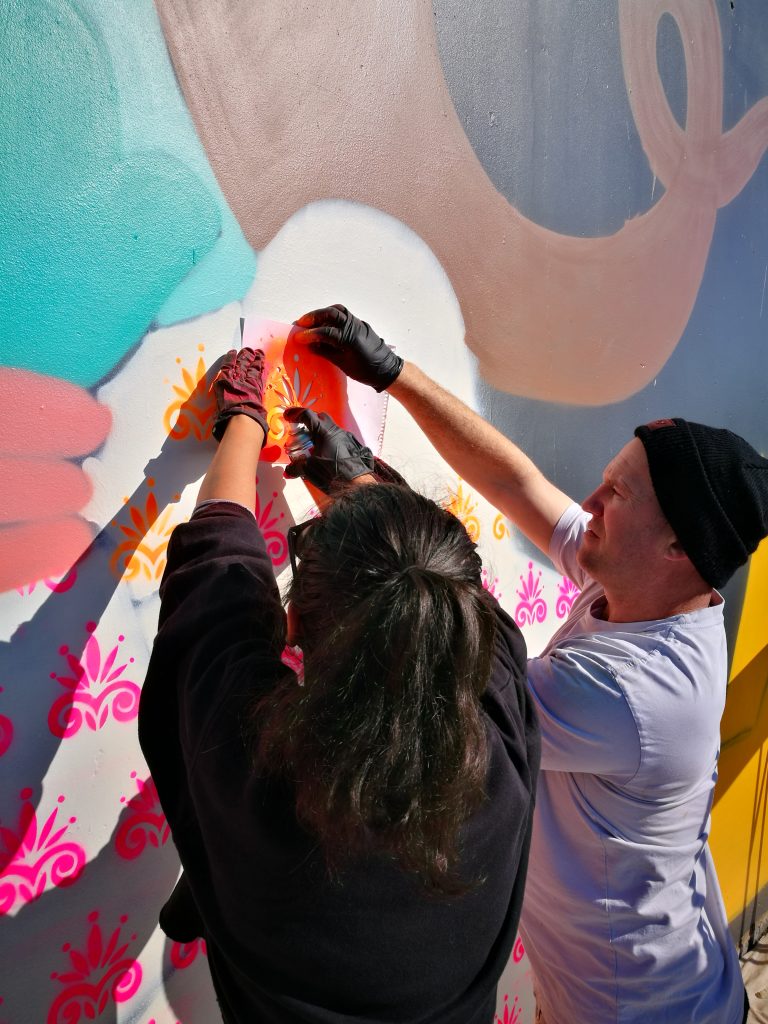
Watching you paint, you seem both very thoughtful but also very confident in a technical manner – do you feel that combination when you are working?
I am not that confident technically to be honest! I do not have much experience working with spray cans. Back home we don’t get proper graffiti spray cans. Therefore, whenever I get the chance to use brands like Montana or Molotow, I get very excited and try to learn as much as I can. I used to work with acrylic paints back home. I am more confident using a brush. I have to have a sketch before I paint on a wall. I need to do the basic planning at least before I start. I find it difficult if I do not have a sketch, and get very conscious of making any mistakes. Perhaps that is why I do the outline with a brush as am not confident with free-hand spray paint. Since I have graphic design as my background, I feel that my work is very graphic, using flat colours, patterns, bold outlines and more. I apply this style to my murals too.
Thanks Shraddha, I hope we see in Christchurch again soon!
Follow Shraddha on Instagram (Macha_73) and online (https://shraddhashrestha.carbonmade.com)
Cinzah – Something Bigger
Napier artist Cinzah has a calm, relaxed demeanour. But that laid-back manner belies his busy schedule. The artist, whose work spans muralism, fine art, illustration and beyond (in 2012, along with his friend, filmmaker Karl Sheridan, Cinzah produced Dregs, the first feature-length documentary film about the New Zealand street art scene), is a regular in festivals around New Zealand, Australia and further afield, exhibits his studio work, completes commercial commissions, and in addition serves as the regional director for the Sea Walls New Zealand mural festival, working with the international PangeaSeed Foundation, a not-for-profit ocean conservation organisation. Add to the mix a young family, and you get the feeling that you might be able to do more with your time.
I first met Cinzah in 2012 while he was shooting through Christchurch on his way to Dunedin to film for Dregs. I was able to hang out, watching while he painted a wall in a dishevelled post-quake New Brighton well into the night. Some five years later, we were able to catch up as he painted another wall in New Brighton, this time for the event Street Prints Ōtautahi. There was a fitting quality to his Street Prints station, returning to the seaside village, but this time under very different conditions and surroundings. We sat down at a rowdy suburban pub, and between bursts of classic rock cover music, reflected on Cinzah’s varied experiences, his distinctive style, and the street art and mural culture in Aotearoa…
So, Cinzah, like many of the other Street Prints Ōtautahi artists, it has been a pretty busy few weeks, you basically arrived in Christchurch straight from the Street Prints Mauao event in Mt Maunganui. With such a hectic schedule have you had a chance to think about the different environments? Although both events come under the Street Prints umbrella, just from a physical point of view, they seem like quite different locations in which to be painting, have you reflected on the change in setting and the distinct qualities of each event?
We kind of all just arrived and hit the ground running. It’s been flat out from Street Prints Mauao up in Tauranga, straight down to Ōtautahi. But yeah there’s definitely differences, in terms of the geographies. Tauranga, Mt Maunganui, it’s a very beachy town, with summer vibes you know, it is very tourist-orientated, whereas down here, the architecture’s completely different, the mix of gothic and Victorian English styles and straight up rubble and construction stands apart from the Mount. Obviously, things are still in repair and there’s a lot that’s still going on, it’s also really interesting to see how the quake and rebuild has affected the local graffiti scene, with the last few years of festival-produced works, large scale commissions as well as the juxtaposition with unconventional, un-commissioned, guerrilla works and interventions, like the array of graffiti. It’s good to see all the different elements of the culture are alive and thriving. There’s basically no graffiti in Mt Maunganui, apart from what we’ve produced over the last few festivals there. (Laughs) So yeah, that’s an immediate difference…
There is an echo for you specifically at least, painting by the sea in New Brighton, you’ve still got the ocean air…
Yeah, exactly, except that it’s arctic! The easterlies are chilling my balls! (Laughs)
Welcome to Christchurch! (Laughs)
Yeah! (Laughs)
There’s also a nice personal narrative for you because in 2012 you painted in New Brighton during a brief stop-over in Christchurch. Looking back, how has the area changed in terms of your personal recollection?
There’s a lot more art. More public works, graffiti, interesting uses of abandoned spaces, some good cafes, and Fiksate Gallery is an awesome little addition to the hood. When I came through in 2012, there were the odd piece around, the main mall was all just shut shops, there was basically nothing open. I started painting one little semi-abando (abandoned building), which had been partly demolished, and I remember one guy coming out, I don’t know if he had one of the businesses there, but he basically gave me permission to paint the entire street: ‘Oh yeah, you can paint here, or you can paint here, you can do this shop or that shop…’ It’s great to see positive changes here, there’s a lot of potential for this neighbourhood, its good to see people inhabiting these spaces and the community taking ownership. New Brighton is heading in a positive direction.

You have a lot of festival experience; do you have a process for getting to know cities and places? Is it just hit the ground running and get a vibe as you go, or do you like to spend a little bit of time exploring before you start painting?
Definitely, if the schedule and life allows, I like to have a day or so on the ground to acclimatise and adjust to my environment and the surroundings. I like to get out within the community and meet people and talk and get a feel for what’s going to work in that environment, what sort of work would suit, depending on what is going on around there, and also just to get a feel for whether the community is supportive. Is art really going to add to that environment or will it detract from things that might be happening there? I usually have a preconceived idea, or concept mocked up before arriving, but I like to allow room for this to breathe, grow and be influenced by my surroundings and experiences that may present themselves.
There is a definite responsibility, right? It feels as though within the muralism movement there is a growing recognition of the need to respect and engage with locations and the communities, not just the people, but with the local cultural, social and even spiritual histories and narratives. Have you found your thinking around these issues has had to grow as you’ve been more involved in events? You offer an important perspective as both an artist and as a festival organiser…
Yeah, definitely. You’ve got to look at the motives behind an event. What is the purpose of the festival? Is it just a beautification project? Does it have a specific mandate to engage people into deeper discussions socially, politically or environmentally, or is it contributing to an act of gentrification? More and more cases of this are popping up globally with big developers and corporations that have an ulterior motive behind these events, pushing out homeless to allow for new hospitality hubs and ‘arts’ districts, where artists can no longer afford to live. It’s important to do your research before getting involved in a project. I’ve always considered my environment and held this responsibility fairly close to heart, although I’ve been walking this walk a lot more frequently lately with my role within PangeaSeed, working in small communities, with local iwi, tangata whenua and so on. Art can be considered invasive on some notes when a festival rolls into a town, produces a bunch of work and leaves, without following certain protocols or doing the proper research. As a result, the locals can be left feeling startled, without the opportunity to express their unique voices and stories. The work needs to be well considered and thought out, it’s important to engage with the local communities, and create work that is relevant, that acknowledges and speaks to it’s audience.
With that changing ethos, and the strong socio-political foundations of many festivals, it also raises questions for both artists and curators. Do you select artists who already engage with specific concepts that suit a theme, or present a challenge to artists with an interesting visual style to expand their work into new areas? As an artist how do you respond to a brief that is possibly outside of your existing approach?
With Sea Walls, first up, the artists we work with need to be good people, produce good work, and be easy to work with. We often approach artists that dabble in the environmental arena thematically, although it’s a bit of both. If someone has killer work, and can tackle a massive wall, but hasn’t experimented with work that relates to the mandate of PangeaSeed, that doesn’t limit their opportunity. We have a massive family of over 200 contemporary muralists from all around the world, and this whānau continues to grow.
Personally, I really enjoy responding to a brief, it’s good to have some boundaries to get the ball rolling, to spitfire ideas off. Working in the public arena artists have an integral role to deliver a message with our work, it’s an amazing opportunity to really say something when you’re thrown a giant canvas smack bang in someone’s town. It can definitely be challenging at times to work within a guideline in a festival environment. With these two Street Print festivals, Tauranga’s theme was: ‘He aha te mea nui o te ao / What is the most important thing in the world? He tangata, he tangata, he tangata / The people, the people, the people.’ I think that theme really hit the nail on the head for Mt Maunganui. The works created a really strong identity for the area and paid homage to many important local figures, it really connected with the people that will be living with these works.
Graffiti and post-graffiti have traditionally been about a search for personal style, and that’s where this challenge really becomes apparent: evolving a personal style to make it engage with issues or ideas raised for a specific event or commission…
Tauranga’s theme lent itself perfectly to the majority of the line-up. Portraiture was pretty dominant, there was Fin Dac from Ireland and he paints his female portraits, Adnate was over from Melbourne, his work often focusses on indigenous people with a hyper-realistic kind of approach, Mr G, Askew, who has been going in different directions recently but still has elements of figuration and portraiture within what he does, Claire Foxton, I could keep rattling them off… A huge amount of the line-up were portrait artists, so that becomes a really fitting interpretation of the theme behind the festival. But I think when you throw somebody in who maybe has a graffiti background, like writing letters, or somebody who has more of an abstract approach, or just doesn’t paint figures, then you’ve got a whole other super interesting hurdle, you’ve got to think outside the box as to how you approach things.
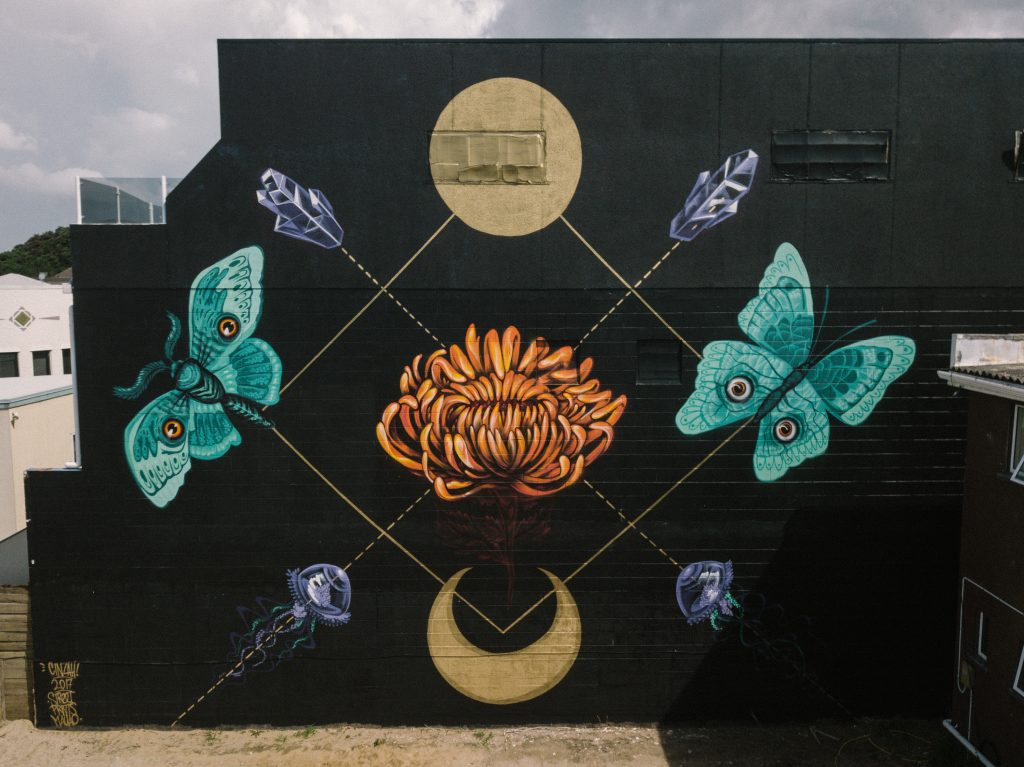
A lot of that comes down to public reception as well, right? Because it is generally easier to understand portraiture, and that human connection, I mean that’s why it has always been such a prominent theme. So, it’s not so much that it’s not possible when you’re dealing with graffiti letter-forms or abstraction, it’s just that possibly achieving that immediate level of understanding is more difficult…
Exactly, it is instantly recognizable or relatable, but art is all subjective, it is all open to the viewer in terms of the interpretation of the work. People make all sorts of calls as to what my work is about. Sometimes I paint things that are super obvious as I want to deliver a strong, direct message, other times it’s a little more expressive and abstract and that’s when you get all sorts of interesting responses to the work. In San Diego I painted a 35 metre long wall depicting local shark species, with a massive 100,000,000 type piece in the background, as this is the estimated number of sharks that get killed annually for the global finning trade. I couldn’t really be more upfront and obvious with this work but that was the intention, to be in the public’s face and to educate on the most basic level about this issue. I still get tagged and messaged all the time on social media about this work, people have spread the mural all around the net and it’s become a really strong conversation starter. The works I’ve created for these two festivals are definitely more abstract or symbolic with their meanings, a little more in line with some of my personal studio works and gallery based stuff.
It really shows the growing maturity of graffiti and street art muralism as public art: the ability to engage with and explore themes that haven’t necessarily been part of the culture previously, so this is allowing that growth and evolution to occur, even if it is challenging some of the bedrocks that people still hold dear…
Yeah, definitely. I feel like it adds a whole other level of substance behind the work, it doesn’t make it so much about the artist, it is about a greater purpose and you are addressing something bigger than yourself and it is not flying in on an ego trip and making work that you think is fucking rad and leaving. There’s a little bit more guts behind it, I think.
With Street Prints Ōtautahi, you are painting in New Brighton, you’ve got others painting in Lyttelton, other artists are dotted quite disparately around the central city, is it strange to be somewhat isolated when you are part of something that is essentially a shared experience as a group of artists? You told me about the amazing programme you put on for Sea Walls artists [including cultural excursions such as sailing on waka hourua with Te Matau a Maui, visits to significant local geographical and cultural landmarks, and even giving artists the chance to swim with sharks in shark tanks, giving them a personal connection with the often misunderstood animals], and with Street Prints Mauao, you all spent a night on Motiti Island staying with Mr G’s whanau, these types of experiences must be important elements now, especially with so many festivals and the need for a sense of legacy and identity…
I guess having an extra-curricular programme pulls everyone together. We are all staying at the same place, we’re eating together, we’re hanging out together, we catch up every evening, so you know there is a real community vibe with what we are doing here, but definitely, the map is kind of dotted out, I’m out here like you said, there’s a couple in Lyttelton, others are more central, which in some ways means you’re kind of pushed off the map, out to the side, although I’m really happy about it, its great the festival curators considered other areas that might kind of get left off the map, because of the geographic lay-out of the city. Talking to a lot of locals while I’m painting, they’ve been saying: ‘Oh you are out East side, this is great! Don’t forget about us out here!’ People have been saying it is really brilliant you are out here, because New Brighton needs a bit of love, it needs an uplift, so it’s all been really positive, and I don’t mind because it is a well-organised event, I’ve got my own wheels, so I don’t really feel like I’m miles out from everybody else. It’s a different vibe altogether from Tauranga. Mt Maunganui was a really close circuit, which creates a really seamless legacy of work after the festival, I’m not sure how this will hold up with the separation of the works…
Fill us in a little bit about what your piece. What is the concept? Paint us a picture with words…
The work that I’m painting has got a large moth that’s migrating towards a big golden sphere which could be read as the moon or the sun or whatever, but the concept I was thinking about was how to translate what has been happening here and the idea of the reconstruction of a city, with basically a new beginning, a new birth, a new undertaking or some sort of transformation. So, I was thinking about different ways to interpret that, I was thinking about the life cycles of insects, from eggs, or larvae, to caterpillar to pupa or chrysalis to adult, it’s more or less about transformation and the symbolism of having the perseverance to push forward, to follow the light side and keep progressing against all odds. Follow the light! (not Jesus, unless you’re into Jesus) I want the work to inspire hope… It sounds cheesy, super fucking cheesy! (Laughs)
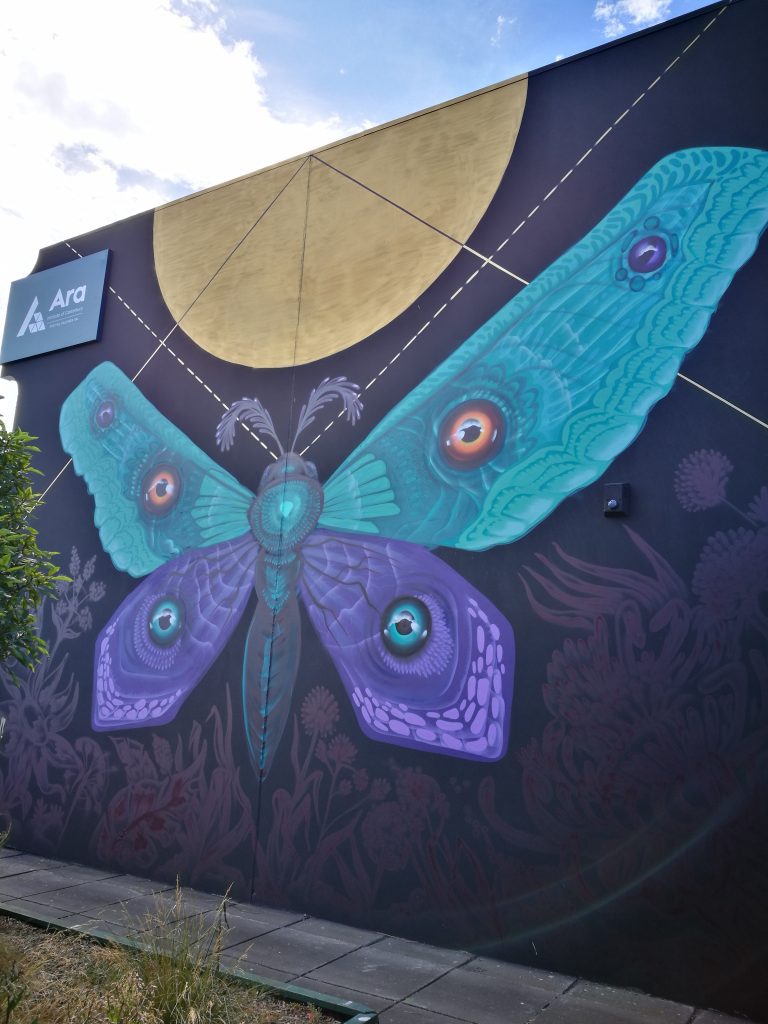
That’s the problem with painting with words, right?! (Laughs) Because the wall looks awesome…
Yeah, just go look at the picture! (Laughs)
In terms of your work more broadly, for me there is a storytelling element that is suggested through almost mystical or mythological imagery or iconography rather than overt narratives. For instance, the animals that you depict, like serpents, moths and even manta rays, for me, they have symbolic associations, but they don’t need to be explicit or obvious to the viewer, and when they are combined with the graphic, decorative style, including the use of gold, there’s a really suggestive quality to the imagery, is that a fair reflection?
I think you’re on the money there, I’m naturally really interested in art that has a narrative, is telling a story, often from different cultures’ folklore and mythology. My works are inspired by life, what ever is going on around me at the time, from physical as well as metaphysical experiences. Some of my works have an iconographic feel, possible due to the use of gold. In my gallery works I use 21 carat or 23 carat gold leaf and actually I’ve done some murals where I’ve used gold leaf in them as well, although due to budget and time this piece is basically straight fat gold chromies. I love the way gold catches the light, it has this other quality to it. I like the idea of creating icons, although I wouldn’t say my works are inspired by religious icons… because I’m not religious at all… (Laughs)
I see them as more elemental, more mysterious, almost ancient symbols that are open to interpretation. With that said, I can totally see them on illuminated manuscripts or something…
Yeah, that’s really awesome to hear because I am inspired by mythology and folklore, and I think it is really interesting to see how ancient civilisations have interpreted events throughout history. I like to weave my own little narrative, and create my own little plots within my work…
You mention your use of gold leaf in your studio works and of gold in different forms in your street works, do you feel like the relationship between street and studio is stronger than it was in the past, or are they still quite distinct for you personally?
Yeah, I feel like they are quite distinct, but at the same time they cross over a lot with subject matter, and lately more thematically as well. I think it is getting more and more seamless, heading in a direction where it is becoming more and more entangled between each other, and I do really want to explore different techniques that I use on my paper works, but on a large scale on walls, maybe limiting the colour palette or potentially going completely monochromatic and seeing how that translates to a large scale. I used to paint really loosely and really gesturally, like the piece I did back here in New Brighton in 2012 with all these loose splatters using Astro caps, Blaster caps and home made jobbies, just making a big fucking mess, and it is so much fun! And I guess over the years I’ve become more and more refined with the mural work and got tighter and tighter and tried to apply as much detail as I can, while holding a really strong graphic approach. I really enjoy painting the way I paint now, but at the same time it can become a little bit clinical, so the direction I’m heading probably brings a little bit more of the looseness and freedom of some of my ink washes and gestural studio works, potentially experimenting with using more acrylics. I mean I don’t think I’ll ever really stop using aerosols all together because I just love them as a medium, but from an environmental point of view, and for the body, they’re not the greatest…
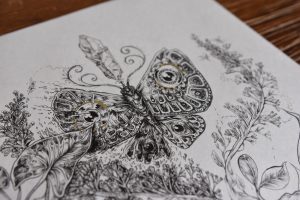
That’s a question a lot of artists are facing right? The paint companies are starting to explore how to combat that, but it is a difficult dilemma because there is a quality to aerosol painting that is really distinct and really attractive, especially when it forms such a strong part of the culture that has raised you.
Absolutely.
When you were here in 2012, you were in the midst of shooting Dregs, your documentary about the New Zealand street art scene. If you were making Dregs in 2018, how would it differ? Do you think the scene has changed dramatically?
It was definitely a snapshot of a time. It’s a little capsule as to where all the different artists were at that time, I mean, I haven’t watched it for years and I don’t know if I will watch it again! (Laughs) But, it was a really amazing experience to produce that documentary, looking back, it is really awesome to have that period and everybody’s views, practices, goals and aspirations documented historically for the New Zealand scene, before Dregs there wasn’t really anything produced in a feature length format. It is interesting looking back and seeing where all the individual artists were with their careers and their projections of their trajectories of where they wanted to go. I remember one of the questions we asked was: Where do you see yourself going in the next five to ten years? Looking back at each and every artist, they’ve pretty much all done it, and that’s really awesome to see! (Laughs) It would be really rad to do a part two, and visit the same lineup, get some proper funding and go and see all these artists internationally to celebrate where all the ‘Kiwis’ have got to…
It is interesting because if you look at the size of the culture in New Zealand, and even the sense of isolation that is still felt, the talent that’s developed here over a relatively brief period is incredibly high…
Absolutely, there’s such a strong scene in New Zealand, we’ve got some incredibly talented artists that are world class, and I think nowadays you’re seeing the rest of the world kind of realising that. You are getting a lot more of us that are working internationally, getting flown out for different events and so on, which is really awesome. When we were making Dregs, I had a turning point, I was internally fighting with the whole Kiwi tall poppy syndrome of ‘you don’t make it until you go overseas’, I had this huge desire to go and travel and to paint internationally, but at the same time I thought, fuck that! Why do you need to go to New York, or travel to these other places to prove yourself and to prove your talent back home? So I had this idea to flip that and to bring the rest of the world to New Zealand and I didn’t really seriously plan to do that you know, it was just something that I thought would be a really amazing thing to achieve, but I guess that thought stayed with me subconsciously as down the line I ended up being involved with PangeaSeed and bringing Sea Walls out here, and over the last two years we’ve brought some of the top contemporary muralists from around the world to New Zealand. Recently there have been a number of events that have brought amazing talent to our shores, including this event right now which has a really strong line up of national and international artists. We’re getting a lot more attention down on this side of the world…
In many ways, the world is, at least logistically, a smaller place, right? From a Christchurch point of view, to think back that the likes of Jorge Rodriguez-Gerada, Tilt, Buff Monster, Sofles, all these artists that you see in book and magazine pages, have all visited the city is amazing, but in many ways, you appreciate that they are just normal people who came up in the same way. And in that way New Zealand is an attractive place to come, because I imagine a lot of them didn’t expect to end up here when they started painting in the streets…
Exactly. When I started out there was no way I ever imagined I would have been to the places I’ve been with my art, and it still blows my mind, I’m incredibly grateful for the opportunities that have come about my way, and like you said, vice-versa, having these guys come down here and be involved, and meeting these guys and you’re completely right, everybody’s just normal, awesome, regular dudes that are doing the exact same things we’re doing but on the other side of the world. For them, New Zealand is this remote, isolated, exotic island nation at the bottom of the world that a lot of people would really love to visit, so to throw them that opportunity, it’s just as exciting as it is for us to head to America or the Caribbean, or to Europe or whatever…
To finish, there is one question I’m obliged to ask, just to keep up a tradition you started: Potato or Kumara?
Argghhh! It’s still kumara man! Haha, I had forgotten about that question! Awesome!
Cheers Cinzah!
Check out more of Cinzah’s varied projects:
MrCinzah on Instagram
Sea Walls Napier 2017 – https://vimeo.com/216788917
Sea Walls Napier 2016 – https://vimeo.com/172784145
Sea Walls Mexico 2014 – https://vimeo.com/102981926

